Samsung Electronics Co ML-1710 Laser Printer User Manual 1710 EN USER
Samsung Electronics Co Ltd Laser Printer 1710 EN USER
Contents
- 1. Users Manual 1
- 2. Users Manual 2
Users Manual 2
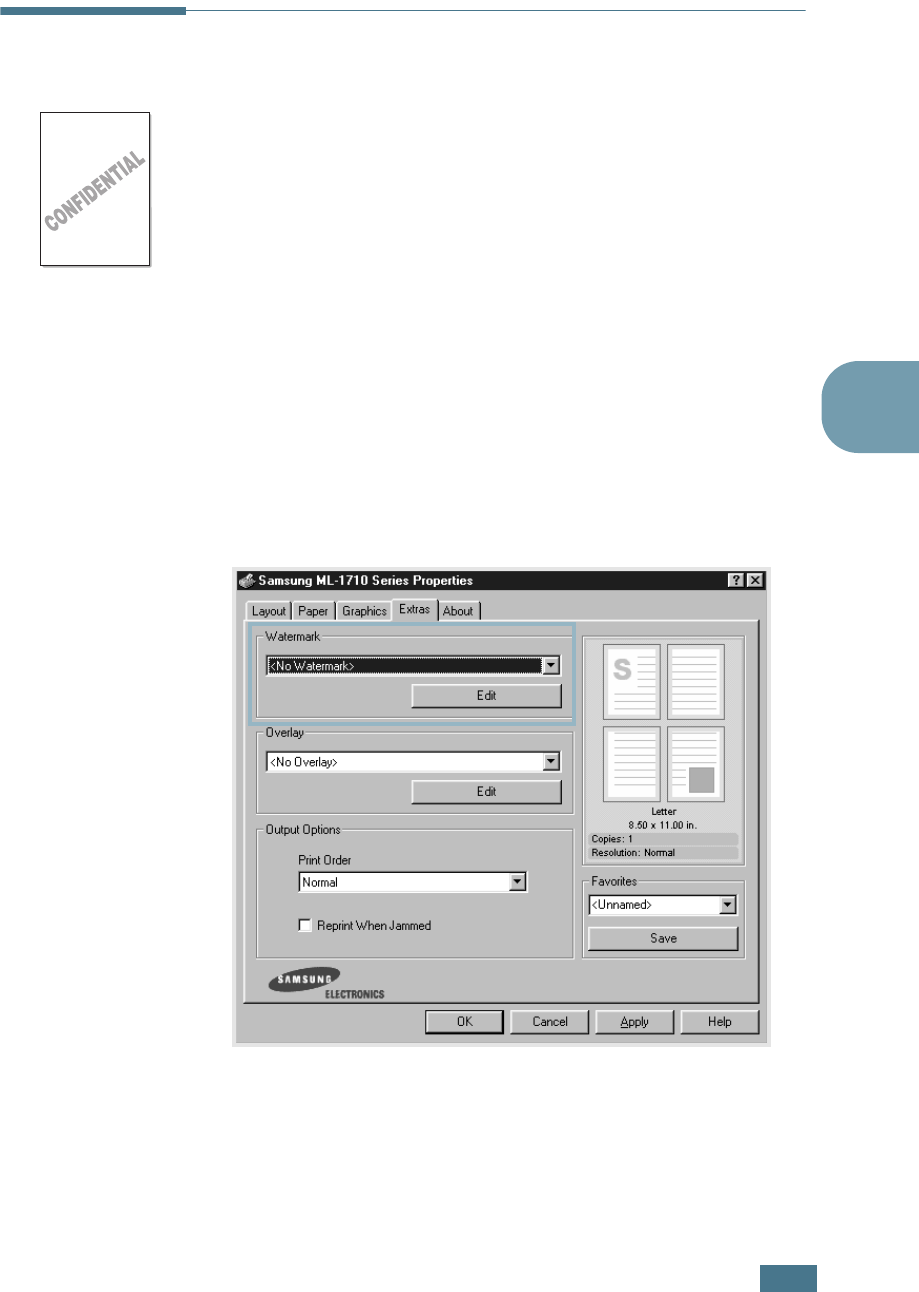
P
RINTING
T
ASKS
4.19
4
Printing Watermarks
The Watermark option allows you to print text over an existing
document. For example, you may want to have large gray letters
reading “DRAFT” or “CONFIDENTIAL” printed diagonally across
the first page or all pages of a document.
There are several predefined watermarks that come with the
printer, and they can be modified or you can add new ones to
the list.
Using an existing Watermark
1
When you change the print settings from your software
application, access the printer properties. See page 4.2.
2
Click the Extras tab, and select the desired watermark in
the Watermark drop-down list. You will see the selected
watermark in the preview image.
3
Click OK to start printing.
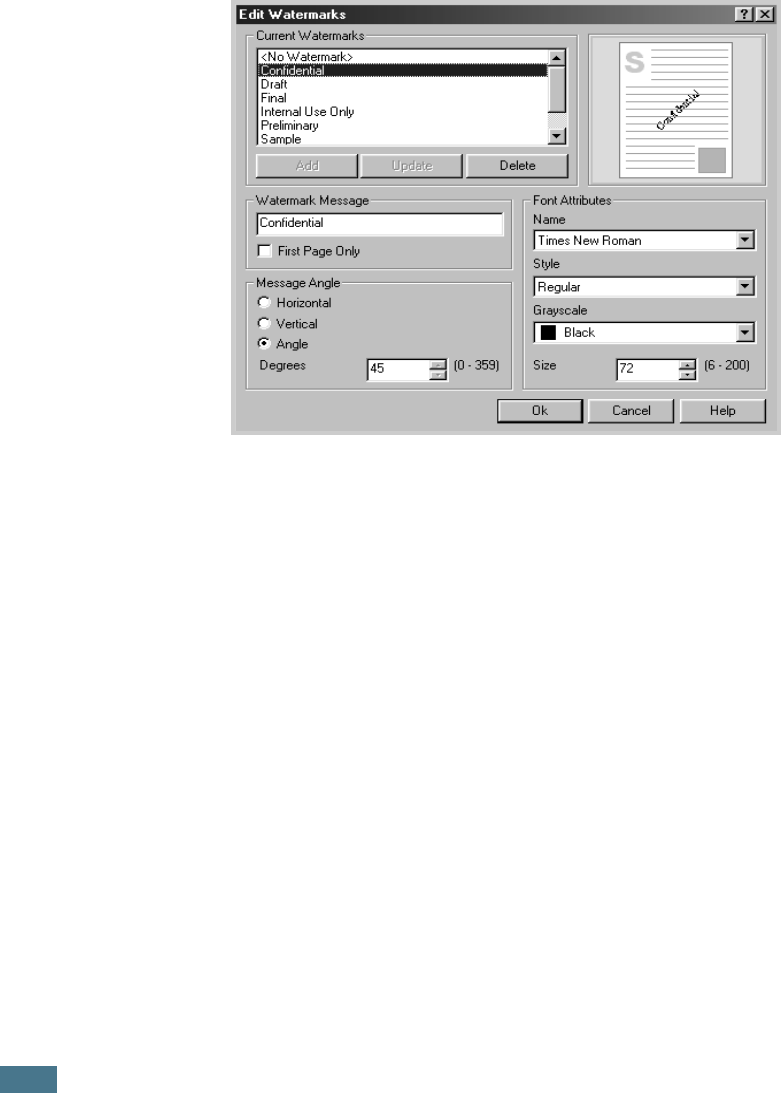
P
RINTING
T
ASKS
4.20
Creating a Watermark
1
When you change the print settings from your software
application, access the printer properties. See page 4.2.
2
Click the Extras tab, and click the Edit button in the
Watermark section. The Watermarks window appears.
3
You can enter the desired text message in the Watermark
Message box.
This will be displayed in the preview window. The preview
image is provided so that you can see how the watermark
will appear on the printed page.
If the
First Page Only
box is checked, the watermark will be
printed on the first page only.
4
Select the desired watermark options.
You can select the font type and size, and color from the
Font Attributes section, and set the angle of the
watermark from the Message Angle section.
5
Click Add to add a new watermark to the list.
6
When you complete editing, click OK and start printing.
To stop printing the watermark, select <No Watermark> in the
Watermark drop-down list.

P
RINTING
T
ASKS
4.21
4
Editing a Watermark
1
When you change the print settings from your software
application, access the printer properties. See page 4.2.
2
Click the Extras tab, and click the Edit button in the
Watermark section. The Watermarks window appears.
3
Select the watermark you want to edit in the Current
Watermarks list, and change the watermark message and
the options. Refer to “Creating a Watermark” on page 4.20.
4
Click Update to save the changes.
5
Click OK.
Deleting a Watermark
1
When you change the print settings from your software
application, access the printer properties. See page 4.2.
2
From the Extras tab, click the Edit button in the
Watermark section.
3
Select the watermark you want to delete in the Current
Watermarks list, and click Delete.
4
Click OK.
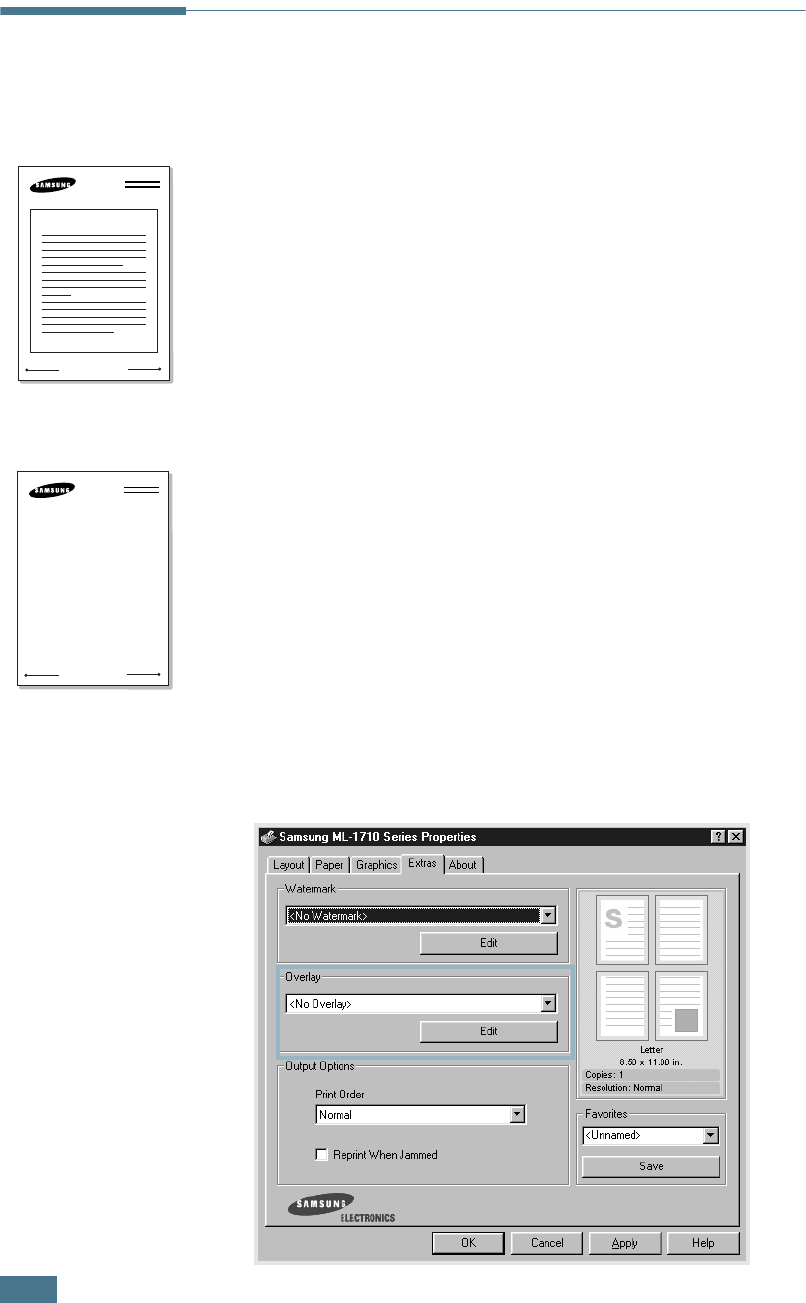
P
RINTING
T
ASKS
4.22
Printing Overlays
What is an Overlay?
An overlay is text and/or images stored in the computer hard
disk drive(HDD) as a special file format that can be printed on
any document. Overlays are often used to take the place of
preprinted forms and letterhead paper. Rather than using
preprinted letterhead, you can create an overlay containing the
exact same information that is currently on your letterhead. To
print a letter with your company’s letterhead, you do not need
to load preprinted letterhead paper in the printer. You need only
tell the printer to print the letterhead overlay on your document.
Creating a New Page Overlay
To use a page overlay, you must create a new page overlay
containing your logo or image.
1
Create or open a document containing text or an image for
use in a new page overlay. Position the items exactly as you
wish them to appear when printed as an overlay. If needed,
save the file for later use.
2
When you change the print settings from your software
application, access the printer properties. See page 4.2.
3
Click the Extras tab, and click Edit button in the Overlay
section.
WORLD BEST
Dear ABC
Regards
WORLD BEST
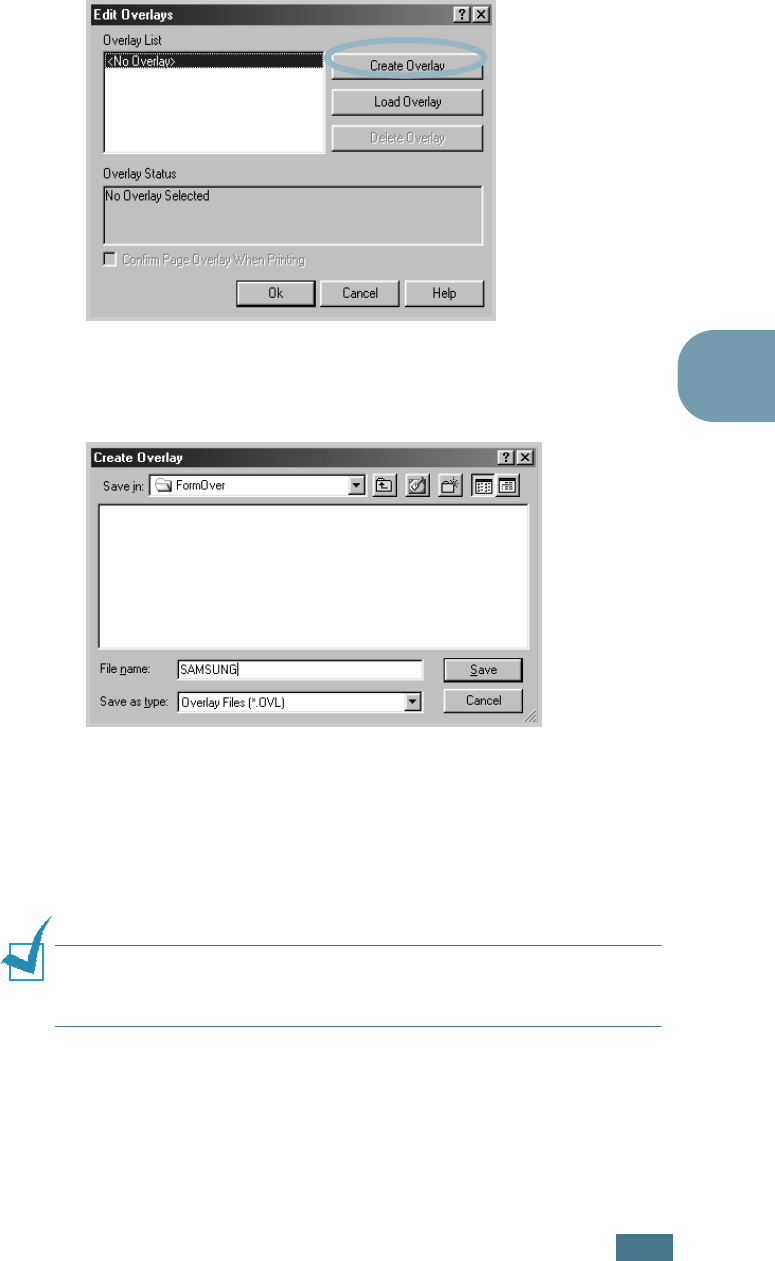
P
RINTING
T
ASKS
4.23
4
4
In the Overlays window, click Create Overlay.
5
In the Create Overlay window, type a name of up to eight
characters in the File name box. Select the destination
path, if necessary. (The default is C:\Formover).
6
Click Save. You will see the name in the Overlay List.
7
Click OK or Yes until you complete creating.
The file is not printed out. Instead it will be stored on your
computer HDD disk.
Note: The overlay document size must be the same as documents
you will print with the overlay. Do not create an overlay with a
watermark.
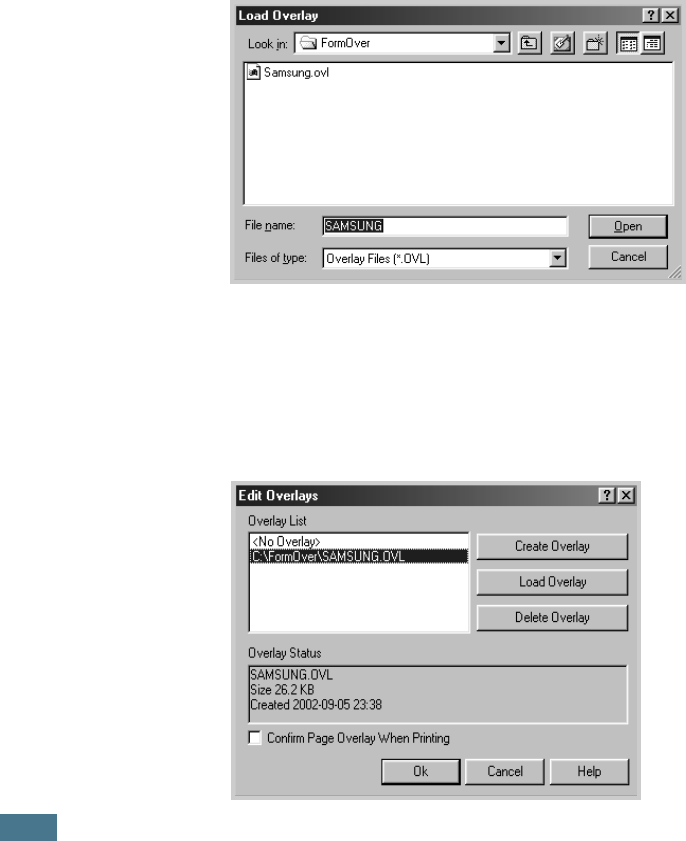
P
RINTING
T
ASKS
4.24
Using a Page Overlay
After an overlay has been created, it is ready to be printed with
your document. To print an overlay with a document:
1
Create or open the document you want to print.
2
When you change the print settings from your software
application, access the printer properties. See page 4.2.
3
Click the Extras tab.
4
Select the desired overlay from the Overlay drop-down list
box.
5
If the desired overlay file does not appear in the Overlay
list, click Edit button and Load Overlay, and select the
overlay file.
If you have stored the overlay file you want to use into an
external source, you can also load the file when you access
the Load Overlay window.
After you select the file, click Open. The file is now shown
in the Overlay List box and is available for printing. Select
the overlay from the Overlay List box.

P
RINTING
T
ASKS
4.25
4
6
If necessary, click Confirm page Overlay When Printing.
If this box is checked, a message window will appear each
time you submit a document for printing, asking you to
confirm your wish to print an overlay on your document.
Answering Yes to the window means that the selected
overlay will be printed with your document. Answering No
to the window cancels overlay printing.
If this box is empty and an overlay has been selected, the
overlay will be automatically printed with your document.
7
Click OK or Yes until the printing starts.
The selected overlay will be downloaded with your print job
and printed on your document.
Note: The resolution of the overlay document must be the same
as that of the document you will print with the overlay.
Deleting a Page Overlay
You can delete page overlays that are no longer used.
1
In the printer properties window, click the Extras tab.
2
Click Edit in the Overlay section.
3
Select the overlay you want to delete from the Overlay
List box.
4
Click Delete Overlay.
5
Click OK until you exit the Print window.
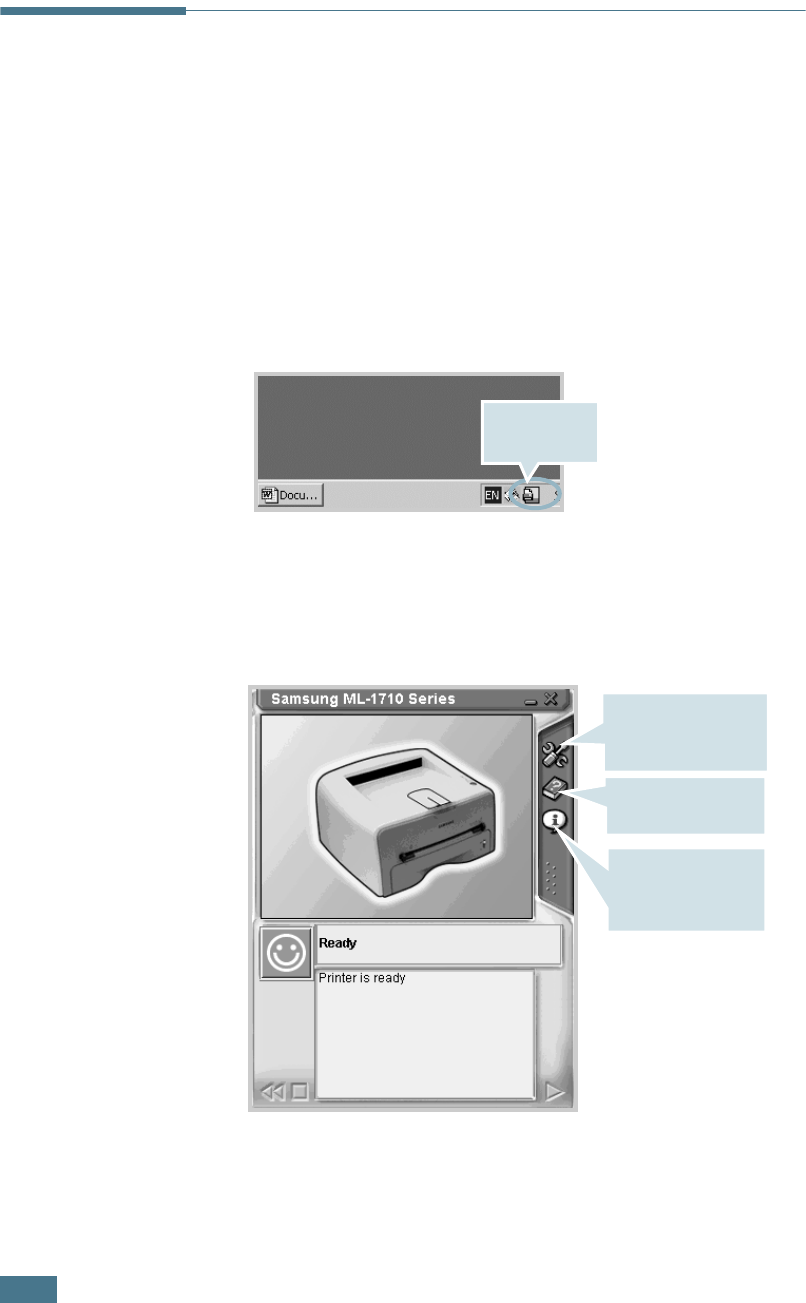
P
RINTING
T
ASKS
4.26
Using the Status Monitor
If you installed the Status Monitor software, you can check the
current status of the printer whenever you want. If an error
occurs in your printer, the Status Monitor window appears,
showing the error.
Opening the Status Monitor
1
Double click the Status monitor icon on the Windows task
bar.
Or, select Programs from Start, Samsung ML-1710 Series ,
and Samsung Printer Status Monitor.
2
The Samsung ML-1710 Series Status monitor window
appears.
Double click
this icon.
You can change the
Status Monitor
program setting.
To use Help, click
this icon.
You can check the
version of the
Status Monitor.
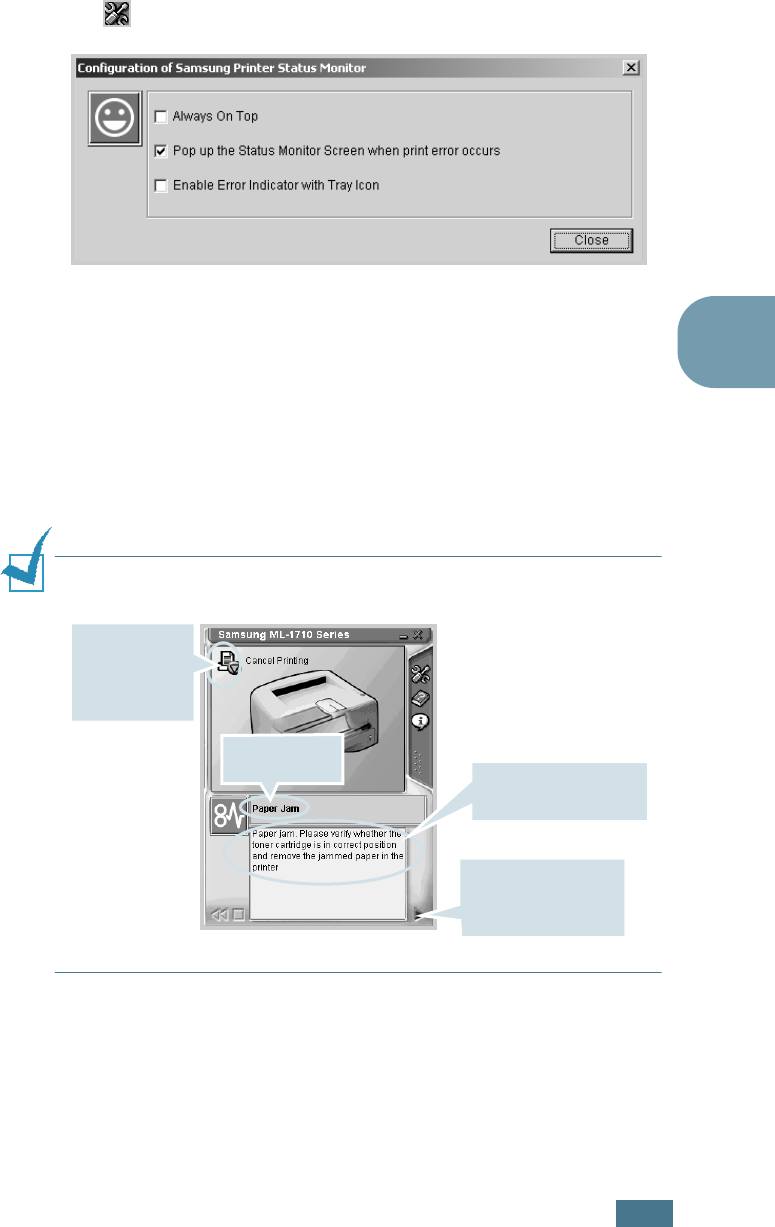
P
RINTING
T
ASKS
4.27
4
Changing the Status Monitor Program Setting
From the Status Monitor window if you click the configuration
icon , you can see the following window.
• Always On Top always shows the Status monitor window on
the top of the window regardless opening other programs.
• Pop up the Status Monitor Screen when print error
occurs shows the Status monitor window when an error
occurs in the printer.
• Enable Error Indicator with Tray icon shows the blinking
tray icon which indicates an error occurs in your printer.
Note: When the Status monitor window appears to indicate an
error, you can see the corresponding solution.
Error message
is displayed.
Click this to see the
video clip of the
solution.
To solve the problem,
follow this solution.
Click this icon
to cancel the
current print
job.

P
RINTING
T
ASKS
4.28
Setting Up Locally Shared Printer
You can connect the printer directly to a selected computer,
which is called “host computer”, on the network. The printer can
be shared by other users on the network through a Windows 98,
Me, 2000 or XP network printer connection.
Windows 98/Me
Setting Up Host Computer
1
Start Windows.
2
From the Start menu, select Control Panel, and double-
click on the Network icon.
3
Check the File and Print Sharing box, and click OK.
4
Click Start and select Printers from Settings, and double-
click your printer name.
5
Select Properties in the Printer menu.
6
Click the Sharing tab, and check the Shared As box. Fill in
the Shared Name field, and then click OK.
Setting Up Client PC
1
Right-click Start, and select Explorer.
2
Open your network folder in the left column.
3
Right-click the shared name, and select Capture Printer
Port.
4
Select the port you want, check the Reconnect at log on
box, and then click OK.
5
From the Start menu, select Settings and Printers.
6
Double-click your printer icon.
7
From the Printer menu, select Properties.
8
Press the Details tab, select the printer port, and click OK.

P
RINTING
T
ASKS
4.29
4
Windows 2000/XP
Setting Up Host Computer
1
Start Windows.
2
From the Start menu, select Settings and Printers.
(Windows 2000)
From the Start menu, select Printers and Faxes.
(Windows XP)
3
Double-click your printer icon.
4
From the Printer menu, select Sharing.
5
Check the Shared As box. (Windows 2000)
Check the Share this printer box. (Windows XP)
Fill in the Shared Name field, and then click OK.
Setting Up Client PC
1
Right-click Start, and select Explorer.
2
Open your network folder in the left column.
3
Click the shared name.
4
From the Start menu, select Settings and Printers.
(Windows 2000)
From the Start menu, select Printers and Faxes.
(Windows XP)
5
Double-click your printer icon.
6
From the Printer menu, select Properties.
7
Press the Ports tab, and click Add Port.
8
Select Local Port, and click New Port.

P
RINTING
T
ASKS
4.30
9
Fill in the Enter a port name field, and enter the shared
name.
10
Click OK, and click Close.
11
Click Apply, and click OK.

5
This chapter provides suggestions for maintaining the toner
cartridge and the printer.
This chapter includes:
• Maintaining the Toner Cartridge
• Cleaning the Printer
• Consumables and Replacement Parts
Maintaining Your Printer

M
AINTAINING
Y
OUR
P
RINTER
5.2
Maintaining the Toner Cartridge
Toner cartridge storage
To get the maximum results from the toner cartridge, keep the
following guidelines in mind.
• Do not remove the toner cartridge from its package until ready
for use.
• Do not refill the toner cartridge. The printer warranty does
not cover damage caused by using a refilled cartridge.
• Store toner cartridges in the same environment as the printer.
• To prevent damage to the toner cartridge, do not expose it to
light for more than a few minute.
Toner cartridge life expectancy
The life of the toner cartridge depends on the amount of toner
that print jobs require. When printing text at 5% coverage, a
new toner cartridge lasts an average of 3,000 pages. (The
original toner cartridge supplied with the printer lasts an
average of 1,000 pages.)
Saving toner
To save toner, press the Cancel button on the printer control
panel. The button will be lit. You can also enable the Toner Save
in the printer properties. Refer to “Using the Toner Save Mode”
on page 4.8. Selecting this option will extend the life of the toner
cartridge and reduce your cost per page, but will reduce the
print quality.
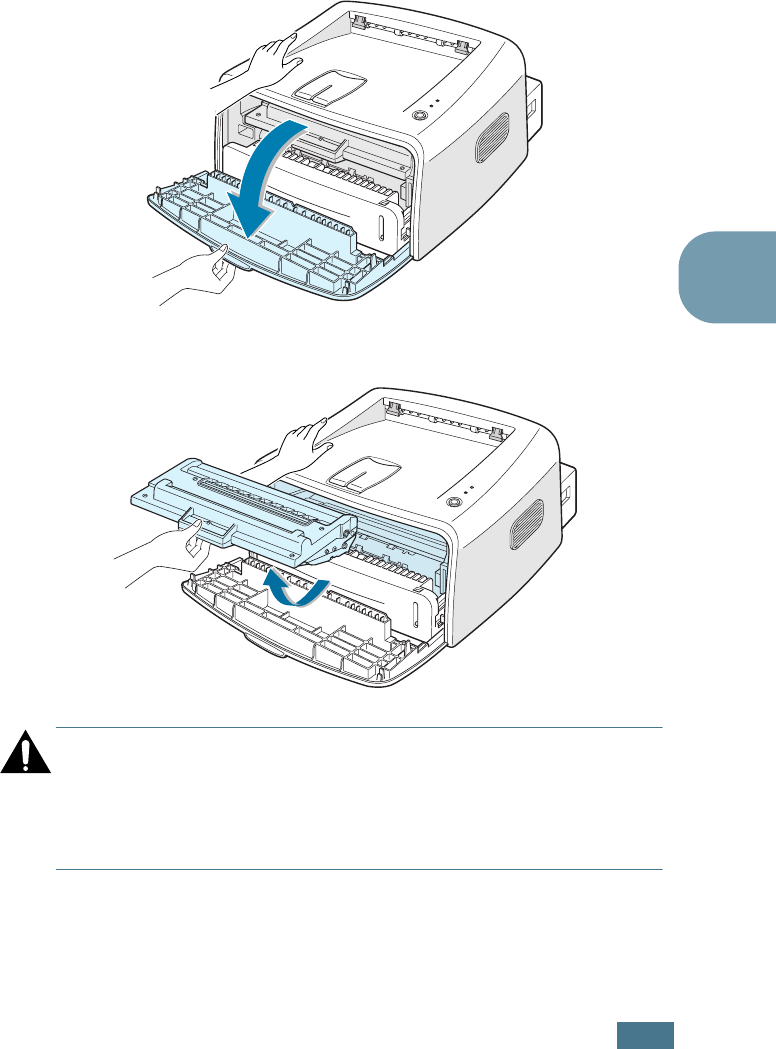
M
AINTAINING
Y
OUR
P
RINTER
5.3
5
Redistributing Toner
When toner is low, faded or light areas may appear on a printed
page. You may be able to temporarily improve the print quality
by redistributing the toner. The following procedures may allow
you to finish the current print job before replacing the toner
cartridge.
1
Grasp the front cover and pull it toward you to open.
2
Remove the toner cartridge from the printer.
Caution:
• Avoid reaching too far into the printer. The fusing area may be
hot.
• To prevent damage to the toner cartridge, do not expose it to
light for more than a few minutes.
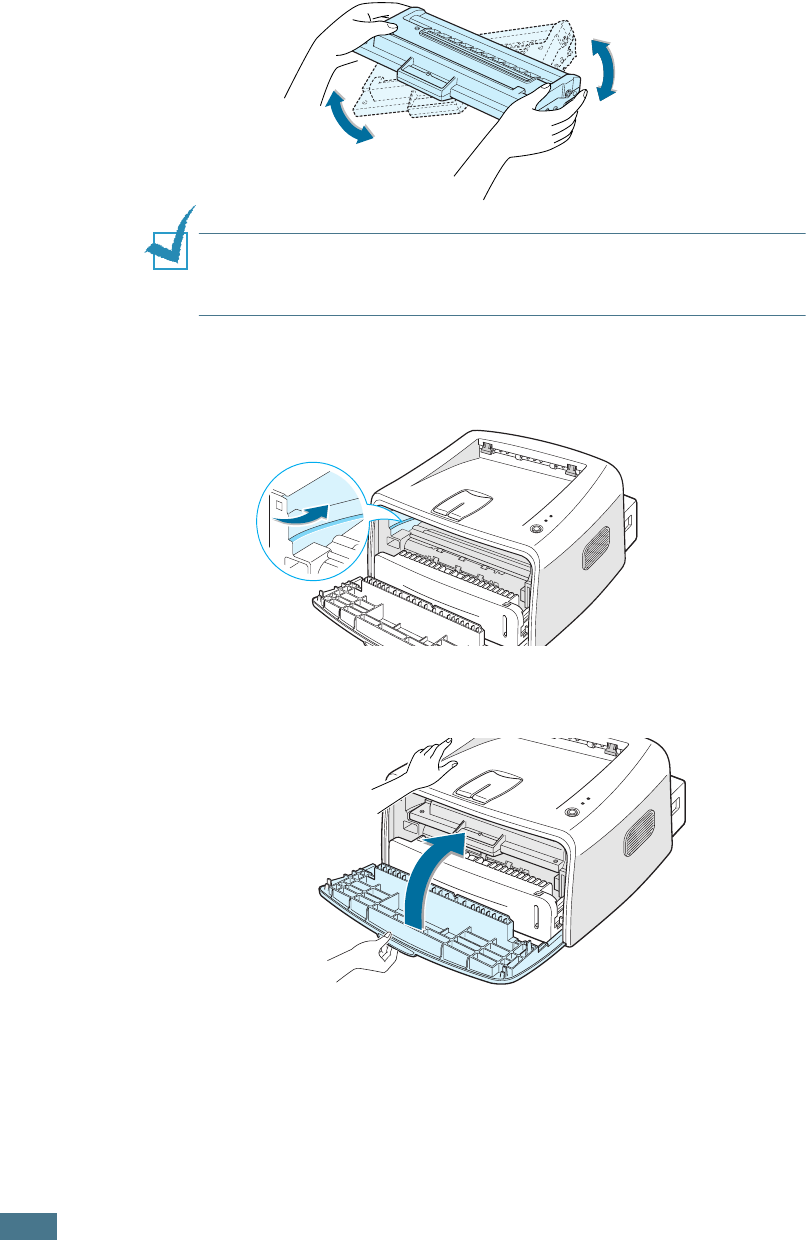
M
AINTAINING
Y
OUR
P
RINTER
5.4
3
Gently shake the toner cartridge from side to side five or six
times to redistribute the toner.
Note:
If the toner gets on your clothing, wipe it off with a dry
cloth and wash clothing in cold water. Hot water sets toner into
fabric.
4
Reinsert the toner cartridge into the printer. Ensure that the
toner cartridge snaps into place.
5
Close the front cover. Make sure that the cover is securely
closed.
Replacing the Toner Cartridge
If the print remains light after redistributing toner (see
page 5.3), replace the toner cartridge.
Remove the old cartridge and install a new toner cartridge. See
“Installing the Toner Cartridge” on page 2.4.
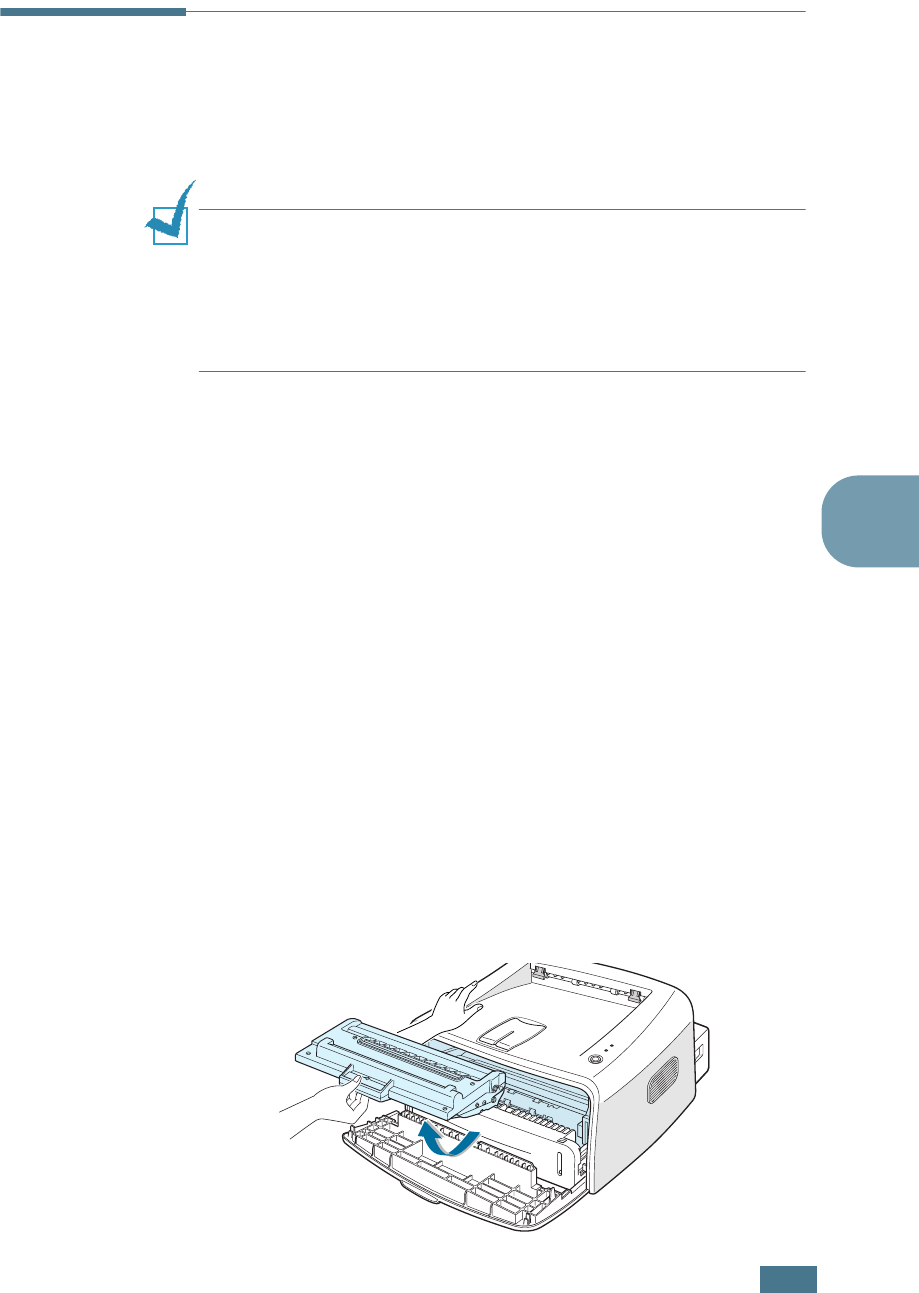
M
AINTAINING
Y
OUR
P
RINTER
5.5
5
Cleaning the Printer
To maintain the print quality, follow the cleaning procedures
below each time the toner cartridge is replaced or if print quality
problems occur.
Notes:
• Do not use ammonia-based cleaners or volatile solvents, such as
thinner, on or around the printer. These can damage the printer.
• While cleaning the inside of the printer, be careful not to touch
the transfer roller (located underneath the toner cartridge). Oil
from your fingers can cause print quality problems.
Cleaning the Outside
Wipe the outside surface of the printer with a soft, clean, lint-
free cloth. You can dampen the cloth slightly with water, but be
careful not to be let any water drip onto the printer or inside of
it.
Cleaning the Inside
During the printing process, paper, toner, and dust particles can
accumulate inside the printer. This buildup can cause print
quality problems, such as toner specs or smearing. Cleaning the
inside of the printer will eliminate or reduce these problems.
Cleaning inside the printer
1
Turn the printer off and unplug the power cord, then wait
for the printer to cool.
2
Open the front cover and remove the toner cartridge.
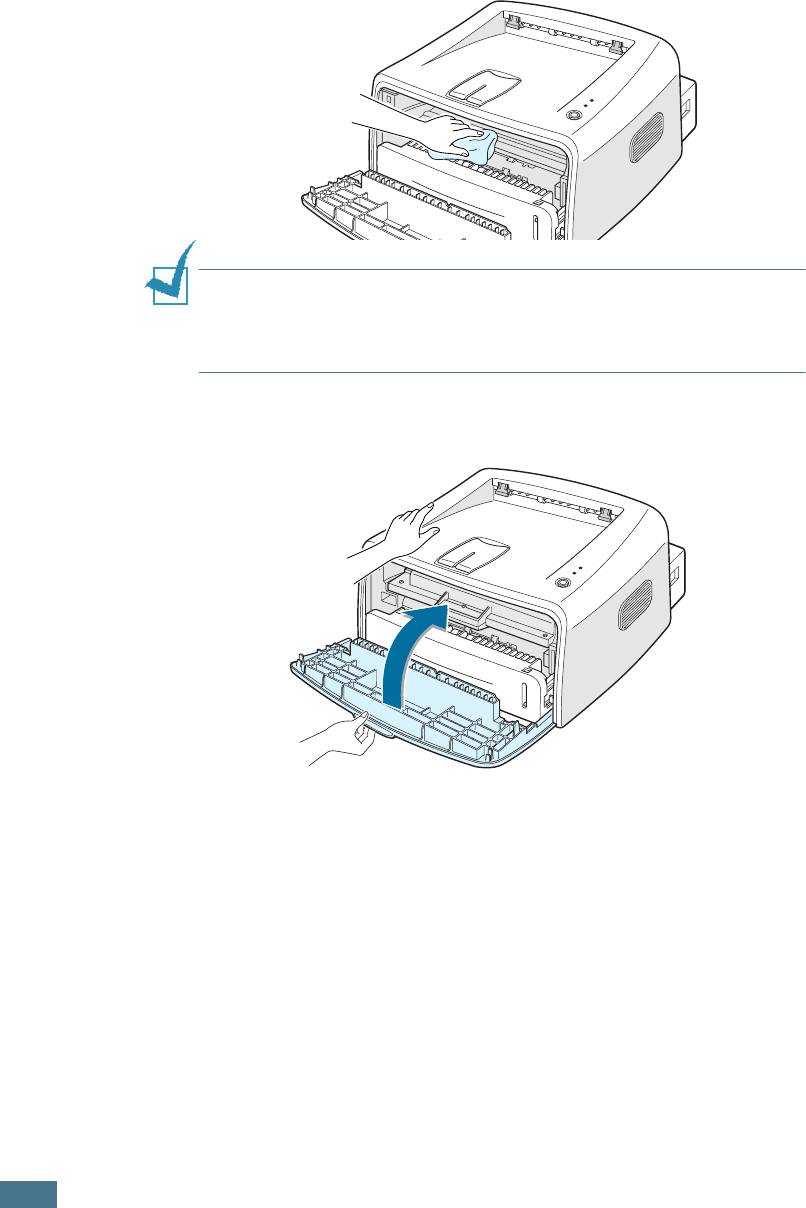
M
AINTAINING
Y
OUR
P
RINTER
5.6
3
With a dry, lint-free cloth, wipe away any dust and spilled
toner from the toner cartridge area and the toner cartridge
cavity.
Note: To prevent damage to the toner cartridge, do not expose it
to light for more than a few minute. Cover it with a piece of paper,
if necessary. Also, do not touch the black transfer roller inside the
printer.
4
Reinsert the toner cartridge and close the cover.
5
Plug in the power cord, and turn the printer on.
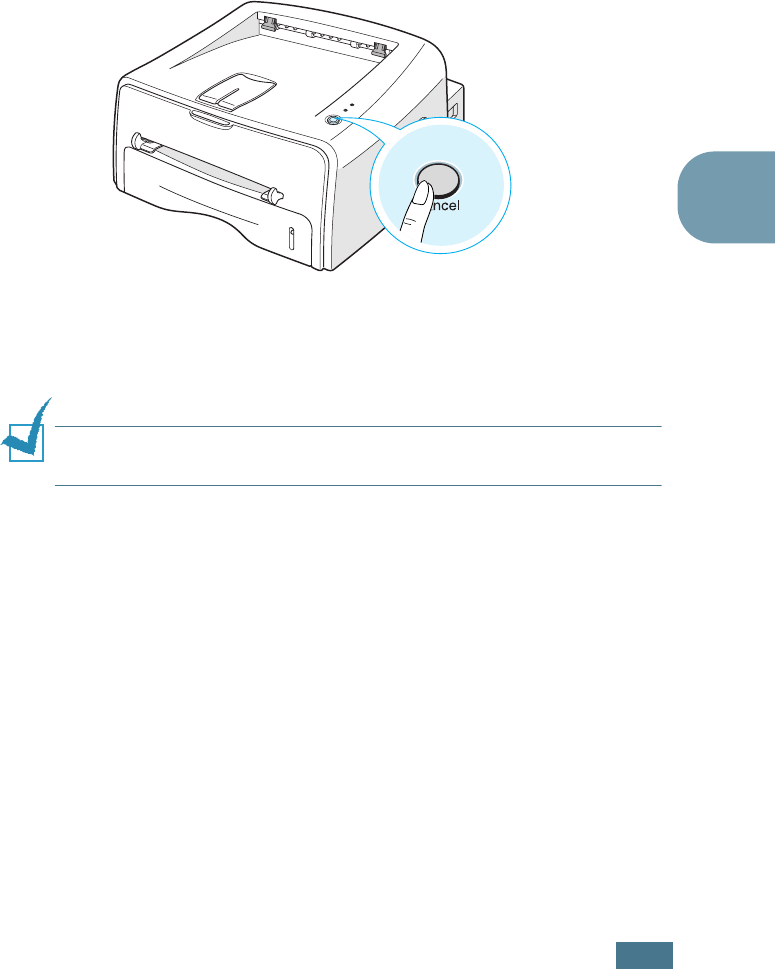
M
AINTAINING
Y
OUR
P
RINTER
5.7
5
Printing a cleaning sheet
If you are experiencing blurred, faded or smeared printouts.
Printing a cleaning sheet cleans the drum inside the toner
cartridge. This process will produce a page with toner debris,
which should be discarded.
1
Ensure that the printer is turned on and in the Ready mode
with paper loaded in the tray.
2
Press and hold down the Cancel button on the control
panel for about 10 seconds.
3
Your printer automatically picks up a sheet of paper from
the tray and prints out a cleaning sheet with dust or toner
particles on it.
Note: The cartridge cleaning process takes some time. To stop
printing, turn the power off.
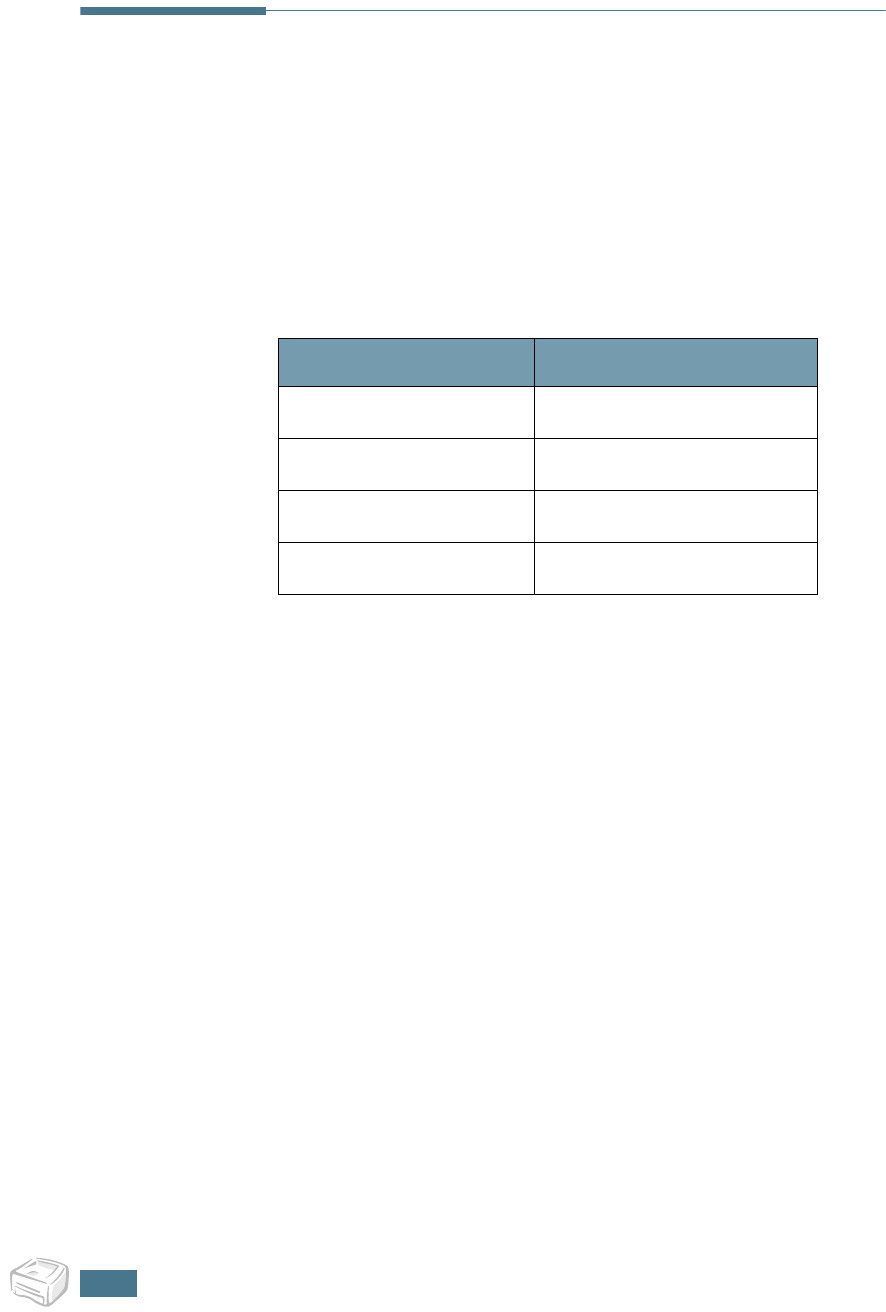
M
AINTAINING
Y
OUR
P
RINTER
5.8
Consumables and Replacement
Parts
From time to time, you will need to replace the roller and fuser
unit to maintain top performance and avoid print quality
problems and paper feed problems resulting from worn parts.
The following items should be replaced after you have printed a
specified number of pages. See the table below.
The purchase the consumables and replacement parts, contact
Samsung dealer or the place where you bought your product.
We strongly recommend that items be installed by a trained
service.
Items Yield (Average)
Paper Feeding Roller 60,000
Transfer Roller 60,000
Pick-up roller 60,000
Fuser Unit 60,000

6
This chapter provides helpful information for what to do if
you encounter an error while using your printer.
This chapter includes:
• Troubleshooting Checklist
• Solving General Printing Problems
• Clearing Paper Jams
• Solving Print Quality Problems
• Troubleshooting Error Messages
• Common Windows Problems
• Common Macintosh Problems
• Common Linux Problems
Solving Problems
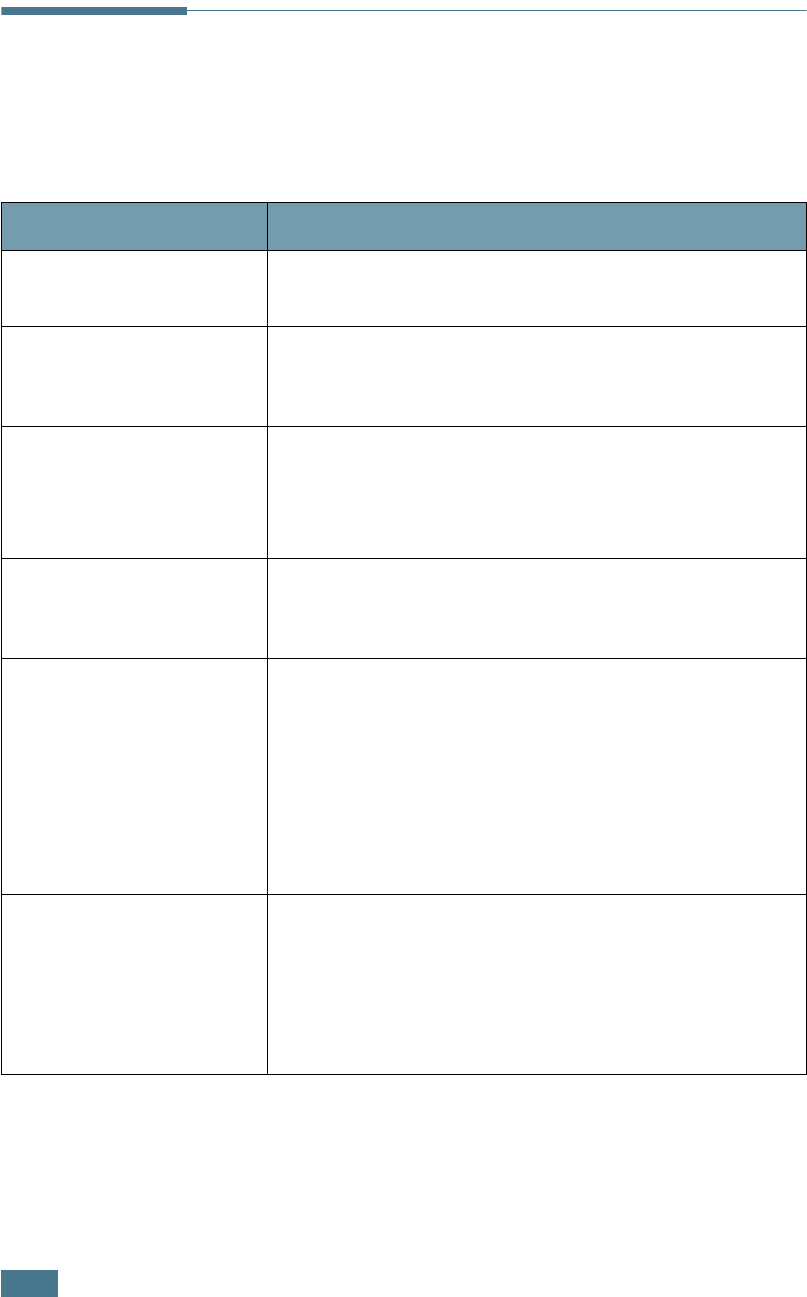
S
OLVING
P
ROBLEMS
6.2
Troubleshooting Checklist
If the printer is not working properly, consult the following
checklist. If the printer does not pass a step, follow the
corresponding troubleshooting suggestions.
Check Solution
Check the power cord
and the power switch.
Check the power source by plugging into another
outlet.
Make sure that the
On
Line/Error
LED is on.
In the Ready mode, the
On Line/Error
LED lights
green. If the
On Line/Error
LED lights red or blinks,
go to “Troubleshooting Error Messages” on page 6.17.
Press and hold the
Cancel
button to print a
demo page.
• If a demo page does not print, check the paper
supply in the input tray.
• If the paper jams in the printer, go to “Clearing Paper
Jams” on page 6.7.
Check the demo page to
see if it is printed
correctly.
If there is a print quality problem, go to “Solving Print
Quality Problems” on page 6.11.
Print a short document
from a software
application to verify that
the computer and printer
are connected and are
communicating correctly.
• If the page does not print, check the cable connection
between the printer and the computer.
• Check the print queue or print spooler to see if the
printer has been paused.
• Check the software application to insure you are
using the proper printer driver and communication
port. If the page is interrupted during printing, go to
“Solving General Printing Problems” on page 6.3.
If completing the
checklist does not
resolve the printer
problem, check the
following troubleshooting
sections.
• “Solving General Printing Problems” on page 6.3.
• “Troubleshooting Error Messages” on page 6.17.
• “Common Windows Problems” on page 6.18.
• “Common Macintosh Problems” on page 6.19.
• “Common Linux Problems” on page 6.20.
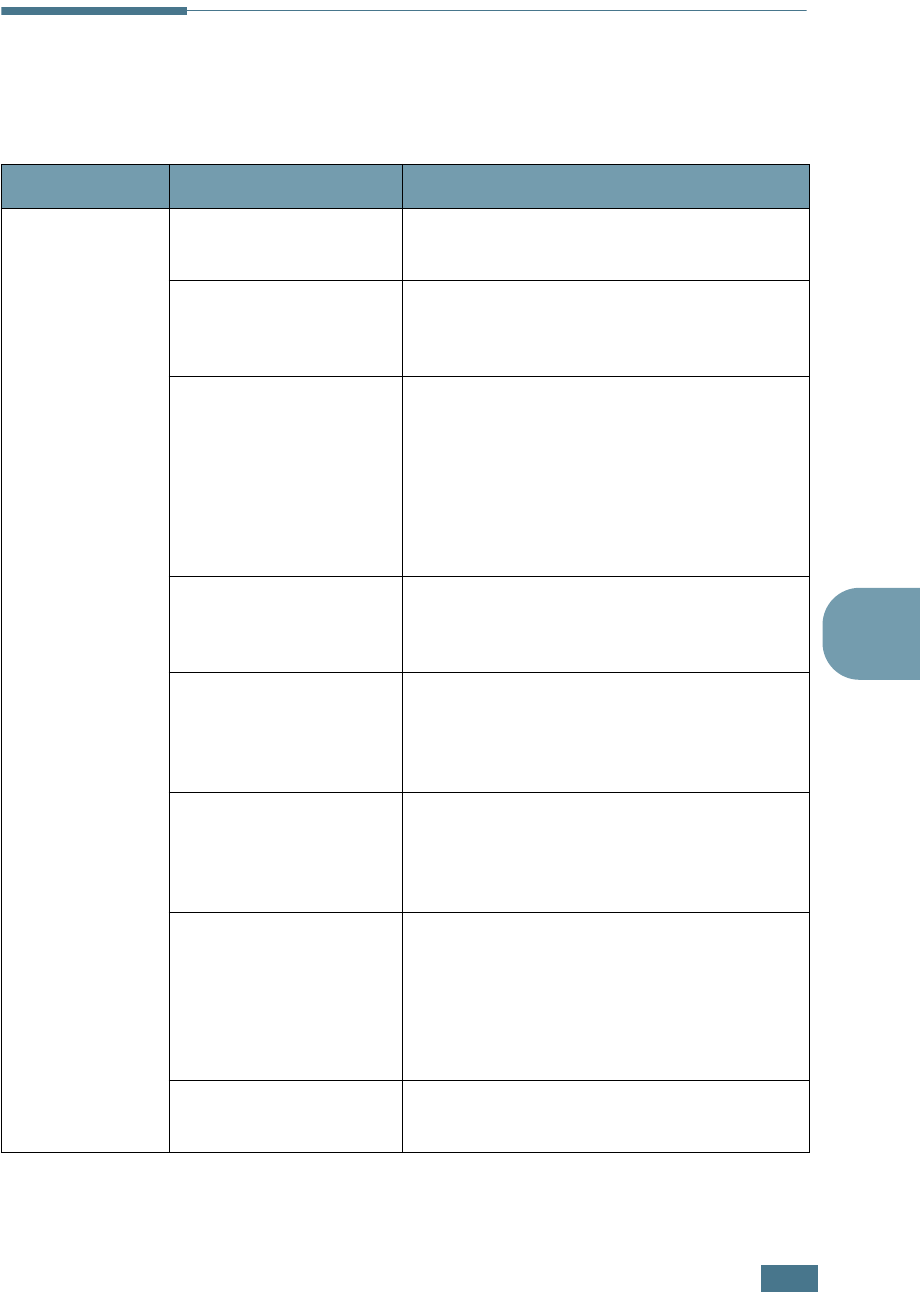
S
OLVING
P
ROBLEMS
6.3
6
Solving General Printing Problems
For problems with the operation of your printer, refer to the table
for suggested solutions.
Problem Possible Cause Solution
The Printer
does not print
The printer is not
receiving power.
Check the power cord connections. Check
the power switch and the power source.
The printer is not
selected as the default
printer.
Select Samsung ML-1710 Series in the
Printer folder in Windows as your default
printer.
Check the printer for
the following:
• The printer cover is not closed.
• Paper is jammed.
• No paper is loaded.
• The toner cartridge is not installed.
If a printer system error occurs, contact
your service representative.
The printer may be in
Manual Feed mode.
Add paper to the manual feeder and
press the Cancel button on the printer’s
control panel to begin printing.
The connection cable
between the computer
and the printer is not
connected properly.
Disconnect the printer cable and
reconnect it.
The connection cable
between the computer
and the printer is
defective.
If possible, attach the cable to another
computer that is working properly and
print a job. You can also try using a
different printer cable.
The port setting is
incorrect.
Check the Windows printer setting to
make sure that the print job is sent to the
correct port (for example, LTP1). If the
computer has more than one port, make
sure that the printer is attached to the
correct one.
The printer may be
configured incorrectly.
Check the printer properties to ensure
that all print settings are correct.
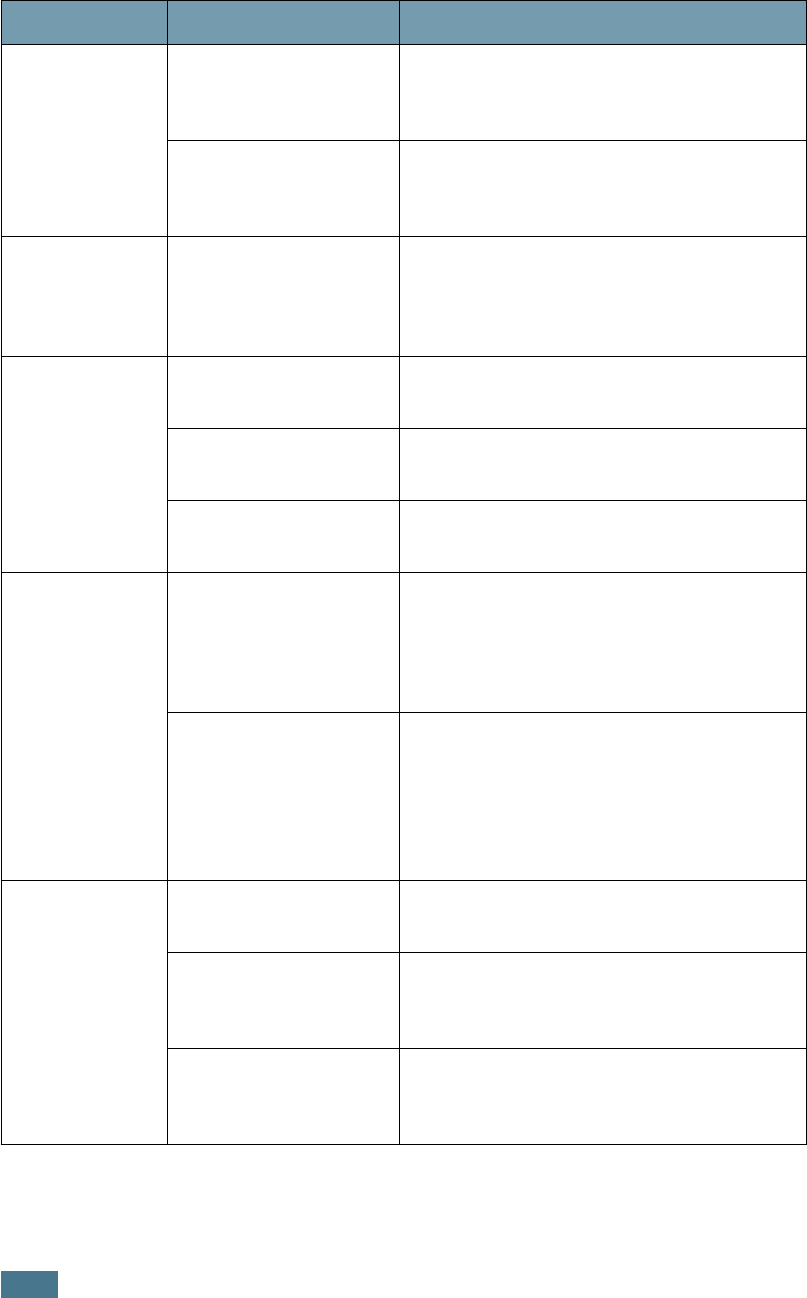
S
OLVING
P
ROBLEMS
6.4
Problem Possible Cause Solution
The printer
does not print.
(continued)
The printer driver may
be incorrectly
installed.
Reinstall the printer driver; see
page 2.11. Try printing a demo page.
The printer is
malfunctioning.
Check the LEDs on the control panel to
determine if the printer is indicating a
system error.
Printer selects
materials from
the wrong
paper source.
The paper source
selection in the printer
properties may be
incorrect.
For many software applications, the paper
source selection is found under the Paper
tab within the printer properties. Select
the correct paper source. See page 4.6.
Paper does not
feed into the
printer.
Paper has not been
loaded correctly.
Remove paper from the tray and reload it
correctly.
There is too much
paper in the tray.
Remove excess paper from the tray.
The paper is too thick. Use only paper that meets the
specifications required by the printer.
Print job is
extremely
slow.
The job may be very
complex.
Reduce the complexity of the page or try
adjusting the print quality settings.
The maximum print speed of the printer
is 16(A4) or 17(Letter) pages per minute.
If using Windows 98/
Me, the Spooling
Setting may be set
incorrectly.
From the Start menu, choose Settings
and Printers. Right-click the
Samsung
ML-1710
Se
rise printer icon, choose
Properties, click the Details tab, and
then choose the Spool Settings button.
Select the desired spool setting.
Half the page
is blank.
The page layout is too
complex.
Simplify the page layout and remove any
unnecessary graphics from the document.
The page orientation
setting may be
incorrect.
Change the page orientation in your
application.
The paper size and
the paper size settings
do not match.
Ensure that the paper size in the print
settings matches the paper in the tray.
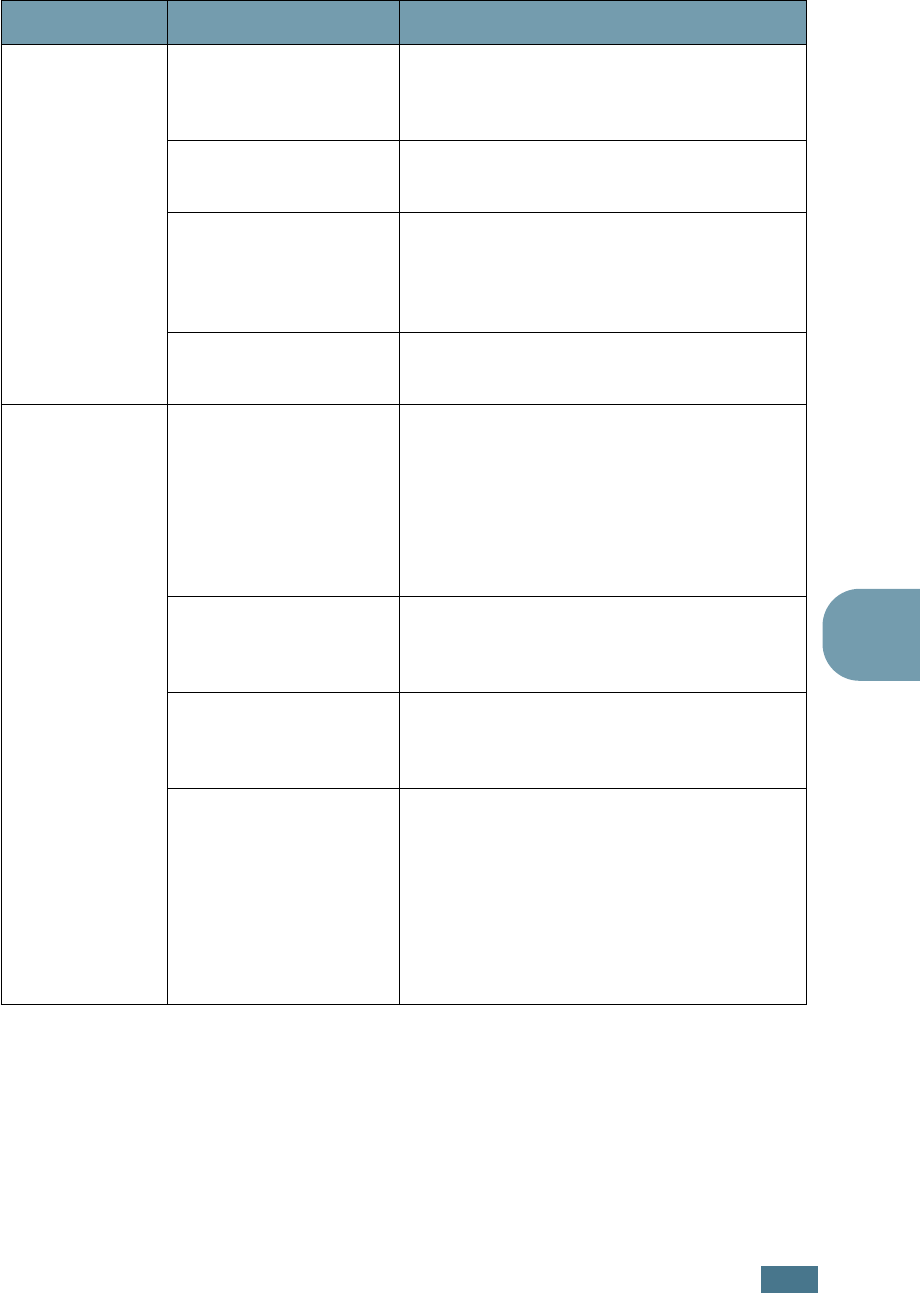
S
OLVING
P
ROBLEMS
6.5
6
The paper
keeps
jamming.
There is too much
paper in the paper
tray.
Remove excess paper from the tray.
If printing on special materials, use the
manual feeder.
An incorrect type of
paper is being used.
Use only paper that meets the
specifications required by the printer.
An incorrect output
method is being used.
Special print materials, such as thick
paper, should not be printed using the top
output tray (face-down). Use the rear
output tray (face-up) instead.
There may be debris
inside the machine.
Open the front cover and remove the
debris.
The printer
prints, but the
text is wrong,
garbled, or
incomplete.
The printer cable is
loose or defective.
Disconnect the printer cable and
reconnect. Try a print job that you have
already printed successfully. If possible,
attach the cable and printer to another
computer and try a print job that you
know works. Finally, try a new printer
cable.
The wrong printer
driver was selected.
Check the application’s printer selection
menu to ensure that your printer is
selected.
The software
application is
malfunctioning.
Try printing a job from another
application.
The operating system
is malfunctioning.
If printing from Windows (any version),
exit to a DOS prompt and verify
functionality with the following command:
At a
C:\
prompt, type
Dir LPT1
, and
press
Enter
. (This assumes you are
connected to LPT1.) Exit Windows and
reboot the computer. Turn the printer off
and then back on again.
Problem Possible Cause Solution
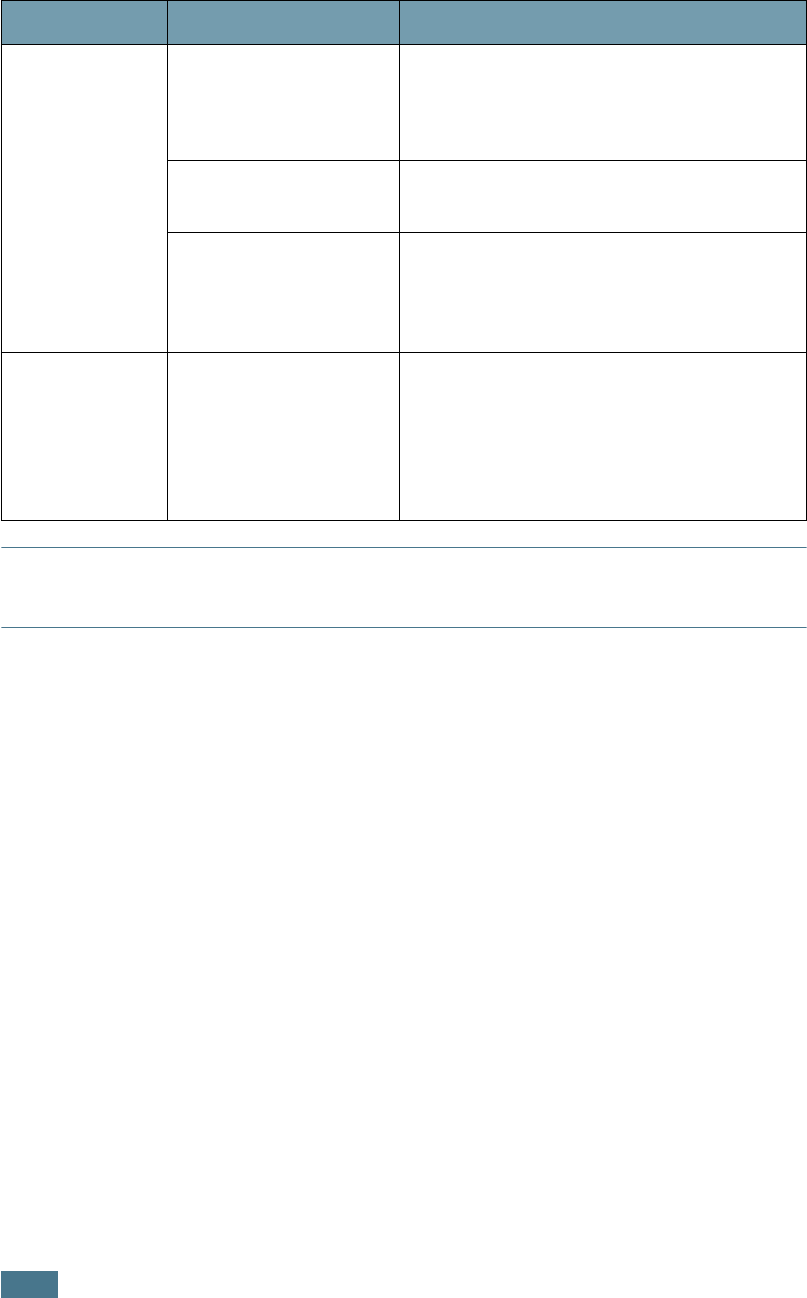
S
OLVING
P
ROBLEMS
6.6
ATTENTION:
If you have any printing problem after your printer prints about 60,000 pages, you must
contact the customer service to replace the transfer roller.
Pages print,
but are blank.
The toner cartridge is
defective or out of
toner.
Redistribute the toner, if necessary. See
page 5.3.
If necessary, replace the toner cartridge.
The file may have
blank pages.
Check the file to ensure it does not
contain blank pages.
Some parts, such as
the controller or the
board, may be
defective.
Contact a service representative.
The
illustrations
print
incorrectly in
Adobe
Illustrator.
The setting in the
software application is
wrong.
Print the document with selecting
Download as Bit Image
in the
Advanced options
of the Graphic
properties.
Problem Possible Cause Solution
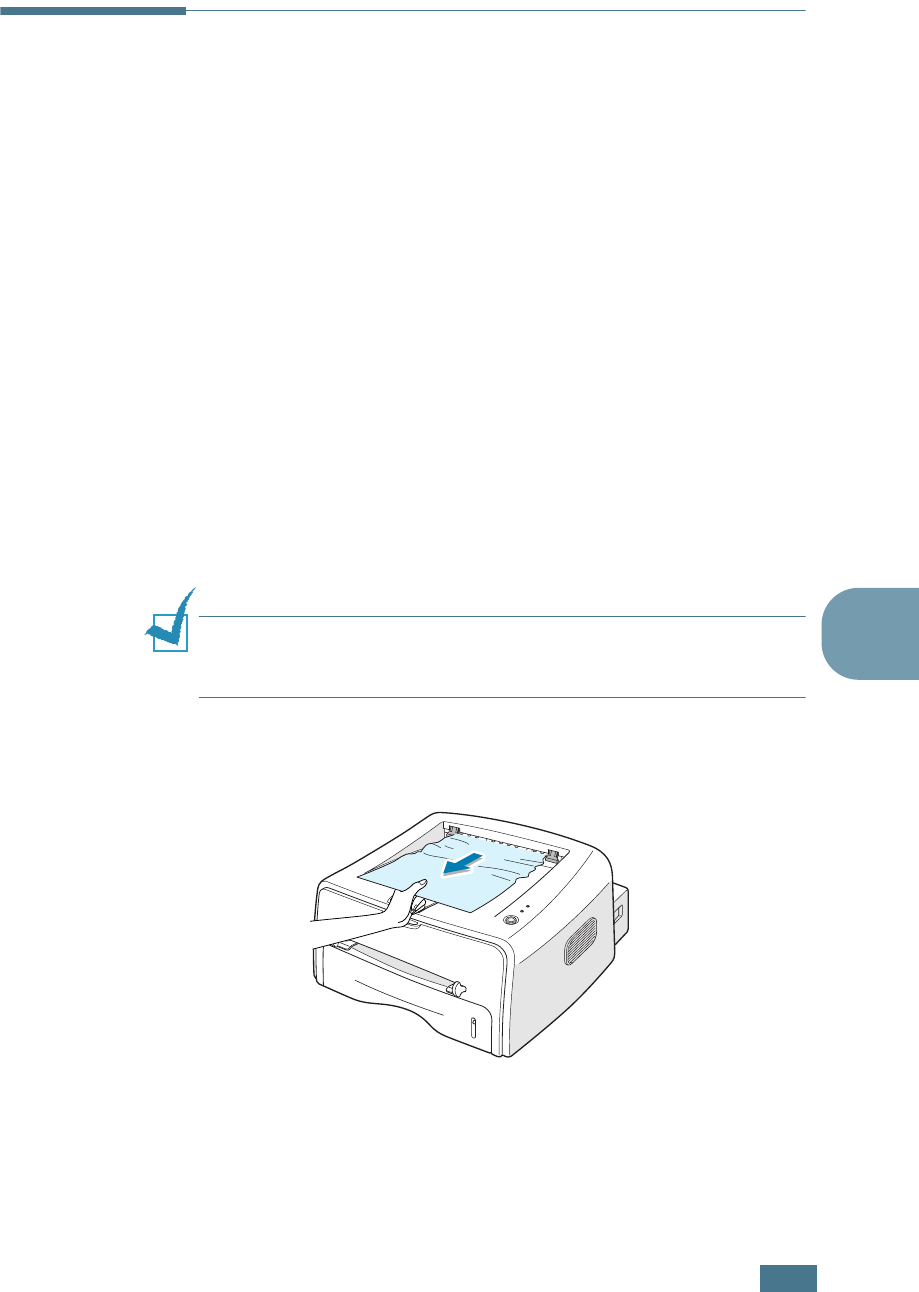
S
OLVING
P
ROBLEMS
6.7
6
Clearing Paper Jams
Occasionally, paper can be jammed during a print job. Some of
causes include:
• The tray is loaded improperly or overfilled.
• The tray has been pulled out during a print job.
• The front cover has been opened during a print job.
• Paper that does not meet paper specifications has been used.
See “Paper Specifications” on page 7.21.
• Paper that is outside of the supported size range has been
used. See “Paper Specifications” on page 7.21.
If a paper jam occurs, the On Line/Error LED on the control
panel lights red. Find and remove the jammed paper. If it is
invisible, look inside the printer.
In the Paper Exit Area
Note: Paper jams in this area may result in loose toner on the
page. If you get any toner on your clothes, wash them in cold
water as hot water will set the toner into the fabric.
1
If the paper jams as it exits to the output tray and a long
portion of the paper is visible, pull the paper straight out.
When you pull the jammed paper, if there is resistance and
the paper does not move immediately, stop pulling.
Continue with the next step.
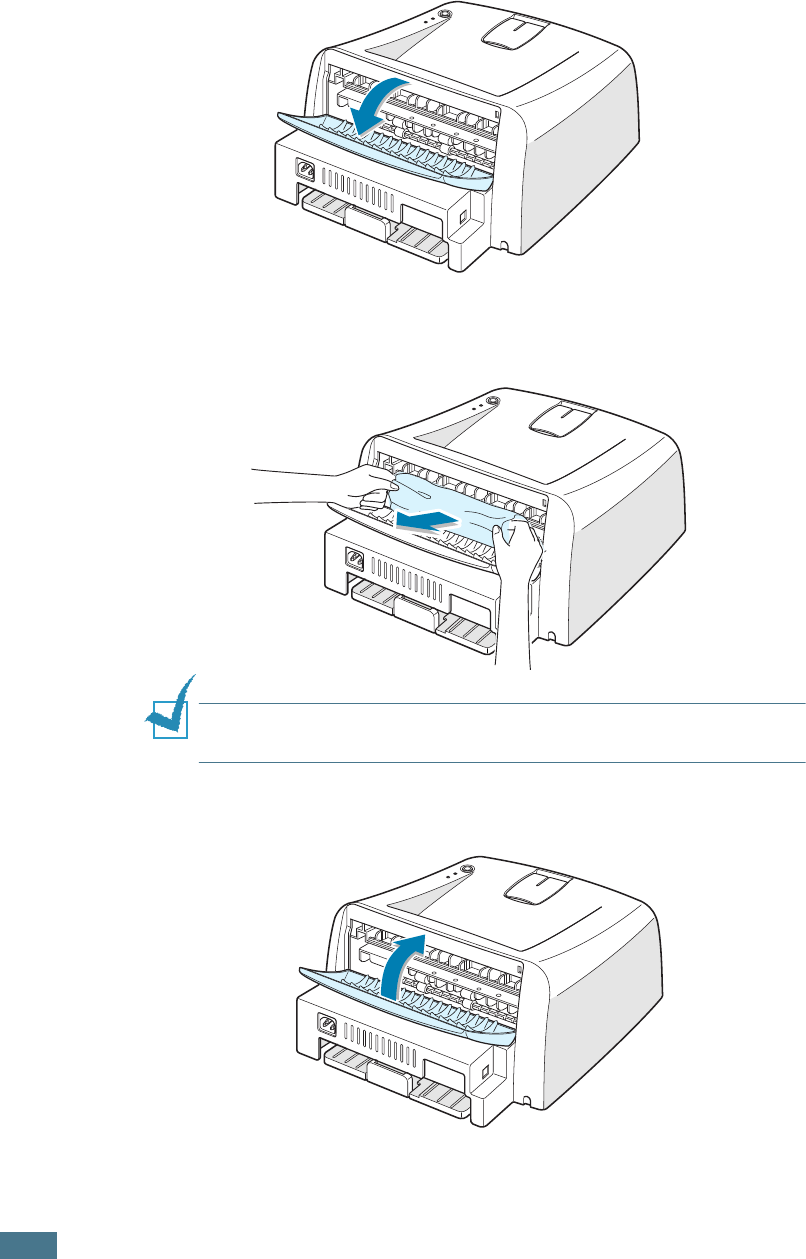
S
OLVING
P
ROBLEMS
6.8
2
Open the rear output tray.
3
Loosen the paper if it is caught in the feed rollers. Then pull
the paper gently out.
Notes: Please be careful when you open the rear cover. The inside
of the printer is still hot.
4
Close the rear output tray.
5
Open and close the front cover. Printing can be resumed.
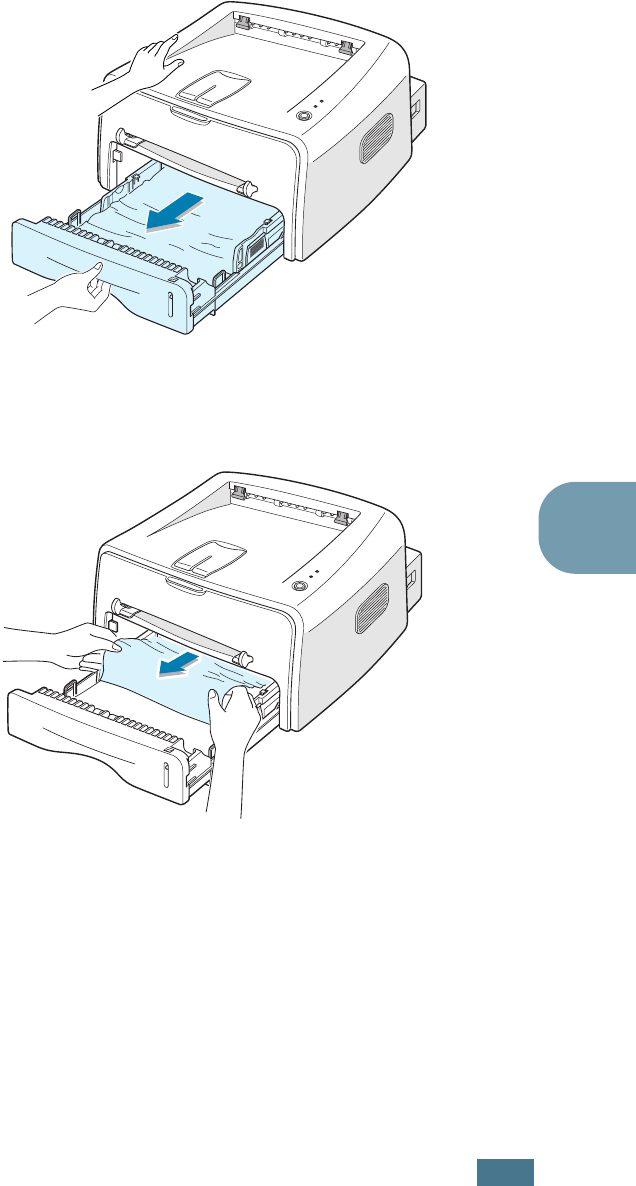
S
OLVING
P
ROBLEMS
6.9
6
In the Paper Feed Area
1
Slide out the tray to expose the jammed paper.
2
Remove any missfeed paper by pulling it out by the visible
edge from the tray. Make sure that all of the paper is
properly aligned in the tray.
3
Slide the tray back into the printer.
4
Open and close the front cover. Printing can be resumed.
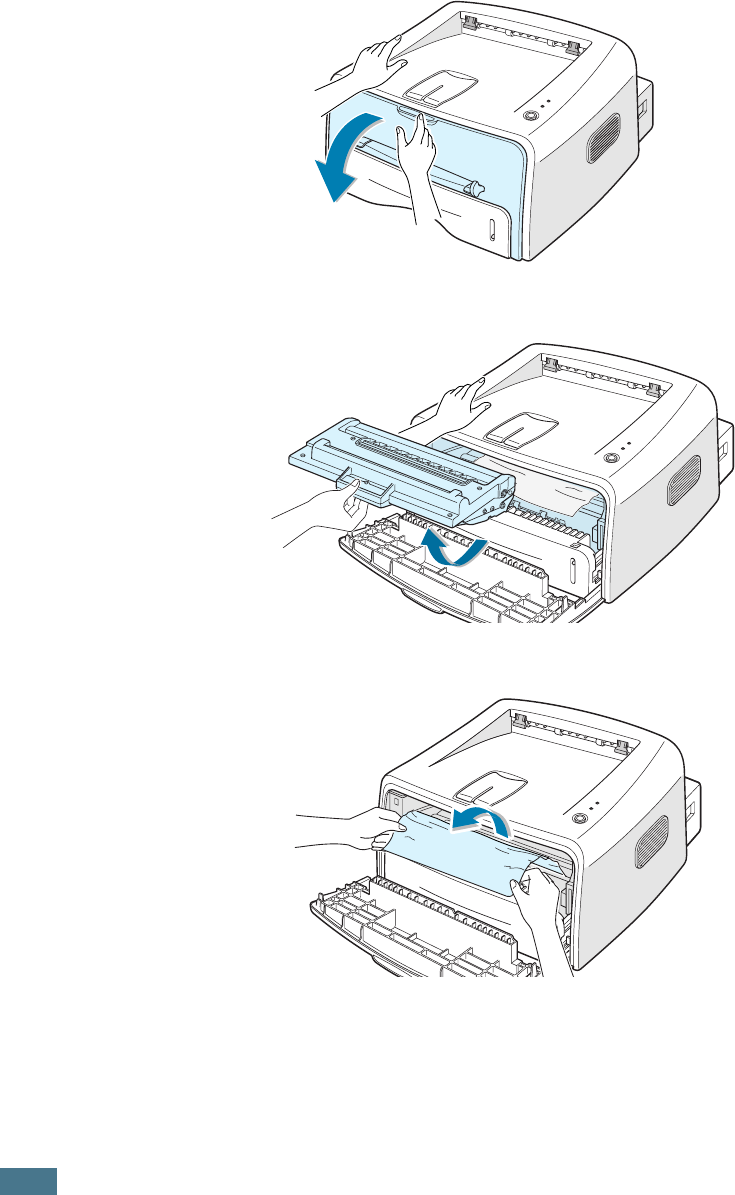
S
OLVING
P
ROBLEMS
6.10
Around the Toner Cartridge
1
Open the front cover.
2
Remove the toner cartridge.
3
Gently pull the paper toward you.
4
Check that there is no other paper in the printer.
5
Reinstall the toner cartridge, and then close the cover.
Printing can be resumed.

S
OLVING
P
ROBLEMS
6.11
6
Tips for Avoiding Paper Jams
By selecting the correct paper types, most paper jams can be
avoided. If a paper jam occurs, follow the steps outlined in
“Clearing Paper Jams” on page 6.7.
• Follow the procedures in “Loading Paper” on page 2.6. Ensure
that the adjustable guides are positioned correctly.
• Do not overload the tray. Ensure that the paper is below the
paper capacity mark on the right inside of the tray.
• Do not remove the paper from the tray while printing.
• Flex, fan and straighten the paper before loading.
• Do not use creased, damp or highly curled paper.
• Do not mix paper types in the input tray.
• Use only recommended print media. See “Paper
Specifications” on page 7.21.
• Ensure that the recommended print side is facing down when
loading paper into the input tray.
Solving Print Quality Problems
Print Quality Checklist
Print quality problems can be resolved by following the checklist
below.
• Redistribute toner in the toner cartridge (see page 5.3).
• Clean the inside of the printer (see page 5.5).
• Adjust the print resolution from the printer properties (see
page 4.16).
• Ensure that Toner Save Mode is off (see page 4.8).
• Clear general printing problems (see page 6.3).
• Install a new toner cartridge, and check the print quality (see
page 2.4).
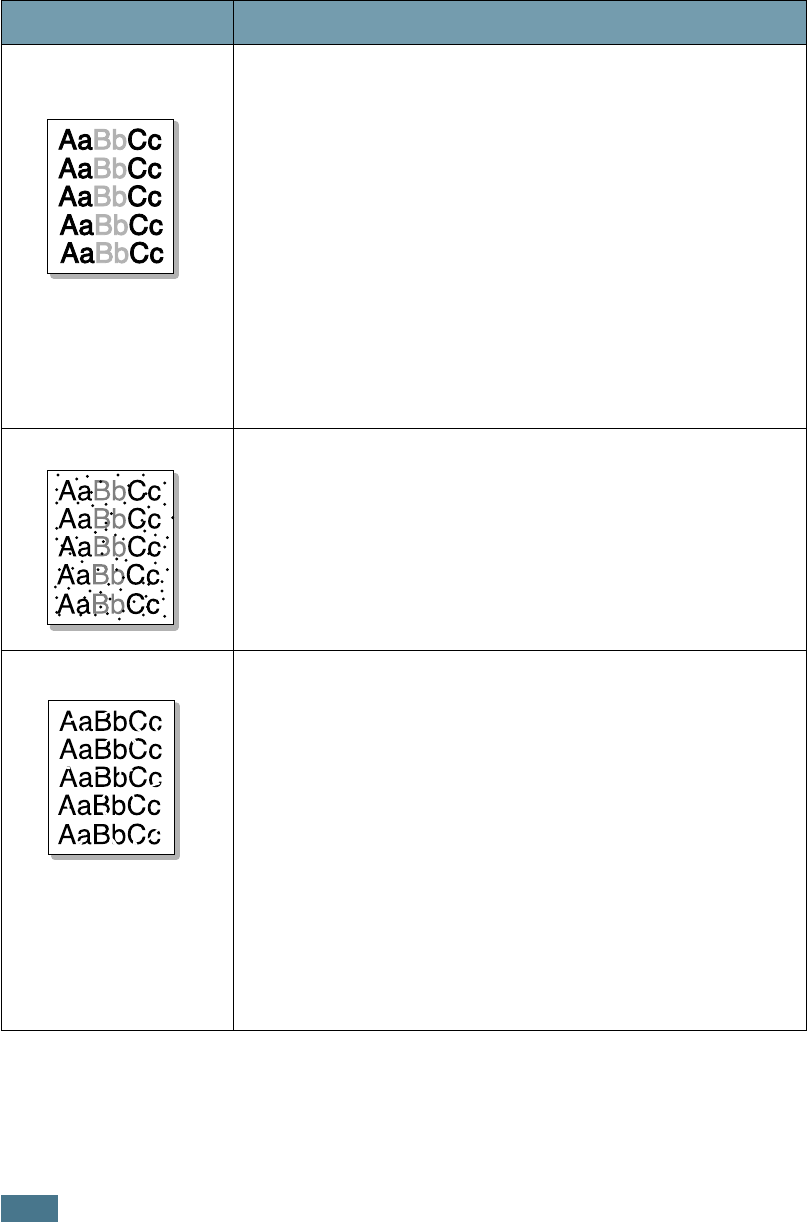
S
OLVING
P
ROBLEMS
6.12
Solving Print Quality Problems
Problem Solution
Light or faded
print
If a vertical white streak or faded area appears on the page:
• The toner supply is low. You may be able to temporarily
extend the toner cartridge life. See “Redistributing Toner”
on page 5.3. If this does not improve the print quality,
install a new toner cartridge.
• The paper may not meet paper specifications (for
example, the paper is too moist or too rough). See “Paper
Specifications” on page 7.21.
• If the entire page is light, the print resolution setting is too
light or Toner Save Mode is on. Adjust the print resolution
and Toner Save Mode in the printer properties. See
page 4.16 and 4.8 respectively.
• A combination of faded or smeared defects may indicate
that the toner cartridge needs cleaning. See “Cleaning the
Inside” on page 5.5.
Toner specs
• The paper may not meet specifications (for example, the
paper is too moist or too rough). See “Paper
Specifications” on page 7.21.
• The transfer roller may be dirty. See “Cleaning the Inside”
on page 5.5.
• The paper path may need cleaning. See “Cleaning the
Inside” on page 5.5.
Dropouts
If faded areas, generally rounded, occur randomly on the
page:
• A single sheet of paper may be defective. Try reprinting
the job.
• The moisture content of the paper is uneven or the paper
has moist spots on its surface. Try a different brand of
paper. See “Paper Specifications” on page 7.21.
• The paper lot is bad. The manufacturing processes can
cause some areas to reject toner. Try a different kind or
brand of paper.
• The toner cartridge may be defective. See “Vertical
repetitive defects” on the next page.
• If these steps do not correct the problems, contact a
service representative.
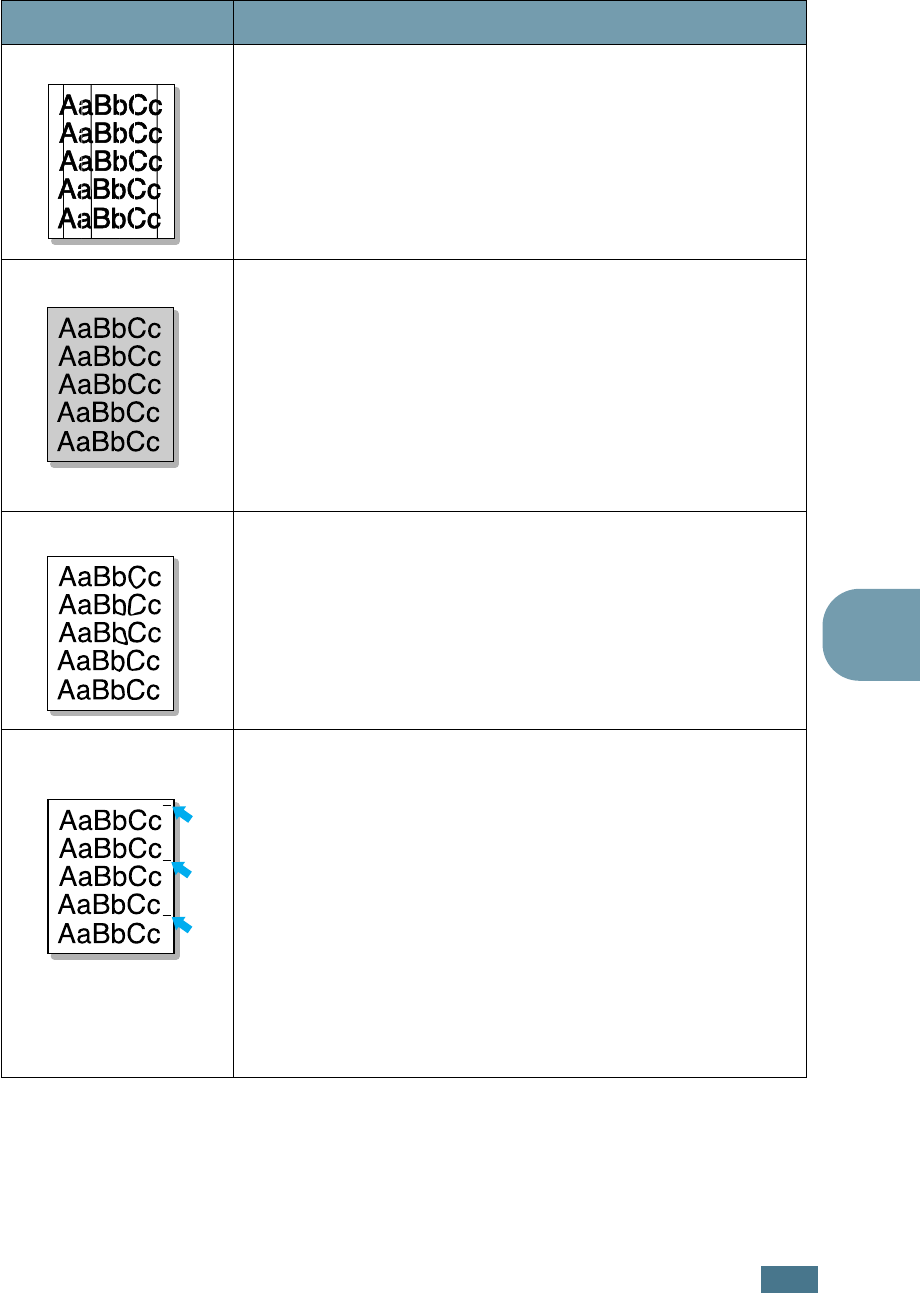
S
OLVING
P
ROBLEMS
6.13
6
Vertical lines
If black vertical streaks appear on the page:
• The drum inside the toner cartridge has probably been
scratched. Install a new toner cartridge.
Gray background
If the amount of background shading becomes
unacceptable, the procedures below may fix the problem.
• Change to a lighter weight pages. See “Paper
Specifications” on page 7.21.
• Check the printer’s environment; very dry (low humidity)
or high humidity (higher than 80% RH) conditions can
increase the amount of background shading.
• Remove the old toner cartridge and install a new one. See
“Installing the Toner Cartridge” on page 2.4.
Toner smear
• Clean the inside of the printer. See “Cleaning the Inside”
on page 5.5.
• Check the paper type and quality. See “Paper
Specifications” on page 7.21.
• Remove the toner cartridge and install a new one. See
“Installing the Toner Cartridge” on page 2.4.
Vertical repetitive
defects
If marks repeatedly appear on the printed side of the page
at even intervals:
• The toner cartridge may be damaged. If a repetitive mark
occurs on the page, print a cleaning sheet several times to
clean the cartridge (see page 5.5). After the printout, if
you still have the same problems, install a new toner
cartridge. See “Installing the Toner Cartridge” on
page 2.4.
• Parts of the printer may have toner on them. If the defects
occur on the back of the page, the problem will likely
correct itself after a few more pages.
• The fusing assembly may be damaged. Contact a service
representative.
Problem Solution
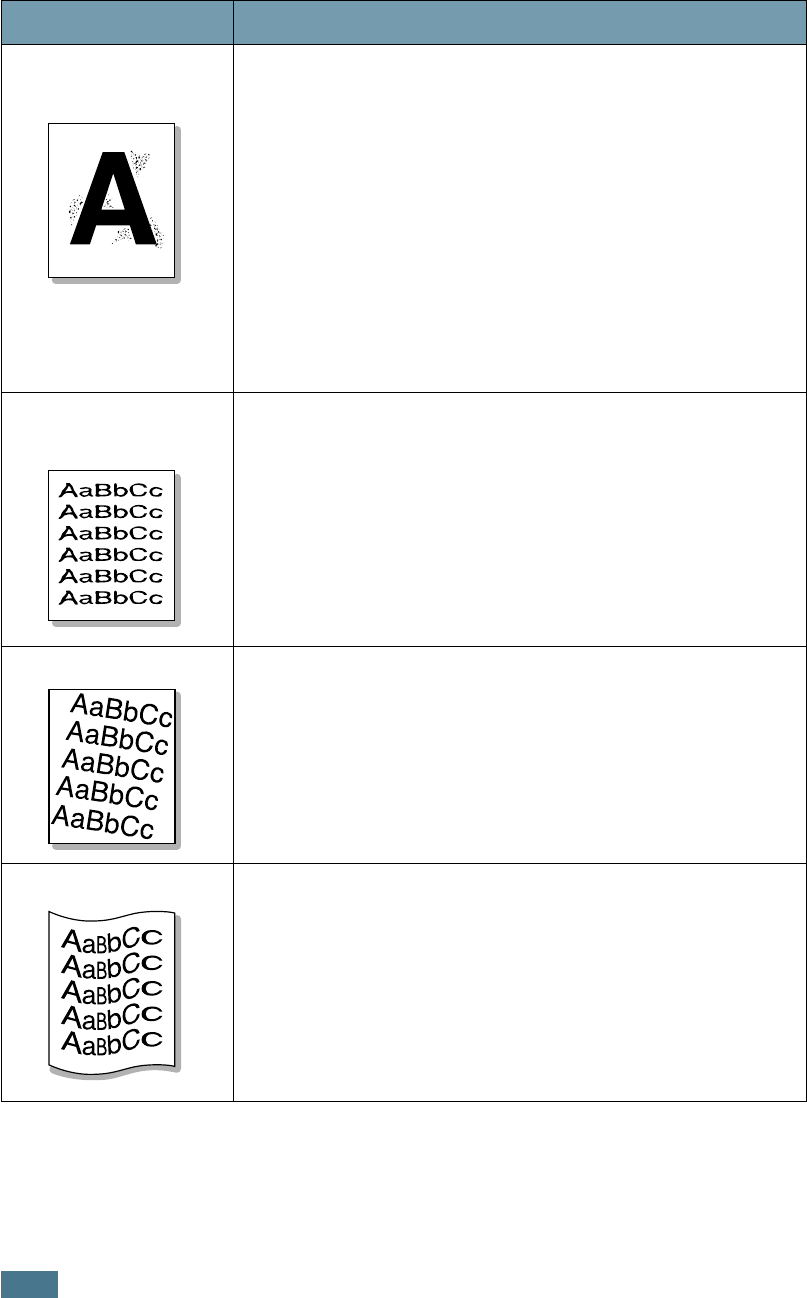
S
OLVING
P
ROBLEMS
6.14
Background
scatter
Background scatter results from bits of toner distributed on
the printed page.
• The paper may be too damp. Try printing with a different
batch of paper. Do not open packages of paper until
necessary so that the paper does not absorb too much
moisture.
• If background scatter occurs on an envelope, change the
printing layout to avoid printing over areas that have
overlapping seams on the reverse side. Printing on seams
can cause problems.
• If background scatter covers the entire surface area of a
printed page, adjust the print resolution through your
software application or the printer properties.
Misformed
characters
• If characters are improperly formed and producing hollow
images, the paper stock may be too slick. Try a different
paper. See “Paper Specifications” on page 7.21.
• If characters are improperly formed and producing a wavy
effect, the scanner unit may need service. Verify that it
also occurs on a demo page by pressing the
Cancel
button on the control panel when the printer is ready. For
service, contact a service representative.
Page skew
• Check the paper type and quality. See “Paper
Specifications” on page 7.21.
• Ensure that the paper or other material is loaded correctly
and the guides are not too tight or too loose against the
paper stack.
Curl or wave
• Check the paper type and quality. Both high temperature
and humidity can cause paper curl. See “Paper
Specifications” on page 7.21.
• Turn over the stack of paper in the input tray. Also try
rotating the paper 180° in the input tray.
• Push the output lever and try printing to the face up
output slot.
Problem Solution
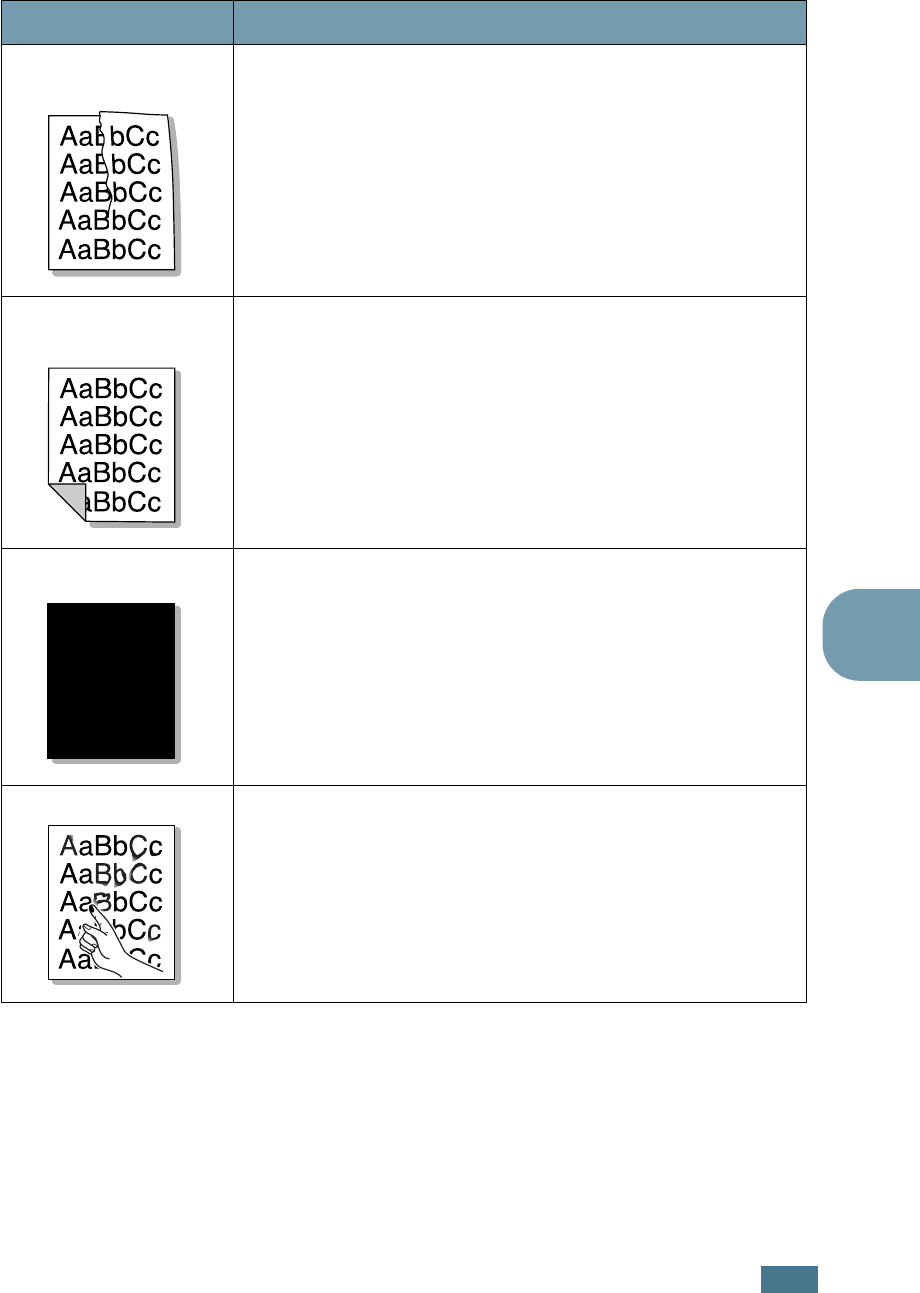
S
OLVING
P
ROBLEMS
6.15
6
Wrinkles or
creases
Insure that the paper is loaded properly.
• Check the paper type and quality. See “Paper
Specifications” on page 7.21.
• Open the rear cover and try printing to the rear output
tray (face-up).
• Turn over the stack of paper in the input tray. Also try
rotating the paper 180° in the feeder.
Back of printouts
are dirty
• The transfer roller may be dirty. See “Cleaning the Inside”
on page 5.5.
• Check for leaking toner. Clean the inside of the printer.
Black pages
• The toner cartridge may not be installed properly. Remove
the cartridge and reinsert.
• The toner cartridge may be defective and need replacing.
Install a new toner cartridge.
• The printer may require repair. Contact a service
representative.
Loose toner
Clean the inside of the printer.
• Check the paper type and quality. See “Paper
Specifications” on page 7.21.
• Install a new toner cartridge.
• If the problem persists, the printer may require repair.
Contact a service representative.
Problem Solution
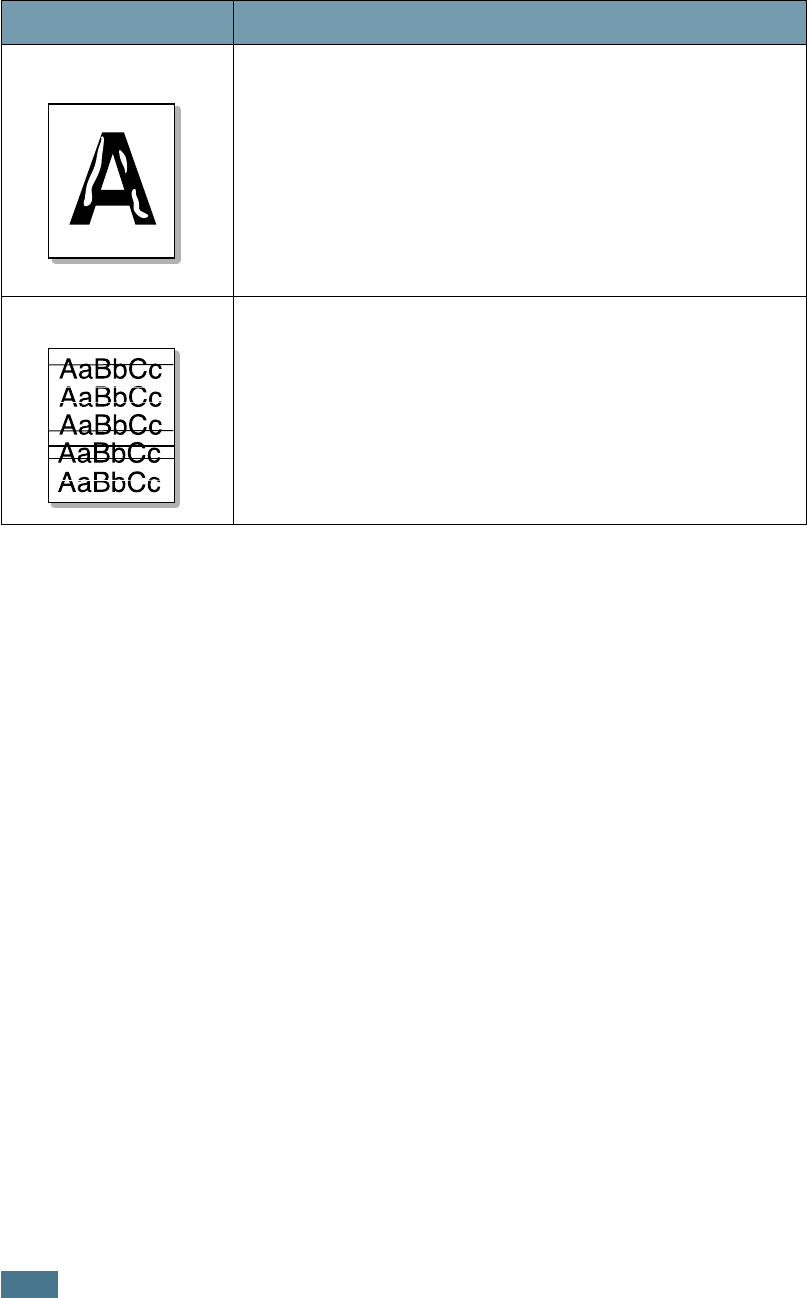
S
OLVING
P
ROBLEMS
6.16
Character Voids
Character voids are white areas within the parts of
characters that should be solid black:
• If you are using transparencies, try another type of
transparency. Because of the composition of the
transparency, some character voids are normal.
• You may be printing on the wrong surface on the paper.
Remove the paper and turn it around.
• The paper may not meet paper specifications. See “Paper
Specifications” on page 7.21.
Horizontal stripes
If horizontally aligned black streaks or smears appear:
• The toner cartridge may be installed improperly. Remove
the cartridge and reinsert.
• The toner cartridge may be defective. Install a new toner
cartridge. See “Installing the Toner Cartridge” on
page 2.4.
• If the problem persists, the printer may require repair.
Contact a service representative.
Problem Solution
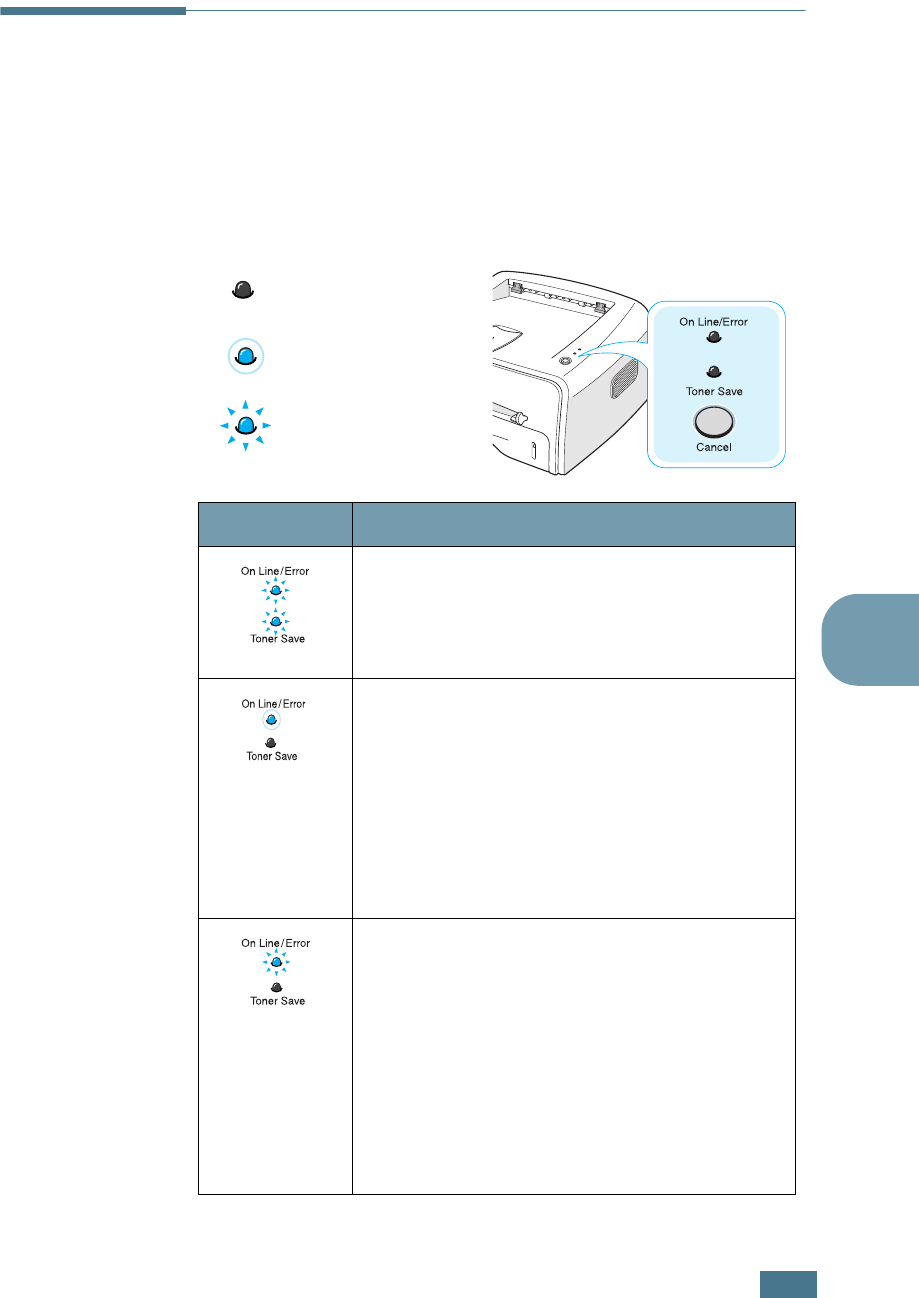
S
OLVING
P
ROBLEMS
6.17
6
Troubleshooting Error Messages
When the printer experiences an error, the control panel will
indicate an error message with the indicator lights. Find the light
pattern below that matches the printer light pattern and follow
the solutions to clear the error.
LED status legend
LED pattern Possible Problems and Solutions
Your system has some problems. If this
problem occurs, contact your service
representative.
On Line/Error
LED lights red
• Paper jam occurs. To solve the problem, see
“Clearing Paper Jams” on page 6.7.
• The front cover is open. Close the front
cover.
• The toner cartridge is empty. Remove the
old toner cartridge and install a new one.
See “Installing the Toner Cartridge” on
page 2.4.
• You pressed the
Cancel
button while the
printer is receiving data.
• In Manual Feed mode, there is no paper in
the Manual Feeder. Load paper into the
Manual Feeder.
• If the printer is receiving data, the On
Line/Error LED slowly blinks green.
• If the printer is printing the received data,
the On Line/Error LED blinks green fast.
symbol for “light off”
symbol for “light on”
symbol for “light blinking”
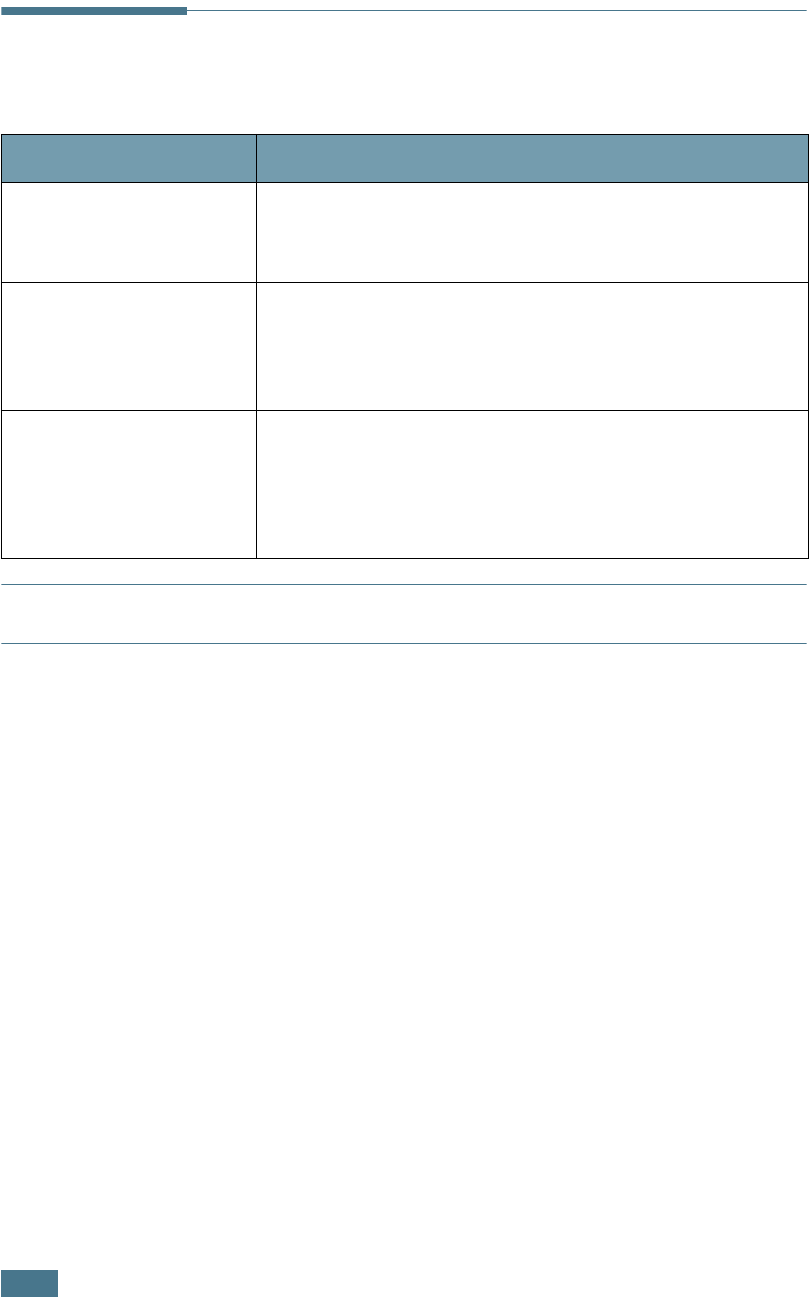
S
OLVING
P
ROBLEMS
6.18
Common Windows Problems
Note: Refer to Microsoft Windows 98, Me, 2000 or XP User’s Guide that came with your
PC for further information on Windows error messages.
Problem Possible Cause and Solution
“File in Use” message
appears during
installation.
Exit all software applications. Remove all software from
the
StartUp Group
, then restart Windows. Reinstall the
printer software.
“Error Writing to LPTx”
message appears.
• Ensure that the cables are connected correctly and the
printer is on.
• If bi-directional communication is not turned on in the
driver, it will also cause this message.
“General Protection
Fault”, “Exception OE”,
“Spool32”, or “Illegal
Operation” messages
appear.
Close all other applications, reboot Windows, and try
printing again.

S
OLVING
P
ROBLEMS
6.19
6
Common Macintosh Problems
Problems in the Chooser
Printing Errors
Problem Possible Cause and Solution
The printer driver
icon does not appear
in Chooser.
Software is not installed correctly.
• The LaserWriter driver should be present as a part of the
Macintosh OS. Make sure that the LaserWriter driver is in
the Extensions folder within the Systems folder. If not,
install the LaserWriter driver component from the
Macintosh OS CD.
• Make sure that you are using a high-quality cable.
• Make sure that the printer is on the correct network.
Select Network or AppleTalk Control Panel from
Control Panels in the Apple menu and then choose the
correct network.
The printer name
does not appear in
Chooser.
• Make sure that the cables are connected correctly and the
printer is turned on.
• Make sure that the correct printer driver has been selected
in Chooser.
Problem Possible Cause and Solution
You cannot use the
computer while the
printer is printing.
Background Printing has not been selected.
• For LaserWriter 8.3, turn Background Printing on in the
Chooser. Status messages will now be redirected to the
Print Monitor allowing you to continue working while the
computer is processing data to be sent to the printer.
• For LaserWriter 8.4 or higher, turn Background Printing
on at the Print dialog box.
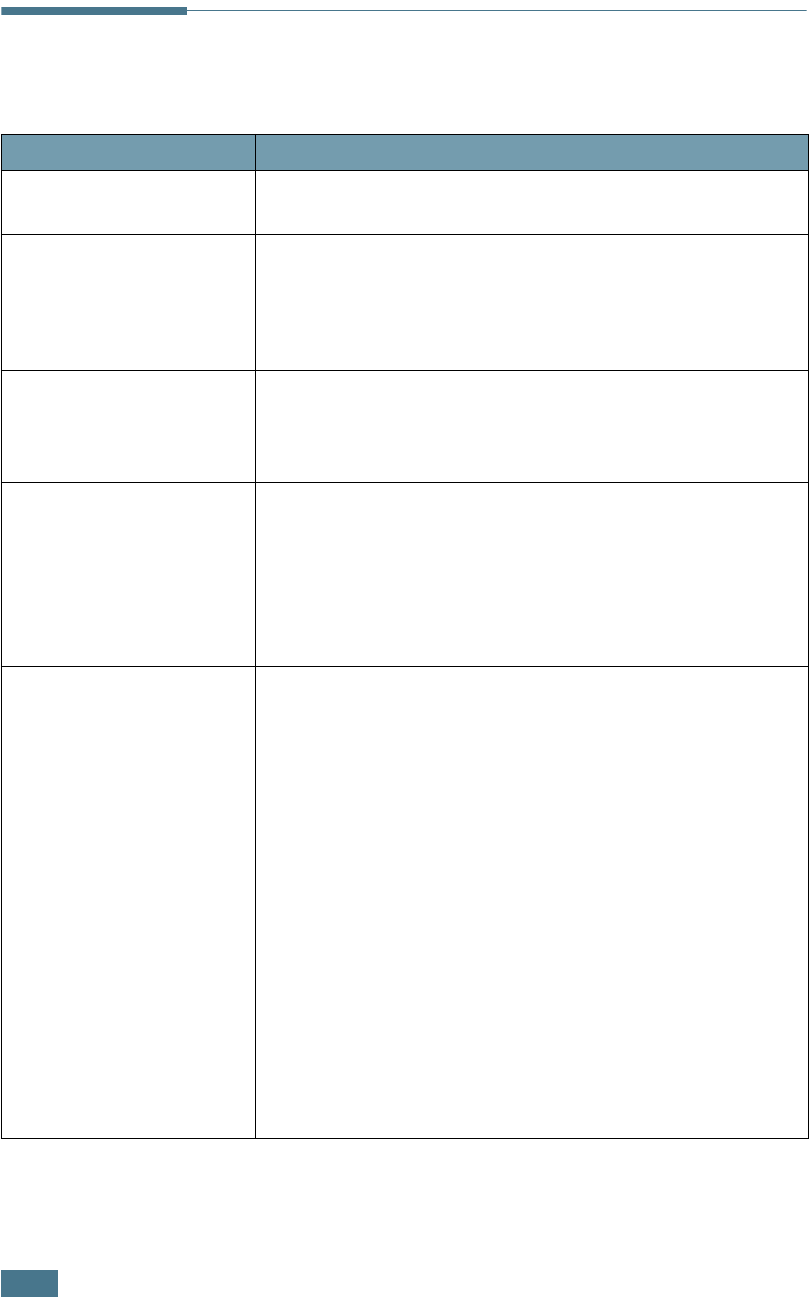
S
OLVING
P
ROBLEMS
6.20
Common Linux Problems
Problem Possible Cause and Solution
I can’t change settings in
the configuration tool.
You need to have administrator privileges to be able to
affect global settings.
I am using the KDE
desktop but the
configuration tool and
LLPR won’t start.
Maybe you do not have the GTK libraries installed. These
usually come with most Linux distributions, but you may
have to install them manually. Refer to your distribution’s
installation manual for more details about installing
additional packages.
I just installed this
package but can’t find
entries in the KDE/
Gnome menus.
Some versions of the KDE or GNOME desktop
environments may require that you restart your session
for the changes to take effect.
I get a “Some options are
not selected” error
message while editing
the printer settings.
Some printers have conflicting settings, meaning that
some settings for two options can’t be selected at the
same time. When you change a setting and the Printer
Package detects such a conflict, the conflicting option is
changed to a “No Choice” value, and you have to choose
an option that does not conflict before being able to submit
the changes.
I can’t make a printer the
system default.
• In some conditions, it may not be possible to change the
default queue. This happens with some variants of
LPRng, especially on recent RedHat systems that use the
‘printconf’ database of queues.
• When using printconf, the
/etc/printcap
file is
automatically refreshed from the database of printers
managed by the system (usually through the ‘printtool’
command), and the queues in /etc/printcap.local are
appended to the resulting file. since the default queue in
LPRng is defined as the first queue in
/etc/printcap
,
therefore it is not possible for the Samsung Printer
Package to change the default when some queues have
otherwise been defined using printtool.
• LPD systems identify the default queue as the one
named ‘lp’. Thus if there is already a queue by this
name, and if it doesn’t have any alias, then you won’t be
able to change the default. To work around this, you can
either delete the queue, or rename it by manually editing
the
/etc/printcap
file.
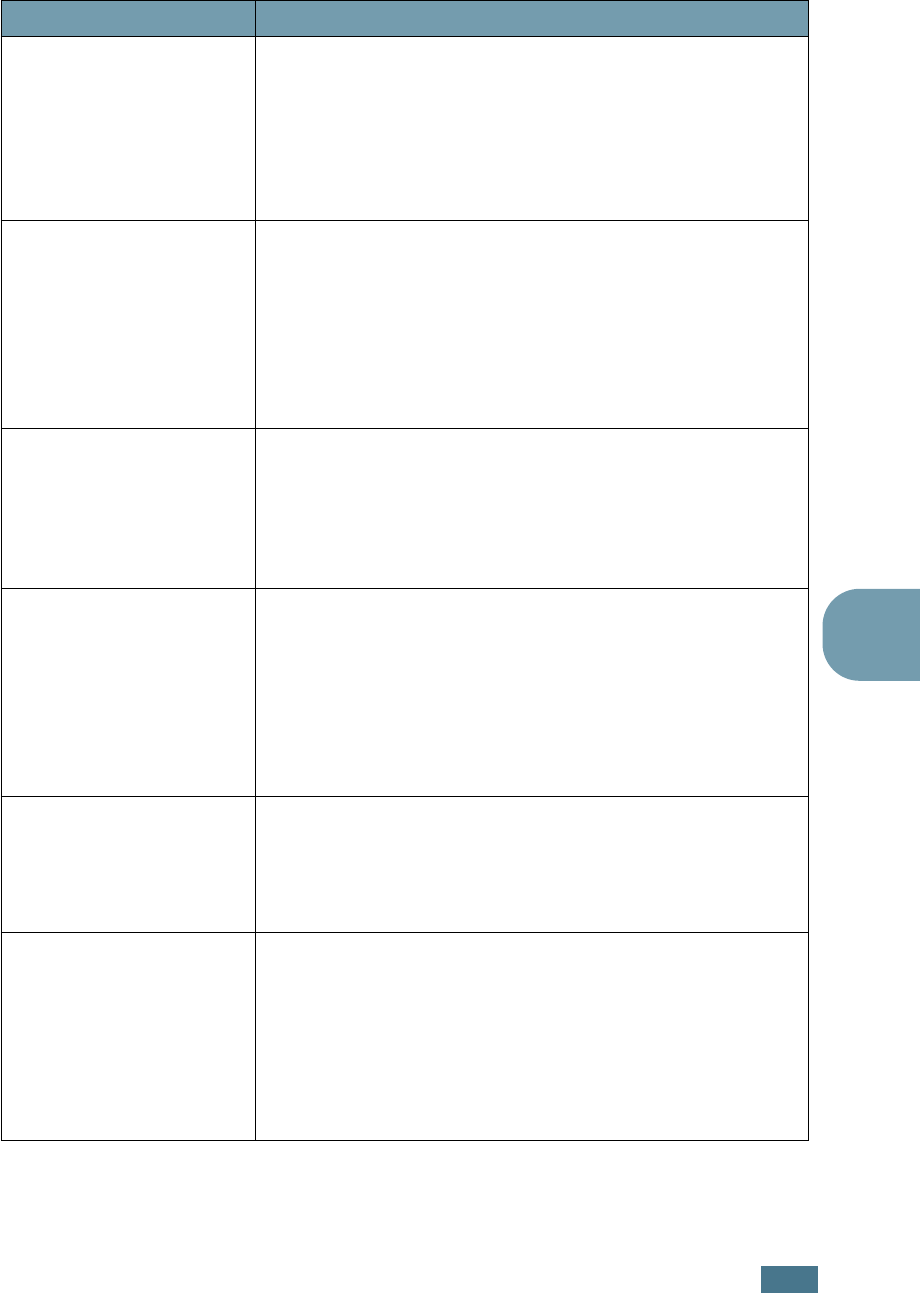
S
OLVING
P
ROBLEMS
6.21
6
The N-up setting does not
work correctly for some
of my documents.
The N-up feature is achieved through post-processing of
the PostScript data that is being sent to the printing
system. However, such post-processing can only be
adequately achieved if the PostScript data conforms to the
Adobe Document Structing Conventions. Problems may
arise when using N-up and other features relying on post-
processing if the document being printed isn’t compliant.
I am using BSD lpr
(Slackware, Debian, older
distributions) and some
options chosen in LLPR
don’t seem to take effect.
Legacy BSD lpr systems have a hard limitation on the
length of the option string that can be passed to the
printing system. As such, if you selected a number of
different options, the length of the options may be
exceeded and some of your choices won’t be passed to the
programs responsible for implementing them. Try to select
less options that deviate from the defaults, to save on
memory usage.
I am trying to print a
document in Landscape
mode, but it prints
rotated and cropped.
Most Unix applications that offer a Landscape orientation
option in their printing options will generate correct
PostScript code that should be printed as is. In that case,
you need to make sure that you leave the LLPR option to
its default Portrait setting, to avoid unwanted rotations of
the page that would result in a cropped output.
Some pages come out all
white (nothing is
printed), and I am using
CUPS.
If the data being sent is in Encapsulated PostScript (EPS)
format, some earlier versions of CUPS (1.1.10 and before)
have a bug preventing them from being processed
correctly. When going through LLPR to print, the Printer
Package will work around this issue by converting the data
to regular PostScript. However, if your application
bypasses LLPR and feeds EPS data to CUPS, the document
may not print correctly.
I can’t print to a SMB
(Windows) printer.
To be able to configure and use SMB-shared printers (such
as printers shared on a Windows machine), you need to
have a correct installation of the SAMBA package that
enables that feature. The “smbclient” command should be
available and usable on your system.
My application seems to
be frozen while LLPR is
running.
Most Unix applications will expect a command like the
regular “lpr” command to be non-interactive and thus
return immediately. Since LLPR is waiting for user input
before passing the job on to the print spooler, very often
the application will wait for the process to return, and thus
will appear to be frozen (its windows won’t refresh). This is
normal and the application should resume functioning
correctly after the user exits LLPR.
Problem Possible Cause and Solution
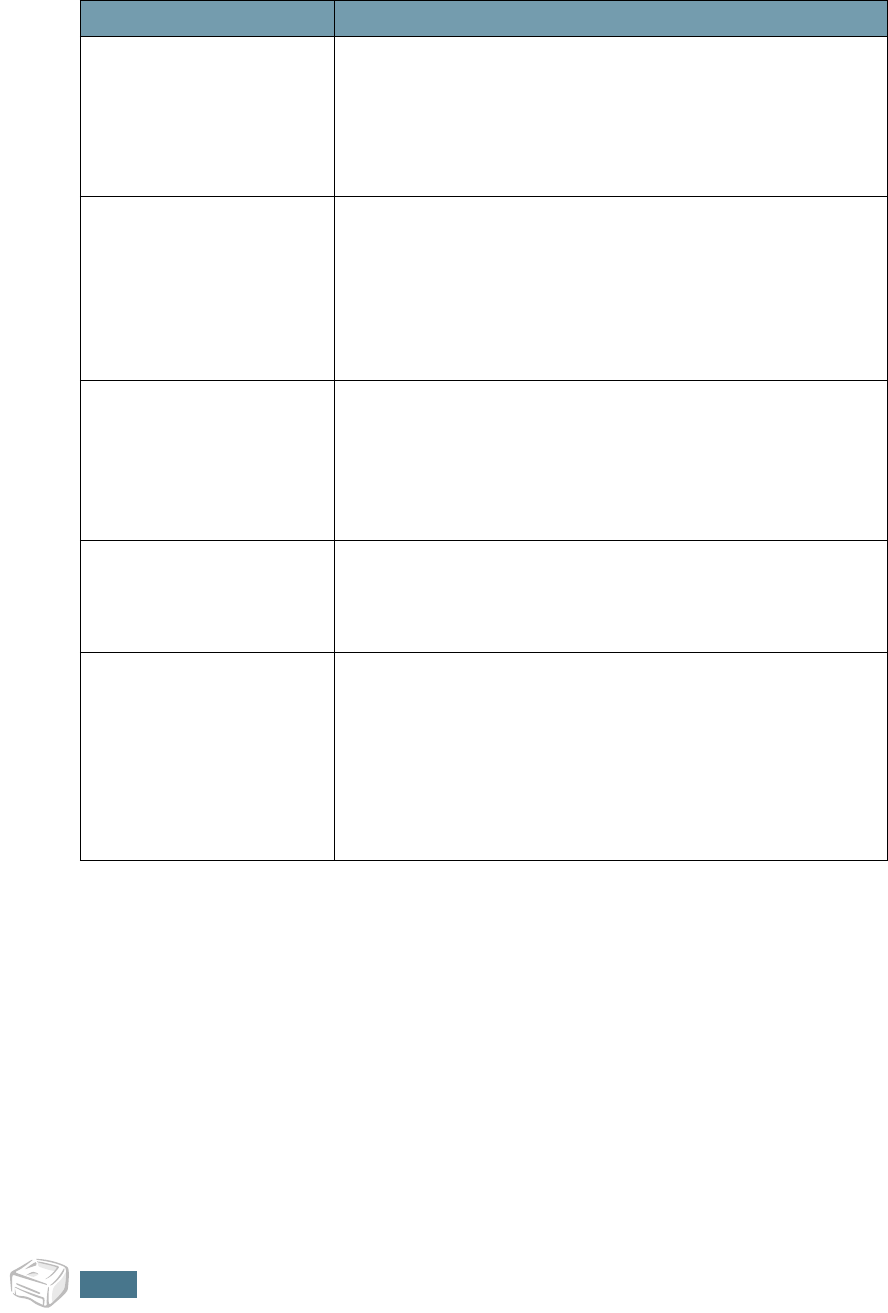
S
OLVING
P
ROBLEMS
6.22
How do I specify the IP
address of my SMB
server?
It can be specified in the “Add Printer” dialog of the
configuration tool, if you don’t use the CUPS printing
system. Unfortunately, CUPS currently doesn’t allow to
specify the IP address of SMB printers, so you will have to
be able to browse the resource with Samba in order to be
able to print.
Some documents come
out as white pages when
printing.
Some versions of CUPS, especially those shipped with
Mandrake Linux before the 8.1 release, have some known
bugs when processing the PostScript output from some
applications. Try upgrading to the latest version of CUPS
(at least 1.1.14). Some RPM packages for most popular
distributions are provided as a convenience with this Linux
Printing Package.
I have CUPS and some
options (such as N-up)
seem to be always
enabled even though I
don’t pick them in LLPR.
There may be some local options defined in your ~/
.lpoptions file, which is manipulated by the lpoptions
command. These options will always be used if not
overridden by LLPR settings. To get rid of all options for a
printer, run the following command, replacing “printer”
with the name of the queue: lpoptions -x printer
I configured a printer to
print to a file, but I get
“Permission denied”
errors.
Most printing systems will not run as the super-user but as
a special user (usually “lp”). Therefore, make sure that the
file you have chosen to print to is accessible to the user
owning the spooler daemon.
On my PCL (or SPL)
printer, I sometimes get
error messages printing
instead of my document.
Unfortunately, some Unix applications may generate non-
compliant PostScript output that may not be supported by
Ghostscript, or even the printer itself in PostScript mode.
You can try to capture the output to a file and view the
results with Ghostscript (gv or ghostview will allow you to
do so interactively) and see if you get error messages.
However, since the application is at probably fault, contact
your software vendor to inform them of the issue.
Problem Possible Cause and Solution

7
This chapter includes:
• Using Your Printer with a Macintosh
• Using Your Printer in Linux
• Printer Specifications
• Paper Specifications
APPENDIX

A
PPENDIX
7.2
Using Your Printer with a Macintosh
Your printer supports Macintosh systems with a built-in USB
interface. When you print a file from a Macintosh computer, you
can use the SPL driver to support your printer’s major printing
features.
Installing Software for Macintosh
System Requirements
To use your printer and its software with a Macintosh, your
system should have:
Macintosh Hardware Requirement:
• One of the following Macintosh models:
-Power Macintosh series
-Power Macintosh G3, G4
-iMac series
-PowerBook series
-iBook series
• USB interface
Macintosh System Requirement:
System 8.6 or later
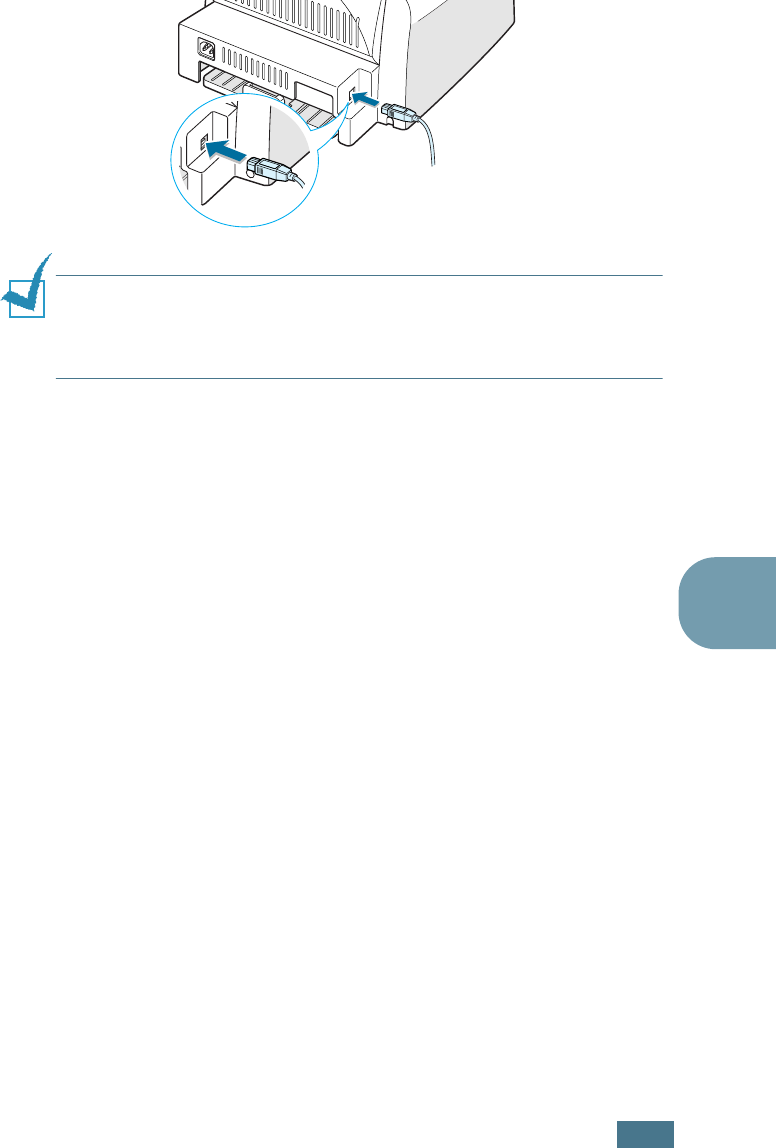
A
PPENDIX
7.3
7
Installing Software
1
Turn the printer and computer off and plug the USB cable
into your printer’s USB connector. For more details, see
page 2.9.
Note: If you are using a USB hub, connect the printer’s cable to
the first tier of the hub, or the printer may malfunction. If the
printer doesn’t work with the hub, connect it directly to the USB
port.
2
Turn on your computer and printer.
3
Insert the CD-ROM which came with your printer into the
CD-ROM drive.
4
Double-click ML-1710 on your Macintosh desktop.
5
Double-click the West folder.
6
Double-click the Samsung Laser Printer Installer icon
next to each language to select the correct one.
7
Click Continue, and then click Continue.
8
The Samsung Laser Printer Installer window opens. Select
the installation type. The window provides the following two
options for software installation:
• Easy Install (recommended method): This option installs
the SPL driver.
• Custom Install: This option allows you to choose which
components will be installed, the SPL driver or Adobe
Acrobat Reader program for opening the User’s Guide.

A
PPENDIX
7.4
9
Click Install.
If other programs are operating, the alert message
appears. Click Continue to install the software, or click
Cancel and close other programs, and install the software.
10
After installation is complete, click Restart.
Choosing Your Printer
1
From the Apple menu, select Chooser.
2
From the left pane of the Chooser window, click SAMSUNG
SPL II. Then your printer name will appear in the right
pane of the Chooser window.
3
Click SAMSUNG SPL II, and close the Chooser window.
4
The message window indicating that you have changed your
current printer appears. Click OK.
5
An SAMSUNG SPL II printer icon will be created on your
desktop.
Printing a Document
When you print with a Macintosh, you need to check the printer
software setting in each application you use. Follow these steps
to print from a Macintosh:
1
Open a Macintosh application and select a file you want to
print.
2
Open the File menu, and click Page Setup (Document
Setup in some applications).
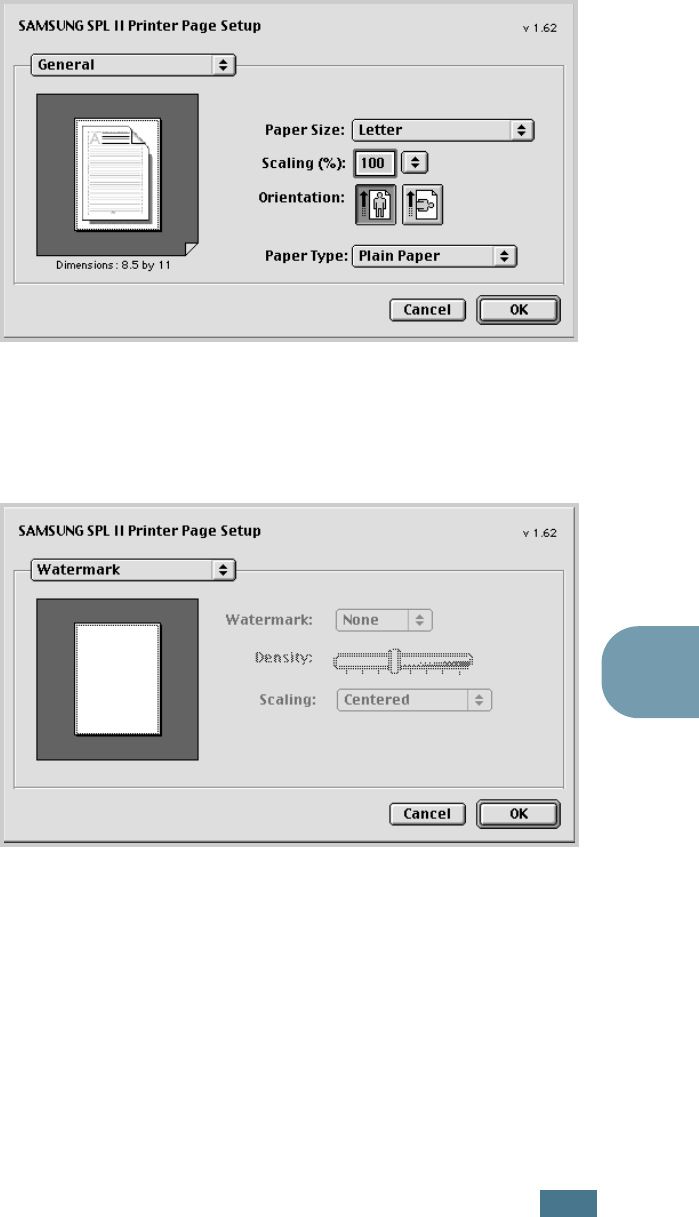
A
PPENDIX
7.5
7
3
Choose your paper size, orientation, paper type and other
options and click OK.
Choose Watermark to add a watermark to each page in
your document to emphasize its purpose or indicate how it
should be handled. For details on the watermark options,
see page 4.19.
4
Open the File menu and click Print. You will see the
SAMSUNG SPL II Printer window.
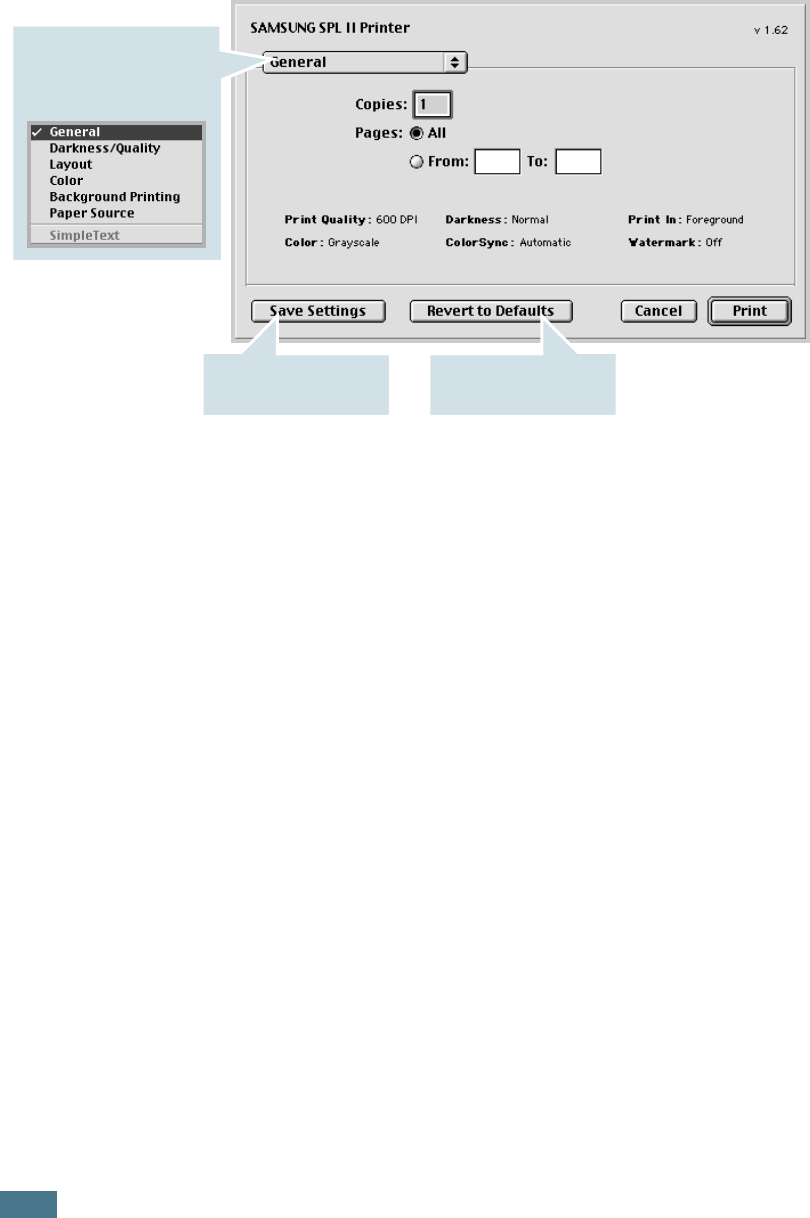
A
PPENDIX
7.6
5
Choose the number of copies and indicate which pages you
want to print.
6
Click Print when you finish setting the options.
Using Advanced Printing Features
The SAMSUNG SPL II Printer window contains five categories of
advanced properties. Listed below is the name of each property.
- Darkness/Quality
- Layout
- Color
- Background Printing
- Paper Source
Figures next display each property in the SAMSUNG SPL II
Printer window.
Saves the current
settings for later use.
Restores the default
settings.
For advanced printing
features, select the
desired option. For
details, see below.
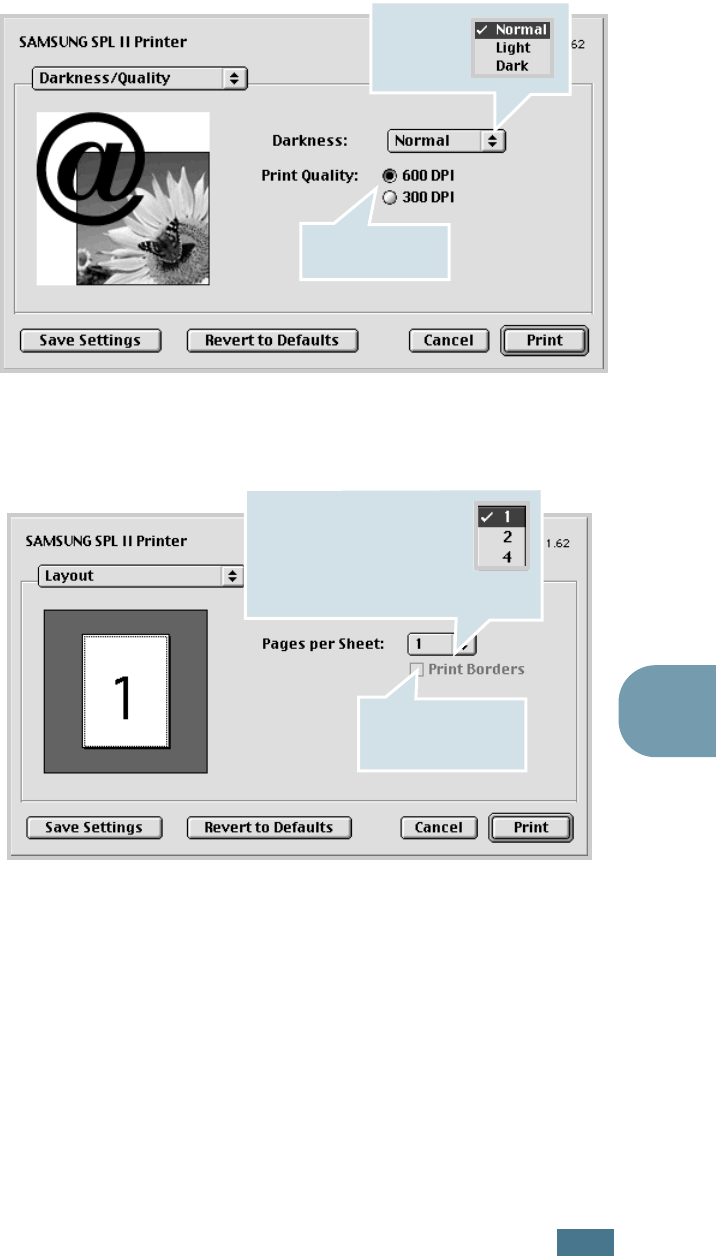
A
PPENDIX
7.7
7
Darkness/Quality
Layout
Select the
print
darkness.
Select the print
resolution.
To print the border
of each page,
check this box.
Select the number of
pages you want to print on
one sheet of paper. The
pages will appear
decreased in size and
arranged on the sheet.
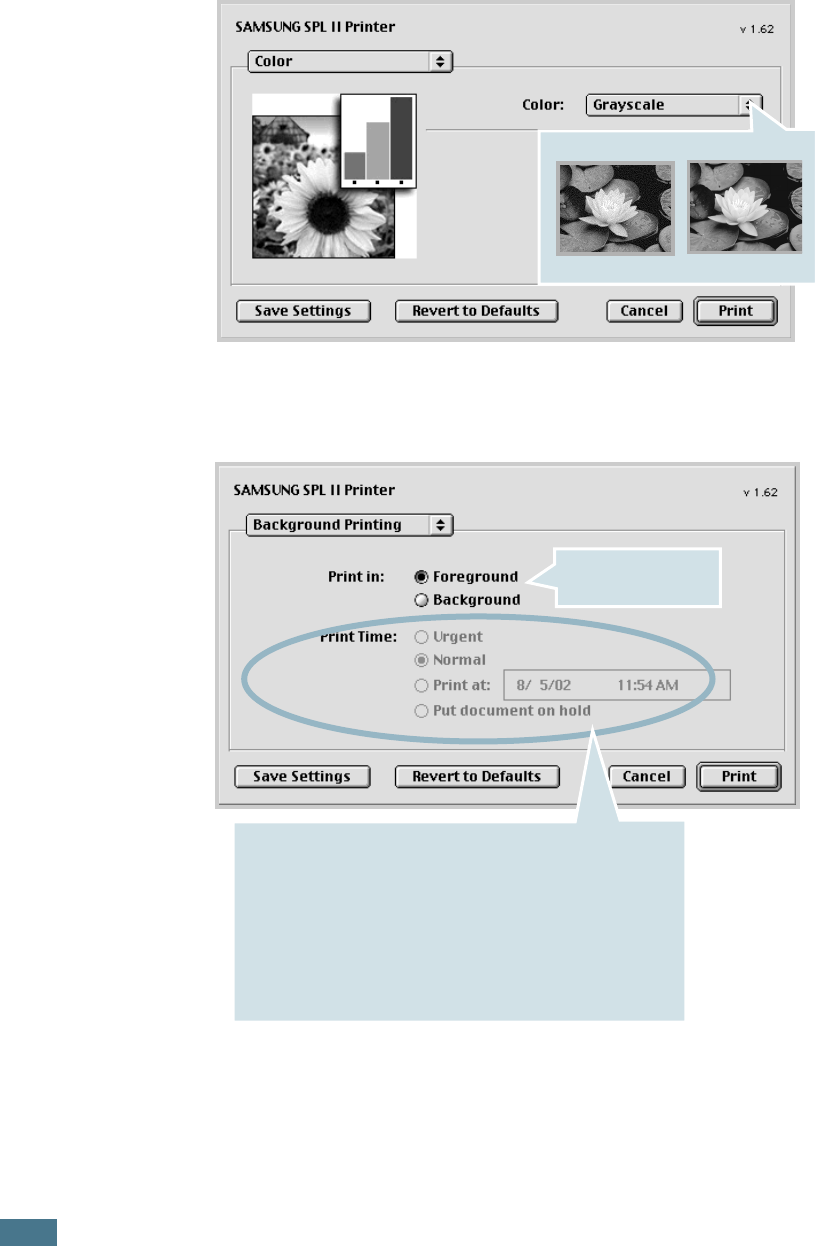
A
PPENDIX
7.8
Color
Background Printing
Select the grayscale mode.
➐
Black&White
➐
Grayscale
Select a priority for your print job in the queue of jobs
waiting to print, click one of the following:
• Urgent: to print before any Normal priority job.
• Normal: to print in the order the job is received.
• Print at: to print at the specific time you enter in the
day and time in the fields to the right.
• Put document on hold: to hold the print job in the
print queue until you are ready to release it.
Turns background
printing on or off.
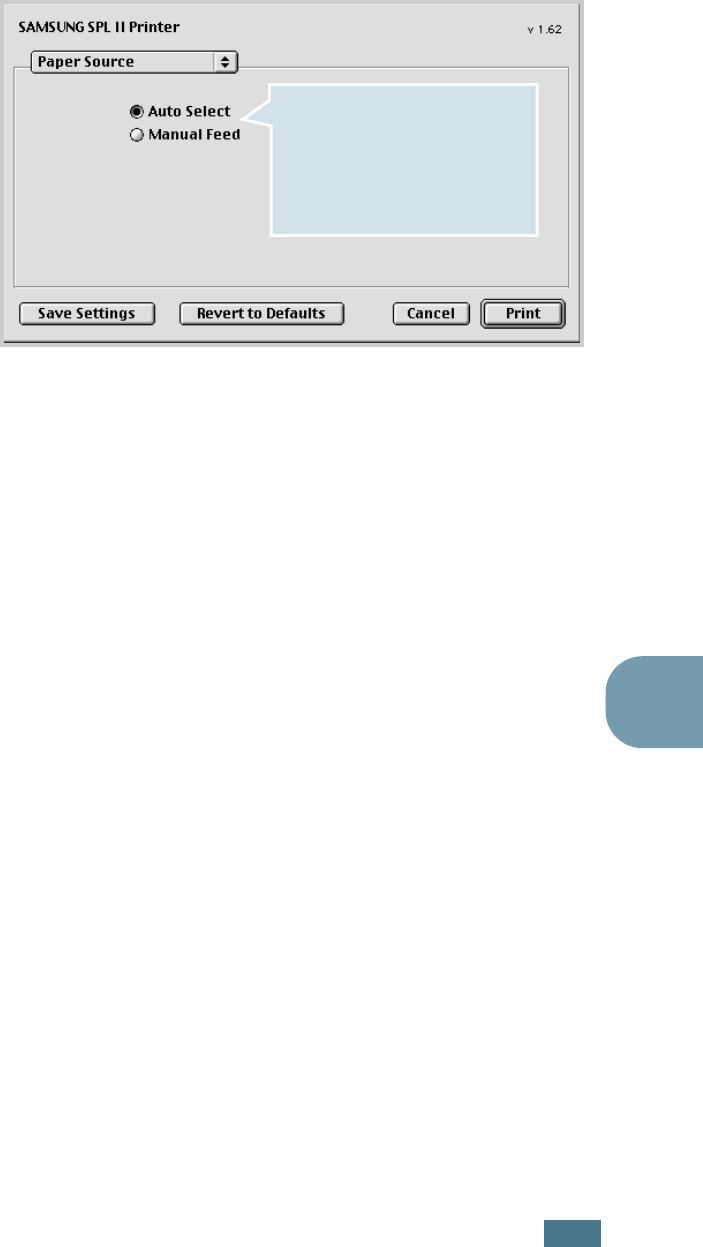
A
PPENDIX
7.9
7
Paper Source
Select the corresponding paper
source. If Auto Select is set,
the printer automatically
selects the print material from
the paper feeder, according to
the following order: Manual
Feeder, Tray.
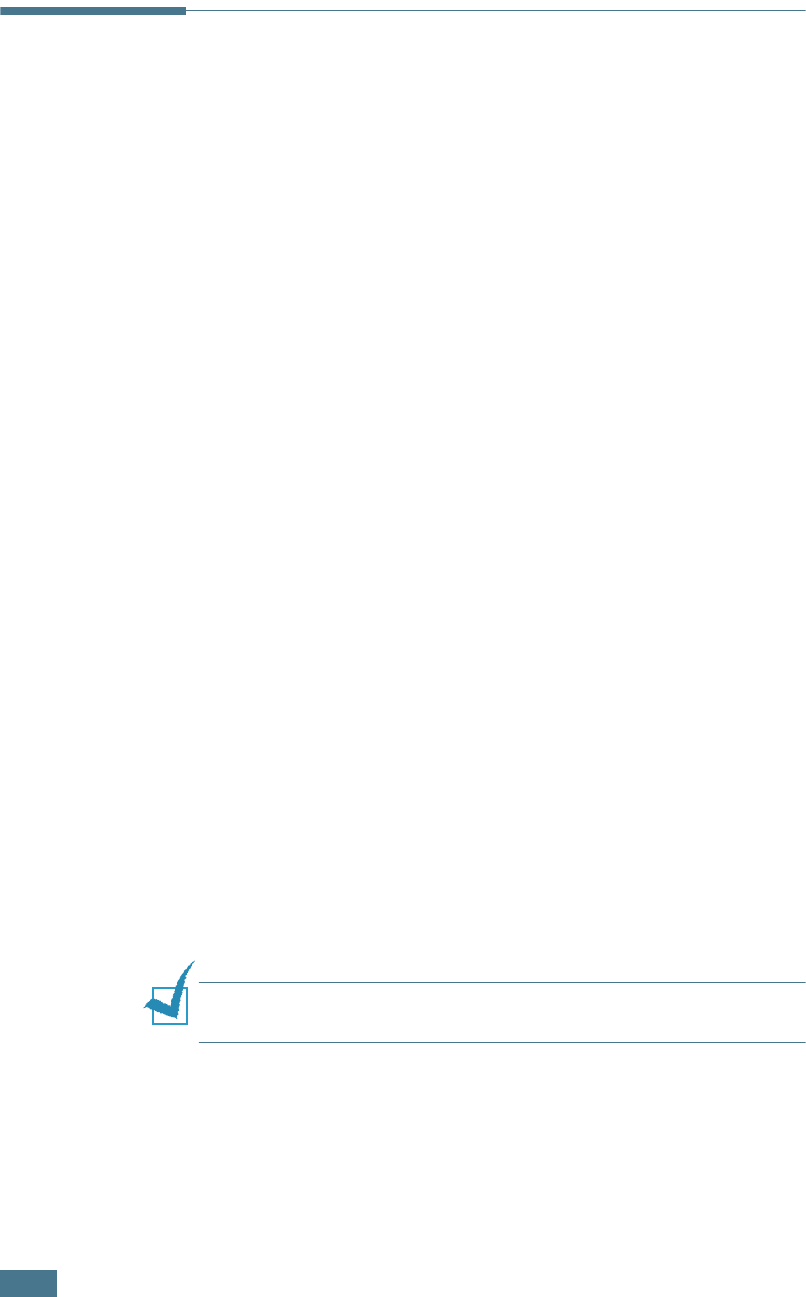
A
PPENDIX
7.10
Using Your Printer in Linux
Installing the Printer Driver
System Requirements
Supported OS
• Redhat 6.2/7.0/7.1 and above
• Linux Mandrake 7.1/8.0 and above
• SuSE 6.4/7.0/7.1 and above
• Debian 2.2 and above
• Caldera OpenLinux 2.3/2.4 and above
• Turbo Linux 6.0 and above
• Slackware 7.0/7.1 and above
Recommended Requirements
• Pentium II or Power PC G3
• RAM 64 MB or higher
• HDD 20 MB or higher
Softwares
• Glibc 2.1 or higher
• GTK+ 1.2 or higher
• GhostScript
Installing Printer Driver
1
Make sure that you connect the printer to your computer.
Turn both the computer and the printer on.
2
When the Administrator Login window appears, type in
“root” in the Login field and enter the system password.
Note: You must log in as a super user (root) to install the printer
software. If you are not, ask your system administrator.
3
Insert the printer software CD-ROM. The CD-ROM
automatically runs.
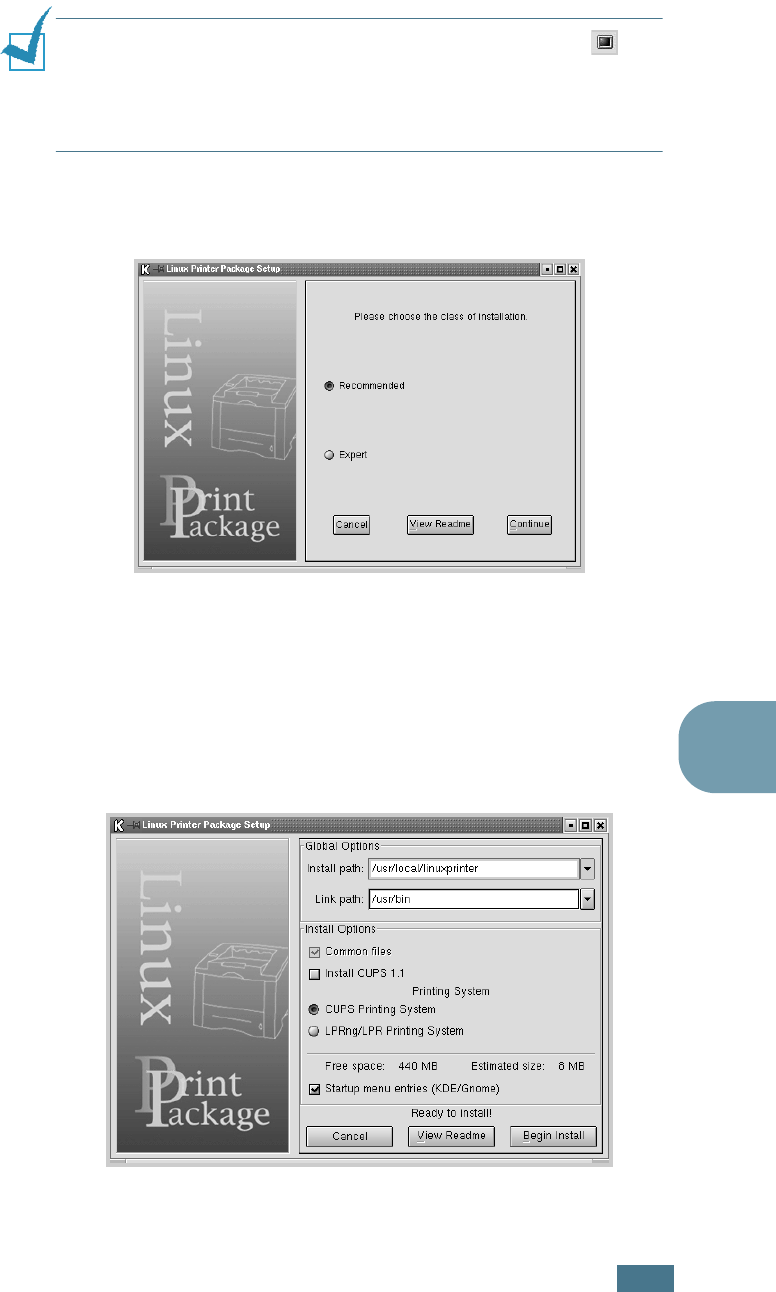
A
PPENDIX
7.11
7
Note: If the CD-ROM does not automatically run, click the icon
at the bottom of the window. When the Terminal screen appears,
type in:
[root@local /root]#
cd /mnt/cdrom
(the CD-ROM directory)
[root@local cdrom]#
./setup.sh
4
Select the installation type, either Recommended or
Expert, and then click Continue.
Recommended is fully automated and is not required any
interaction. Expert installation allows you to select the
install path or printing system.
5
If you selected Recommended, go to Step 6.
For Expert, select the desired option and then click Begin
Install.
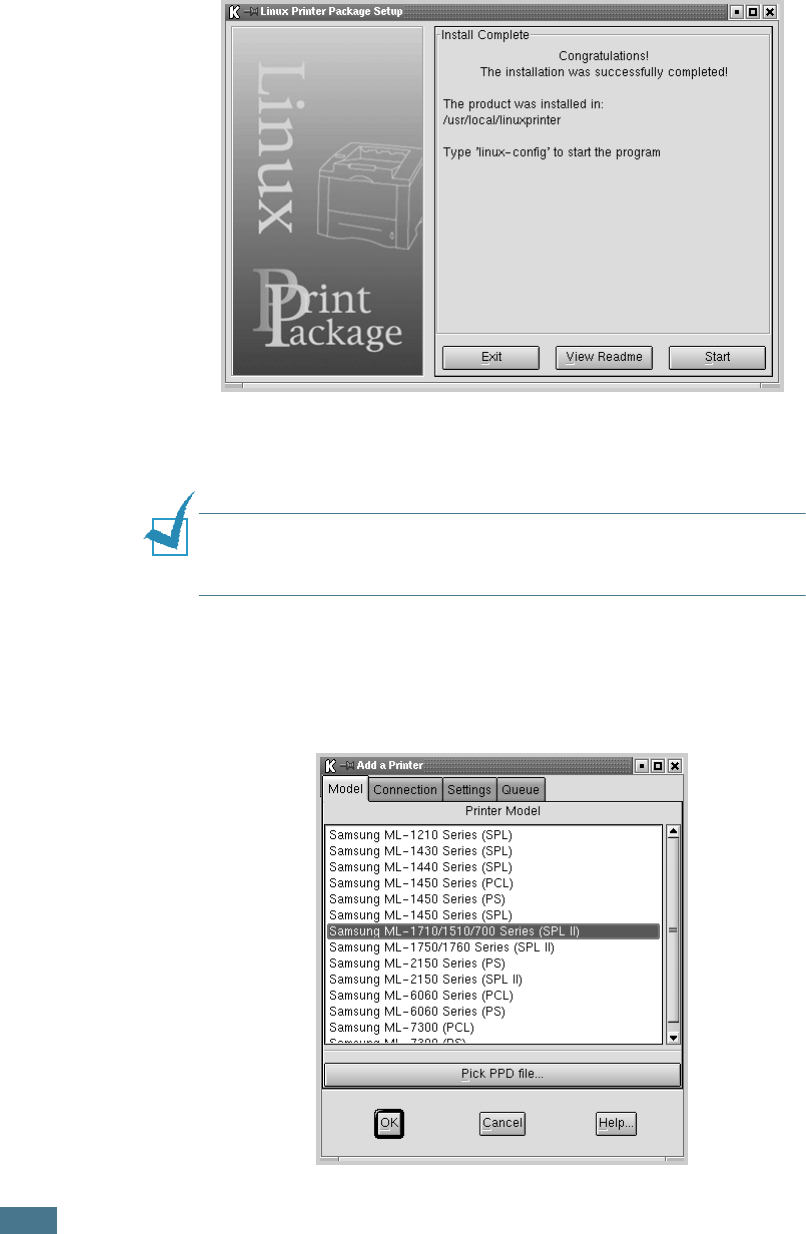
A
PPENDIX
7.12
6
The printer driver installation begins. When the installation
is completed, click Start.
7
The Linux Printer Configuration window opens. Click the
Add Printer icon on the toolbar at the top of the window.
Note: Depending on the printing system in use, the Administrator
Login window may appear. Type in “root” in the Login field and
enter the system password.
8
You see the printers currently added in your system. Select
the printer you will use. The function tabs available for the
selected printer appear at the top of the Add a Printer
window.
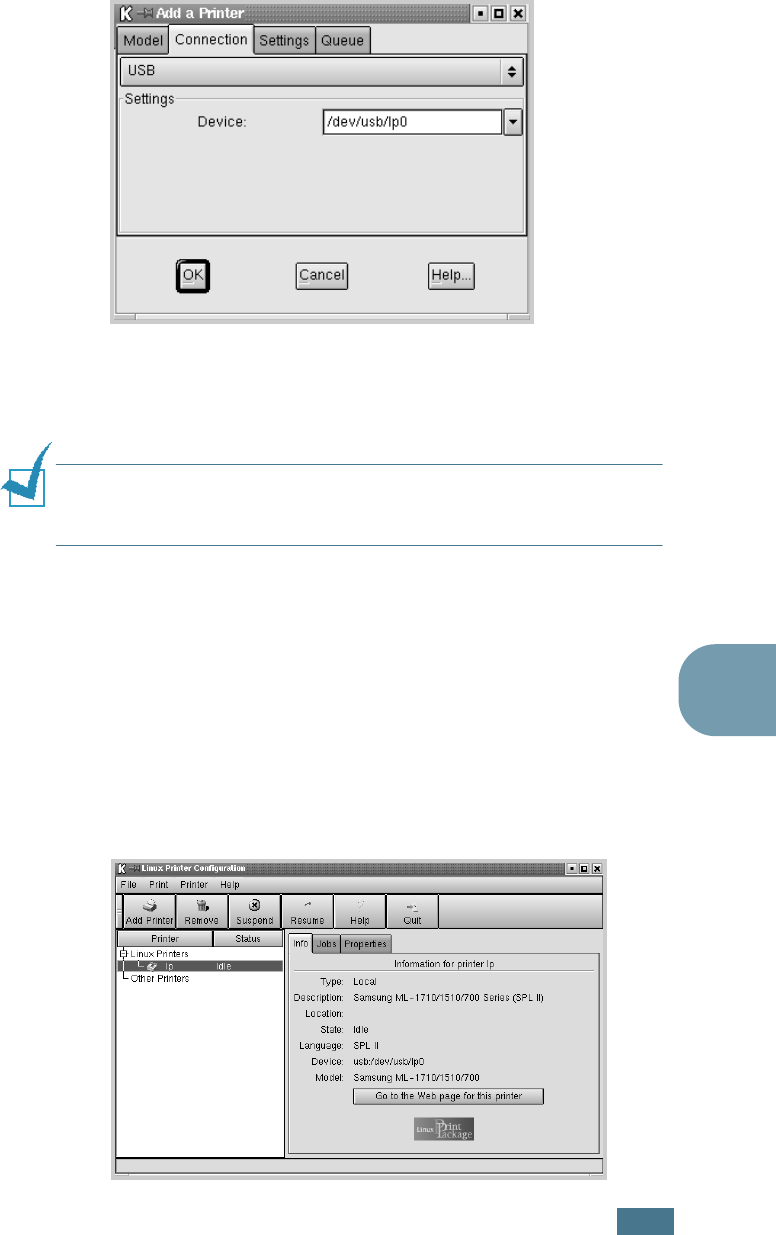
A
PPENDIX
7.13
7
9
Click the Connection tab and ensure that the printer port
is set properly. If not proper, change the device setting.
10
You can use the Settings tab and the Queue tab to view
the printer’s current setting. If necessary, you can change
the settings.
Note: The options may differ depending on the printer in use. The
Description and the Location field in the Queue screen may not
appear depending on the printing system in use.
11
To exit, click OK.
12
When the window prompts that the new printer is
successfully configured, click OK.
13
The Linux Printer Configuration window re-appears. From
the Info tab, you can view the information about your
printer. If necessary, you can change the printer
configuration. For details about changing the printer
configuration, see “Using the Configuration Tool” on
page 7.16.
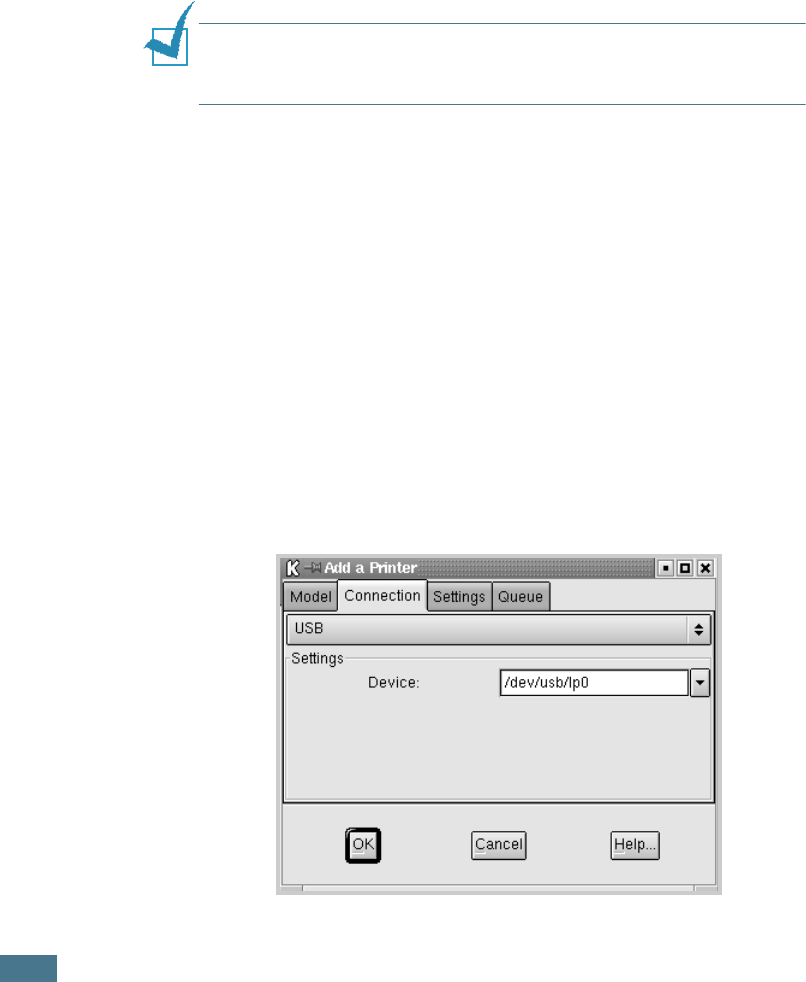
A
PPENDIX
7.14
Changing the Printer Connection Method
If you change the printer connection method from USB to
parallel or vice versa while in use, you must re-configure your
Linux printer by adding the printer in your system. Take the
following steps:
1
Make sure that you connect the printer to your computer.
Turn both the computer and the printer on.
2
When the Administrator Login window appears, type in
“root” in the Login field and enter the system password.
Note: You must log in as a super user (root) to install a new
printer to the printing system. If you are not, ask your system
administrator.
3
From the Startup Menu icon at the bottom of the desktop,
select Linux Printer and then Configuration Tool.
You can also access the Linux Printer Configuration
window by typing in “linux-config” from the Terminal
screen.
4
When the Linux Printer Configuration window appears,
click the Add Printer icon on the toolbar at the top of the
window.
5
Click the Connection tab at the top of the Add a Printer
window.
Ensure that the printer port is set properly. If not proper,
change the device setting.
6
Click OK.
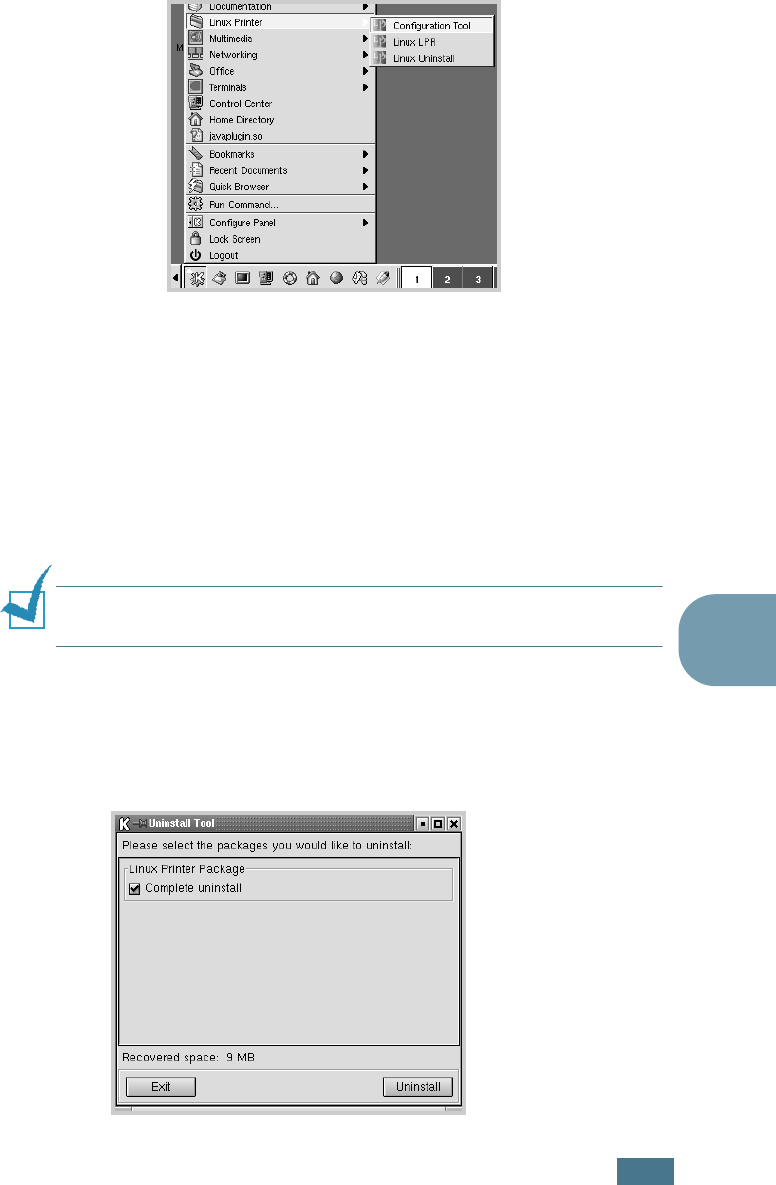
A
PPENDIX
7.15
7
Uninstalling the Printer Driver
1
From the Startup Menu icon at the bottom of the desktop,
select Linux Printer and then Configuration Tool.
You can also access the Linux Printer Configuration window
by typing in “linux-config” from the Terminal screen.
2
In the Linux Printer Configuration window, select the
Uninstall command from the File menu.
3
The Administrator Login window appears. Type in “root”
in the Login field and enter the system password. Click
Proceed.
Note: You must log in as a super user (root) to uninstall the
printer software. If you are not, ask your system administrator.
4
The message window which is asking your confirmation to
proceed with the uninstallation appears. Click Yes.
5
Select Complete uninstall and then click Uninstall.
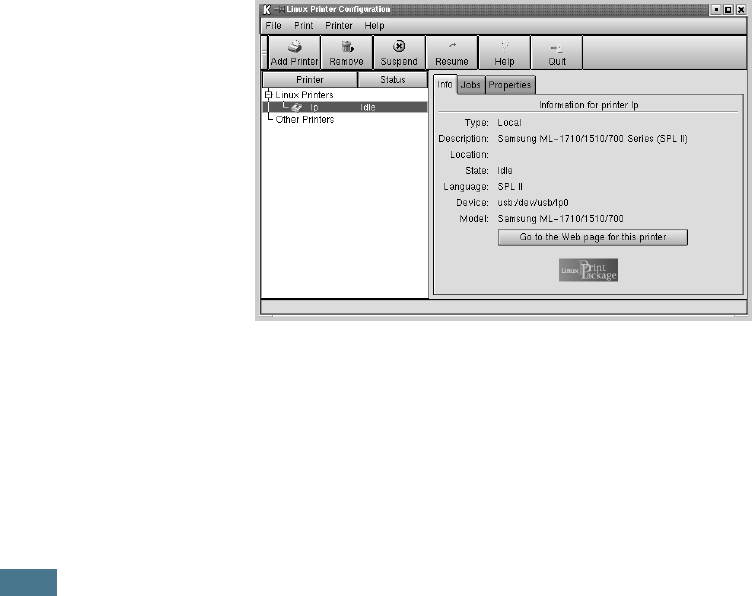
A
PPENDIX
7.16
6
Click OK to begin uninstallation.
7
When the uninstallation is completed, click Finished.
Using the Configuration Tool
The configuration tool allows the administrative tasks, including
adding and removing new printer, and changing their global
settings. Regular users can also run it to easily inspect job
queues, examine the printer properties and changing their local
preference.
To access the Configuration Tool:
1
From the Startup Menu icon at the bottom of the screen,
select Linux Printer and then Configuration Tool. The
Linux Printer Configuration window appears.
You can also open this window from the Terminal screen by
typing in “linux-config.”
2
The Linux Printer Configuration window shows a list of
installed printers at the left pane. The right pane shows a
number of tabs that display information regarding the
currently selected printer.
Select your printer, if not currently selected.
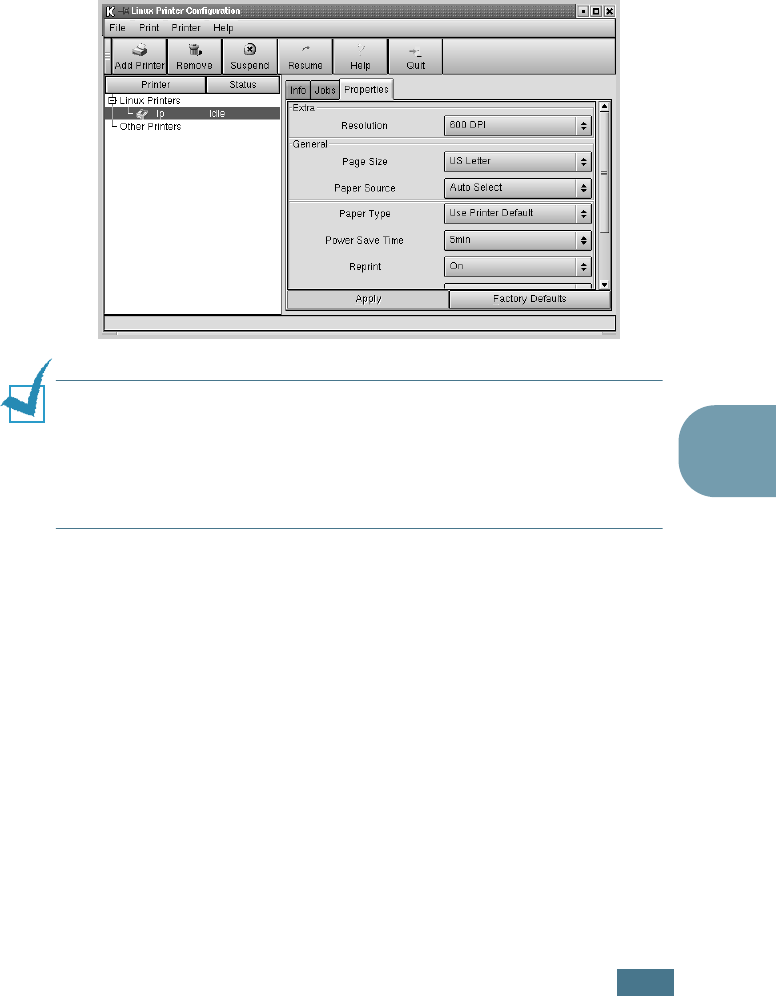
A
PPENDIX
7.17
7
3
The Info tab shows general information about the printer.
If you are an Internet user, you can click Go to the Web
page for this printer to access the Samsung web page.
Click the Job tab to inspect and manage the job queue for
the selected printer. You can suspend, resume or delete a
specific job(s) in the queue. If you drag a specific job(s),
you can drop it into the print queue of another printer.
The Properties tab allows you to change the default printer
settings.
Note: Regular users are able to override the system-wide default
settings defined by the administrator. When a regular user clicks
Apply, these custom settings will be saved in the user’s profile and
may be later used with LLPR. If the administrator is running the
configuration tool, then the settings will be saved as the new
global defaults.
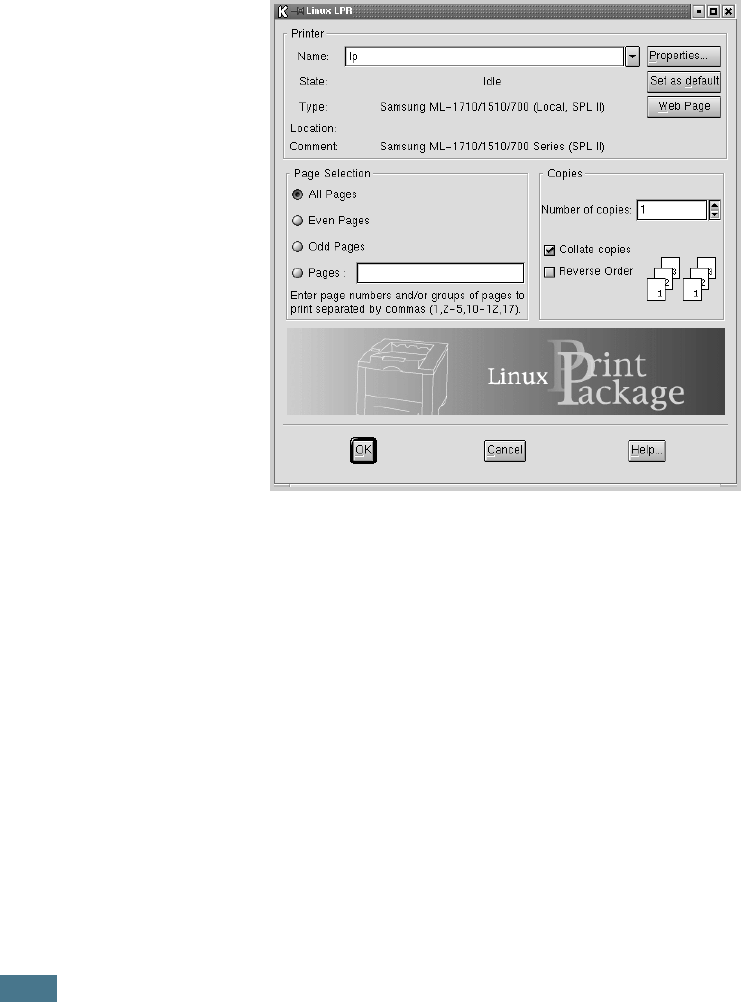
A
PPENDIX
7.18
Changing LLPR Properties
You can fine tune the printer’s properties by opening the LLPR
Properties window.
To open the LLPR Properties window:
1
From the application you are using, select the Print
command.
2
When the Linux LPR window opens, click Properties.
You can also open the LLPR window by using the following:
• Click the Startup Menu icon at the bottom of the screen
and select Linux Printer and then Linux LPR.
• If the Linux Printer Configuration window is currently
open, select Test Print from the Print menu.
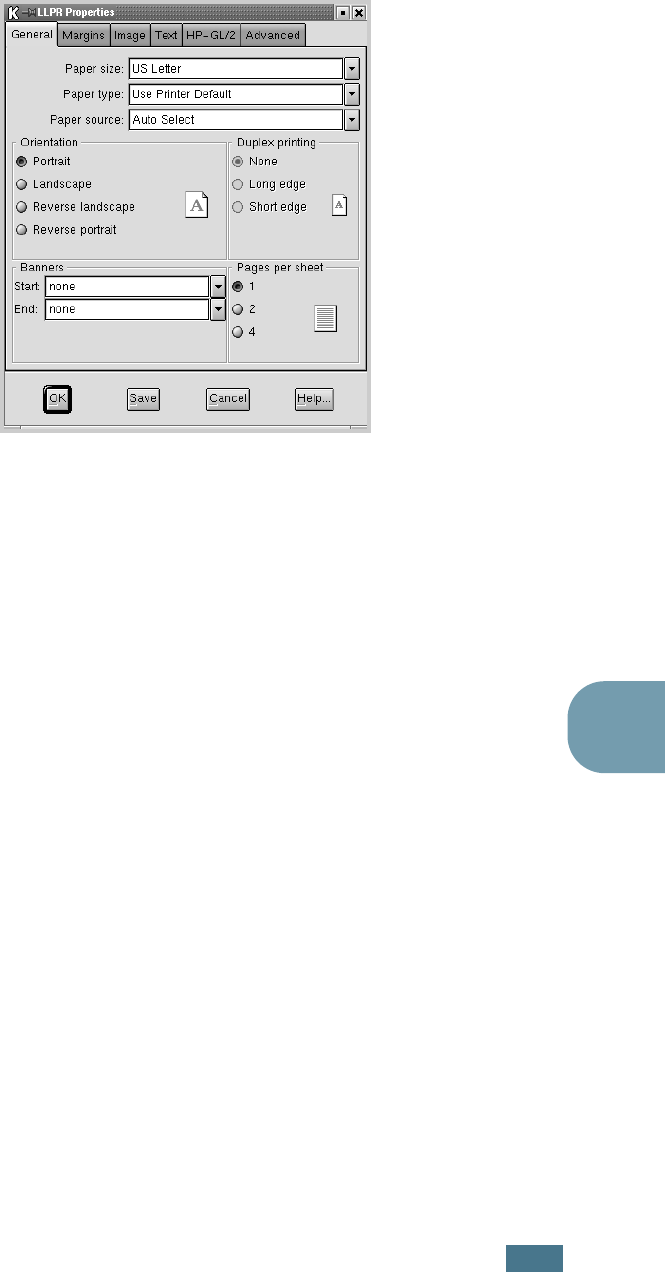
A
PPENDIX
7.19
7
3
The LLPR Properties window opens.
You will see the following six tabs at the top of the window:
•General - allows you to change the paper size, the paper
type, the paper source, the orientation of the documents,
enable duplex feature, add start and end banners, and
change the number of pages per sheet.
•Margins - allows you to specify the page margins. The
graphics on the right shows the current settings. These
margins do not apply when printing regular PostScript
data.
•Image - allows you to set image options that will be used
when printing images files, i.e. when a non-PostScript
document is passed to LLPR on the command line. But
color settings will also take effect for postscript
documents.
•Text - allows you to select the density of the text and
turn the syntax coloring on or off.
•HP-GL/2 - allows you to set default options to print
documents of the HP-GL/2 format, which is used by some
plotters.
•Advanced - allows you to override the default settings for
the printer.
If you click the Save button at the bottom of the window,
the options will be kept between LLPR session.
Use the Help button to view details about the options in the
window.
4
To apply the options, click OK in the LLPR Properties
window. You will return to the Linux LPR window. To start
printing, click OK.
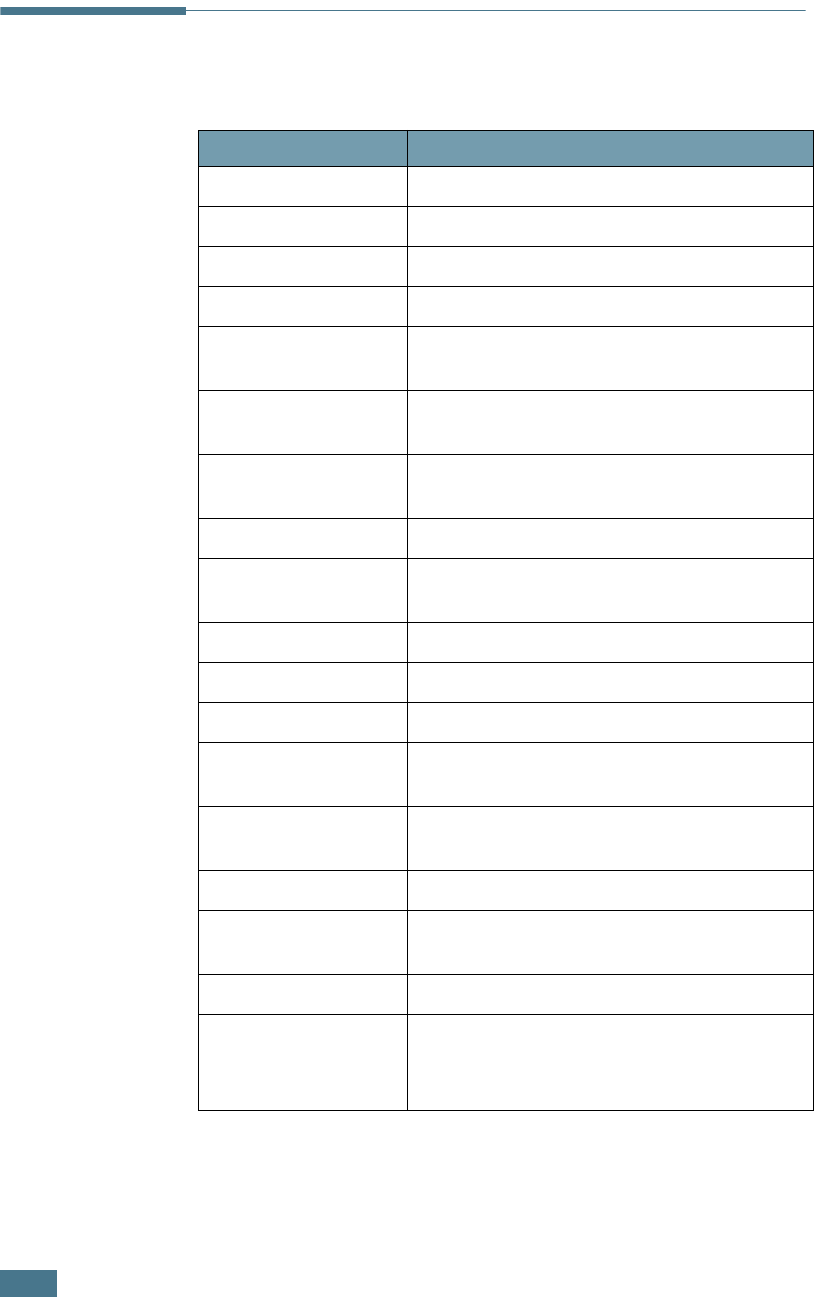
A
PPENDIX
7.20
Printer Specifications
Item Specifications and Description
Print Speed 16 PPM (A4), 17 PPM (Letter)
Resolution 600 x 600 dpi
First Printing Time Less than 12 seconds
Warmup Time 30 seconds
Power Rating AC 100 ~ 127 V (USA, Canada) /
220 ~ 240 V (Others), 50 / 60 Hz
Power Consumption 280 W average during operation /
Less than 10 W in sleep mode
Acoustic Noise Stand by: Less than 35 dB;
Operating: Less than 50 dB
Toner Supply Single cartridge
Toner Cartridge Life 3,000 pages (for starter, 1,000 pages),
IDC 5% coverage
Duty Cycle Monthly: 15,000 pages maximum
Weight 7 Kg
Package Weight Paper: 1.76 Kg, Plastic: 0.2 Kg
External Dimensions
(W x D x H)
352 x 372 x 196 mm /
13.8 x 14.6 x 7.7 in.
Operating
Environment
Temperature:10 ~ 32 °C / 50 ~ 90 °F;
Humidity: 20 ~ 80 % RH
Emulation SPL
Random Access
Memory (RAM) 8 MB (nonexpandable)
Fonts Windows font
Interface
USB Interface Standard
- USB 1.1 compliant
- 12 Mbps 1 port
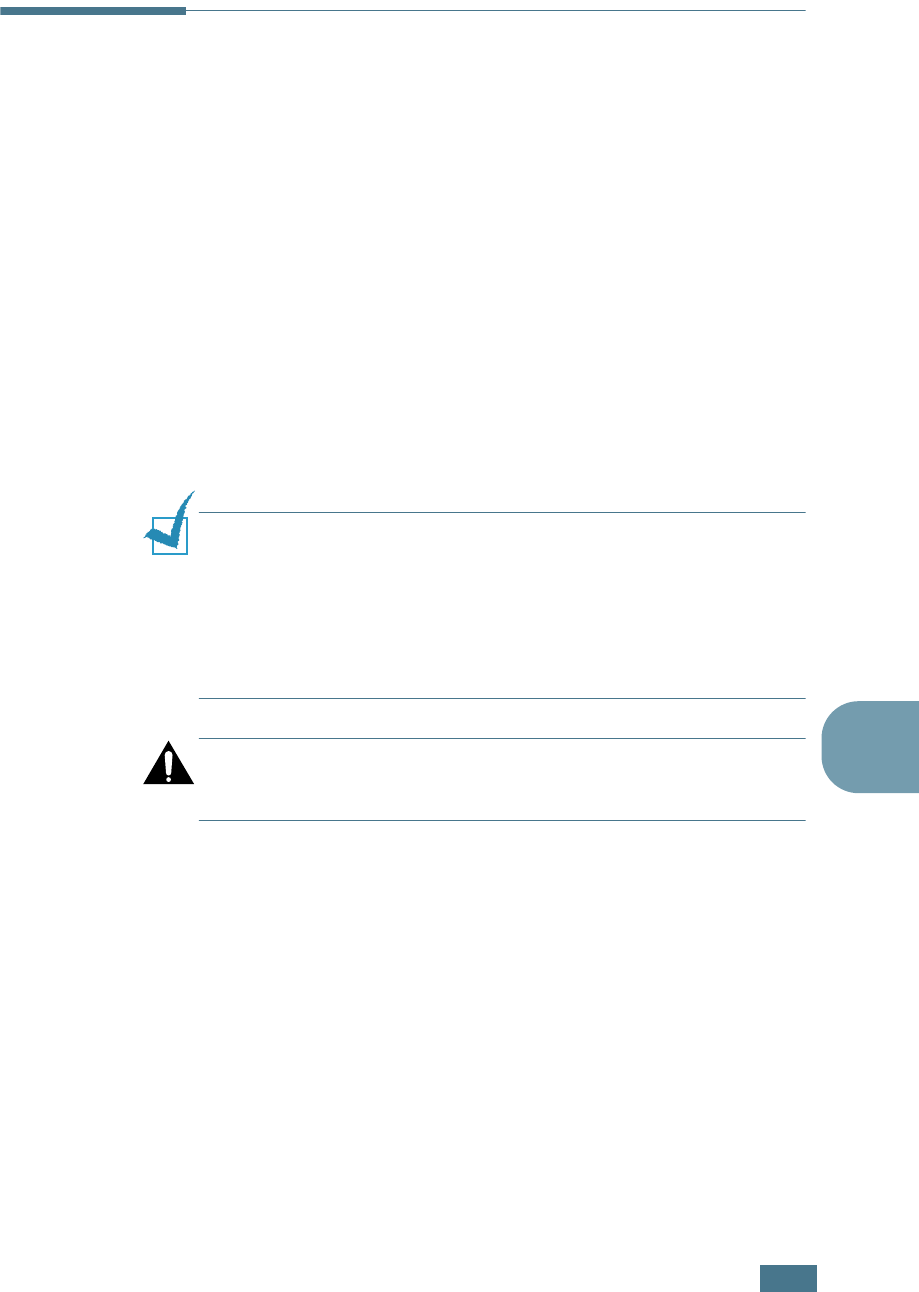
A
PPENDIX
7.21
7
Paper Specifications
Overview
Your printer accepts a variety of print materials, such as cut-
sheet paper (including up to 100% recycled fiber content
paper), envelopes, labels, transparencies and custom-size
paper. Properties, such as weight, composition, grain and
moisture content, are important factors affecting the printer’s
performance and the output quality. Paper that does not meet
the guidelines outlined in this User’s Guide can cause the
following problems:
• Poor print quality
• Increased paper jams
• Premature wear on the printer.
Notes:
• Some paper may meet all of the guidelines in this guide and still
not produce satisfactory results. This may be the result of
improper handling, unacceptable temperature and humidity
levels, or other variables over which Samsung has no control.
• Before purchasing large quantities of paper, insure the paper
meets the requirements specified in this User’s Guide.
CAUTION: Using paper that does not meet these specifications
may cause problems, requiring repairs. These repairs are not
covered by the Samsung warranty or service agreements.
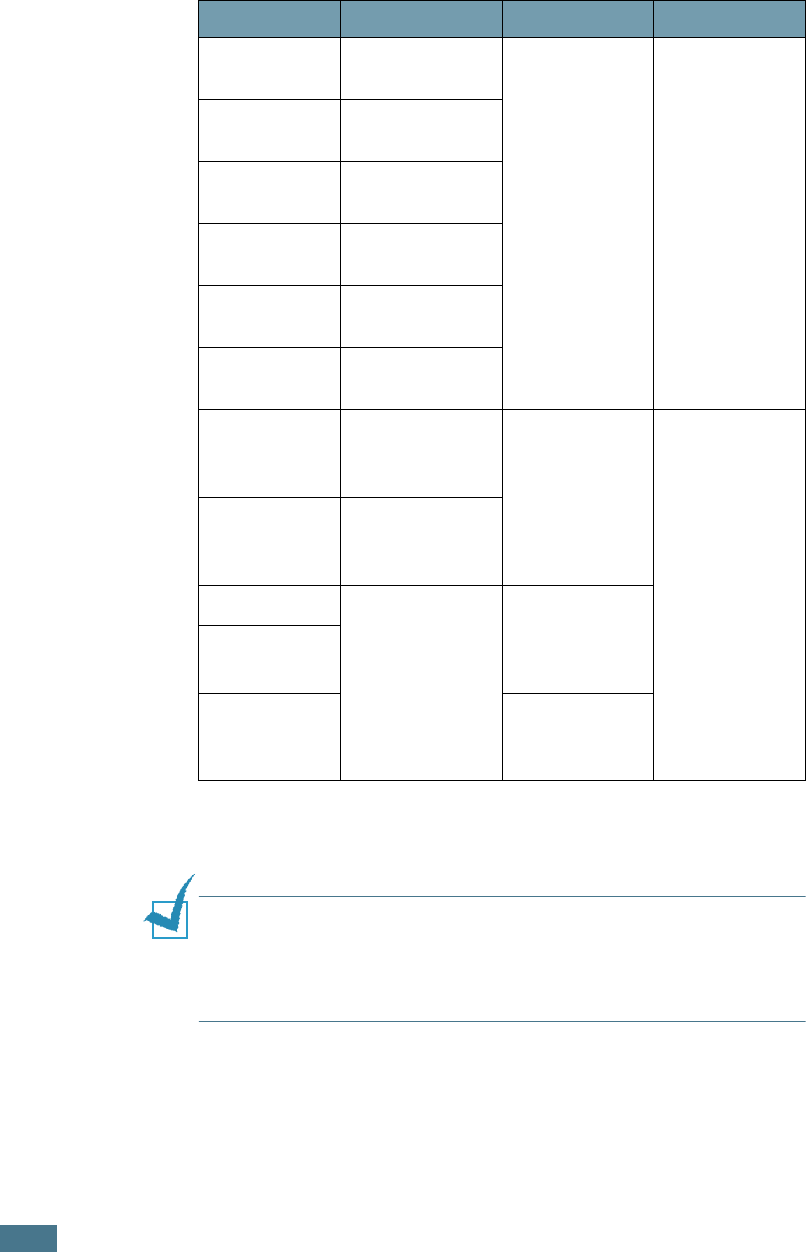
A
PPENDIX
7.22
Supported Sizes of Paper
Note: You may experience jams when using print materials with a
length of less than 127 mm (5 in.). For optimum performance,
ensure that you are storing and handling the paper correctly.
Please refer to “Printer and Paper Storage Environment” on
page 7.25.
Paper Dimensions
a
a.The printer supports a wide range of media sizes. See “Printing on Card Stock
or Custom-sized Materials” on page 3.15.
Weight Capacity
b
b.Capacity may vary depending on media weight and thickness, and environ-
mental conditions.
Letter
8.5 X 11 in.
(216 X 279 mm)
60 to 90 g/m
2
bond (16 to
24 lb)
• 250 sheets of
75 g/m
2
bond (20 lb)
paper for the
tray
• 1 sheet of
paper for the
manual
feeder
A4
210 X 297 mm
(8.3 X 11.7 in.)
Executive
7.25 X 10.5 in.
(191 X 267 mm)
Legal
8.5 X 14 in.
(216 X 356 mm)
B5 (JIS)
182 X 257 mm
(7.2 X 10 in.)
Folio
216 X 330 mm
(8.5 X 13 in.)
Minimum
size
(custom)
76 x 127 mm
(3 x 5 in) 60 to 163 g/m
2
bond (16 to
43 lb)
1 sheet of
paper for the
manual feeder
Maximum
size
(custom)
216 x 356mm
(8.5 x 14 in)
Transparency
Same minimum
and maximum
paper sizes as
listed above.
Thickness:
0.10 X .14 mm
(0.0039 X
0.0055 in.)
Labels
Envelopes
up to 90 g/m
2
bond (16 to
24 lb)
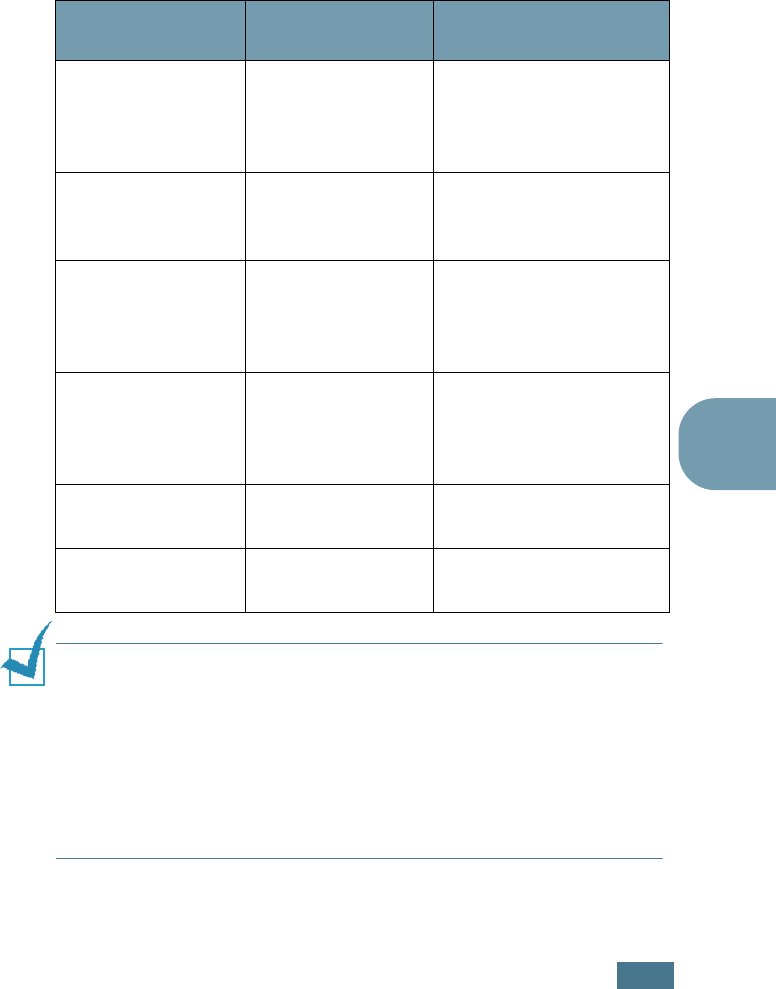
A
PPENDIX
7.23
7
Guidelines for Using Paper
For the best result, use conventional 75 g/m
2
(20 lb) paper.
Ensure that the paper is of good quality, and free of cuts, nicks,
tears, spots, loose particles, dust, wrinkles, voids, and curled or
bent edges.
If you are unsure of what type of paper you are loading (such
as, bond or recycled), check the label on the package.
The following problems may cause print quality deviations,
jamming or even damage to the printer.
Notes:
• Do not use letterhead paper printed with low-temperature inks,
such as those used in some types of thermography.
• Do not use raised or embossed letterhead.
• The printer uses heat and pressure to fuse toner to the paper.
Insure that any colored paper or preprinted forms use inks that
are compatible with this fusing temperature (200 °C or 392 °F
for 0.1 second).
Symptom Problem with
Paper Solution
Poor print quality
or toner adhesion,
problems with
feeding
Too moist, too
rough, too smooth
or embossed;
faulty paper lot
Try another kind of
paper, between 100 ~
250 Sheffield, 4 ~ 5 %
moisture content.
Dropout,
jamming, curl Stored improperly
Store paper flat in its
moisture-proof
wrapping.
Increased gray
background
shading/printer
wear
Too heavy Use lighter paper, open
the rear output tray.
Excessive curl
problems with
feeding
Too moist, wrong
grain direction or
short-grain
construction
• Open the rear output
tray.
• Use long-grain paper.
Jamming, damage
to printer
Cutouts or
perforations
Do not use paper with
cutouts or perforations.
Problems with
feeding Ragged edges Use good quality paper.
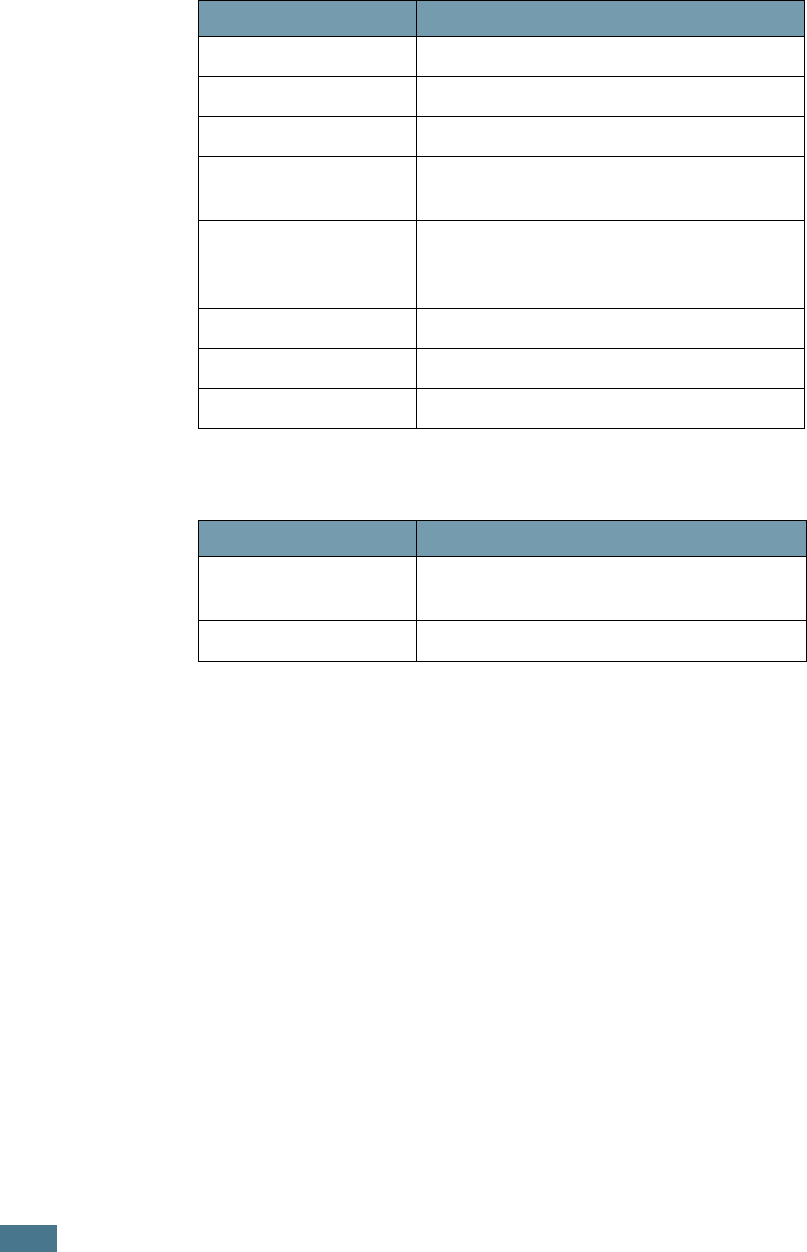
A
PPENDIX
7.24
Paper Specifications
Paper Output Capacity
Category Specifications
Acid Content 5.5 ~ 8.0 pH
Caliper 0.094 ~ 0.18 mm (3.0 ~ 7.0 mils)
Curl in Ream Flat within 5 mm (0.02 in.)
Cut Edge Conditions Cut with sharp blades with no visible
fray.
Fusing Compatibility
Must not scorch, melt, offset, or release
hazardous emissions when heated to
200 °C (392 °F) for 0.1 second.
Grain Long Grain
Moisture Content 4 % ~ 6 % by weight
Smoothness 100 ~ 250 Sheffield
Output Tray Capacity
Face-down output
tray 50 sheets of 75 g/m
2
bond (20 lb) paper
Face-up output slot 1 sheet of 75 g/m
2
bond (20 lb) paper

A
PPENDIX
7.25
7
Printer and Paper Storage Environment
Paper storage environmental conditions directly affect the feed
operation.
Ideally, the printer and paper storage environment should be at
or near room temperature, and not too dry or humid. Remember
that paper is hygroscopic; it absorbs and loses moisture rapidly.
Heat works with humidity to damage paper. Heat causes the
moisture in paper to evaporate, while cold causes it to condense
on the sheets. Heating systems and air conditioners remove
most of the humidity from a room. As paper is opened and used,
it loses moisture, causing streaks and smudging. Humid
weather or water coolers can cause the humidity to increase in
a room. As paper is opened and used it absorbs any excess
moisture, causing light print and dropouts. Also, as paper loses
and gains moisture it can become distorted. This can cause
paper jams.
Care should be taken not to purchase more paper than can be
used in a short time (about 3 months). Paper stored for long
periods may experience heat and moisture extremes, which can
cause damage. Planning is important to prevent damage to
large supplies of paper.
Unopened paper in sealed reams can remain stable for several
months before use. Opened packages of paper have more
potential for environment damage, especially if they are not
wrapped with a moisture-proof barrier.
The paper storage environment should be properly maintained
to ensure optimum printer performance. The required condition
is 20° to 24°C (68° to 75°F), with a relative humidity of 45% to
55%. The following guidelines should be considered when
evaluating the paper’s storage environment:
• Paper should be stored at or near room temperature.
• The air should not be too dry or too humid.
• The best way to store an opened ream of paper is to rewrap it
tightly in its moisture-proof wrapping. If the printer
environment is subject to extremes, unwrap only the amount
of paper to be used during the day’s operation to prevent
unwanted moisture changes.

A
PPENDIX
7.26
N
OTE

1
INDEX
C
cancel, print
4.4
clean, printer
5.5
cleaning sheet, print
5.7
connect
parallel cable
2.9
power cord
2.10
USB cable
2.9
control panel,use
1.6
D
demo page, print
2.11
document, print
4.2
E
error, solve
6.17
I
install
software
2.14
toner
2.4
L
language, change
2.18
load paper
3.7
O
output tray, select
3.5
overlay
create
4.22
delete
4.25
print
4.24
P
paper jams, clear
6.7
paper load
in manual feeder
3.8
in tray
2.6, 3.7
paper size
3.3
paper, capacity
3.3
paper, guidelines
3.4
print
cleaning sheet
5.7
demo page
2.11
document
4.2
fit to page
4.13
N-up
4.10
overlay
4.22
poster
4.14
scale
4.12
watermark
4.19
printer cable, connect
2.9
printer, clean
5.5
printer, sharing
4.28
problem
Linux
6.20
Macintosh
6.19
windows
6.18

2
S
setting
darkness
4.16
favorite
4.5
image mode
4.16
paper size
4.6
paper source
4.6
paper type
4.6
resolution
4.16
toner save
4.16
true-type option
4.16
software
install
2.14
Linux
7.10
Macintosh
7.2
overview
2.12
reinstall
2.15
system requirements
2.14
uninstall
2.17
specification
paper
7.21
printer
7.20
status monitor, use
4.26
T
toner
install
2.4
life
5.2
recycle
5.2
redistribute
5.3
replace
5.4
toner save
4.8
W
watermark
create
4.20
delete
4.21
edit
4.21
print
4.19

Home
Visit us at:
www.samsungprinter.com Rev.1.00